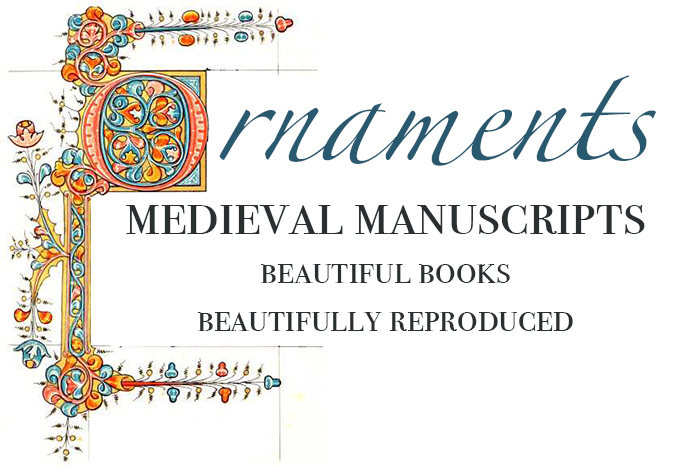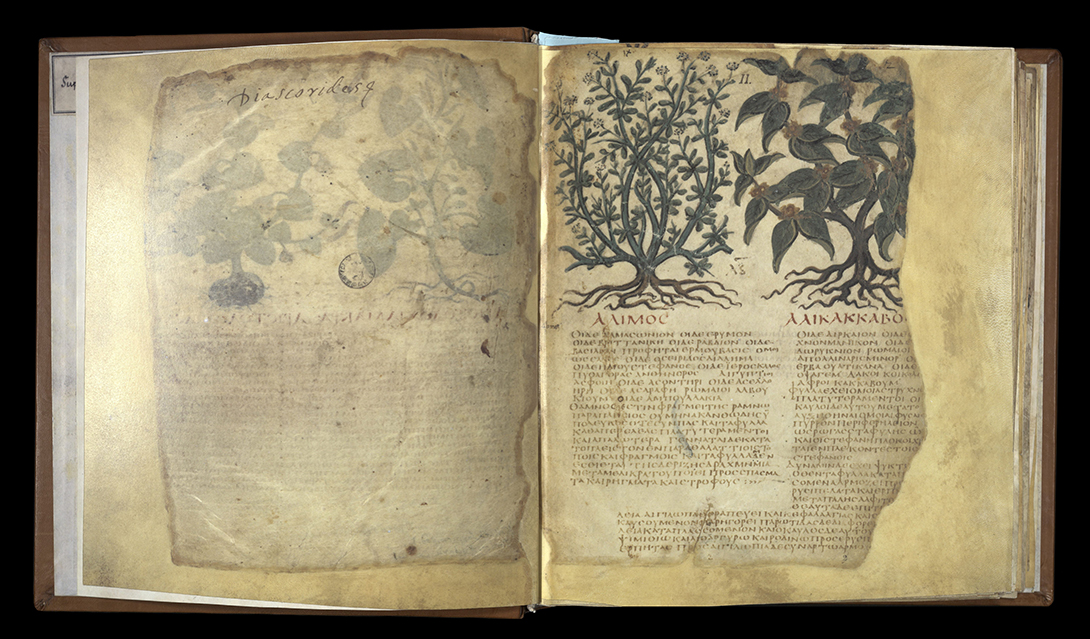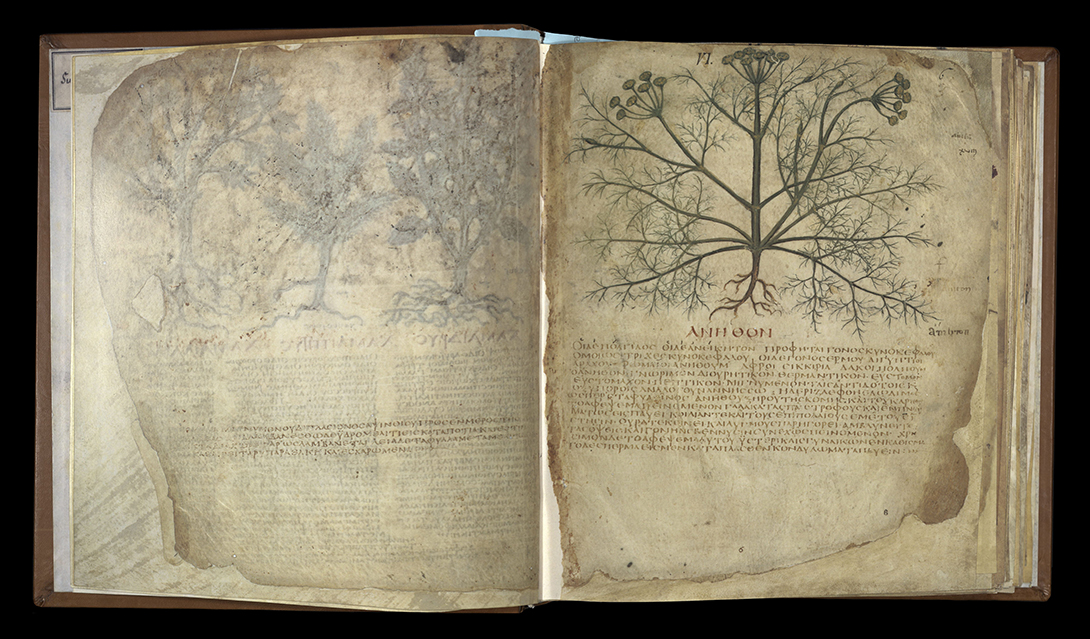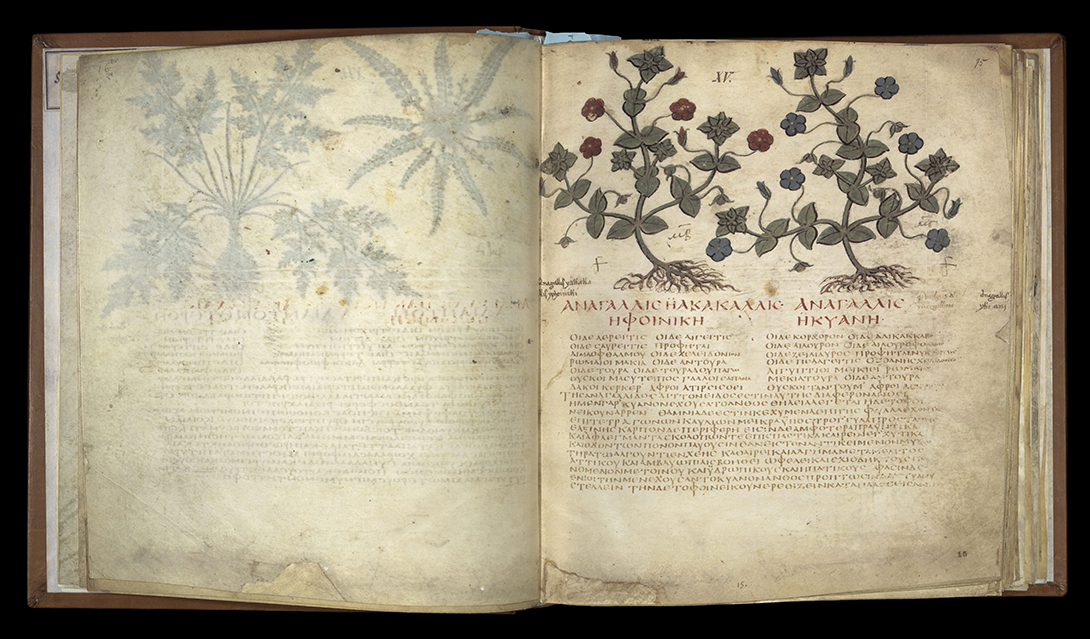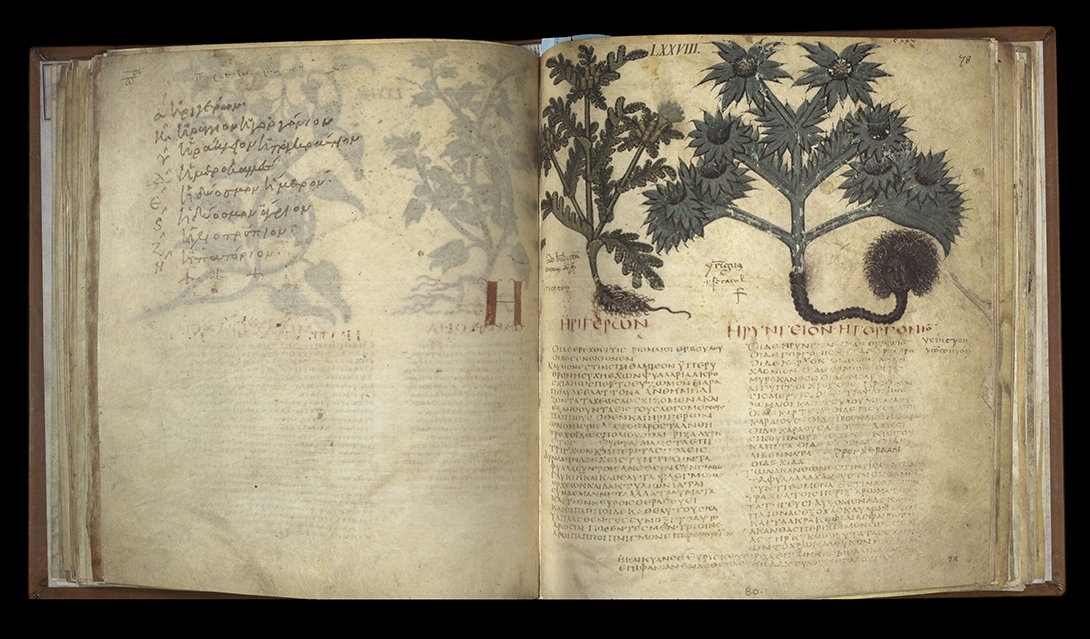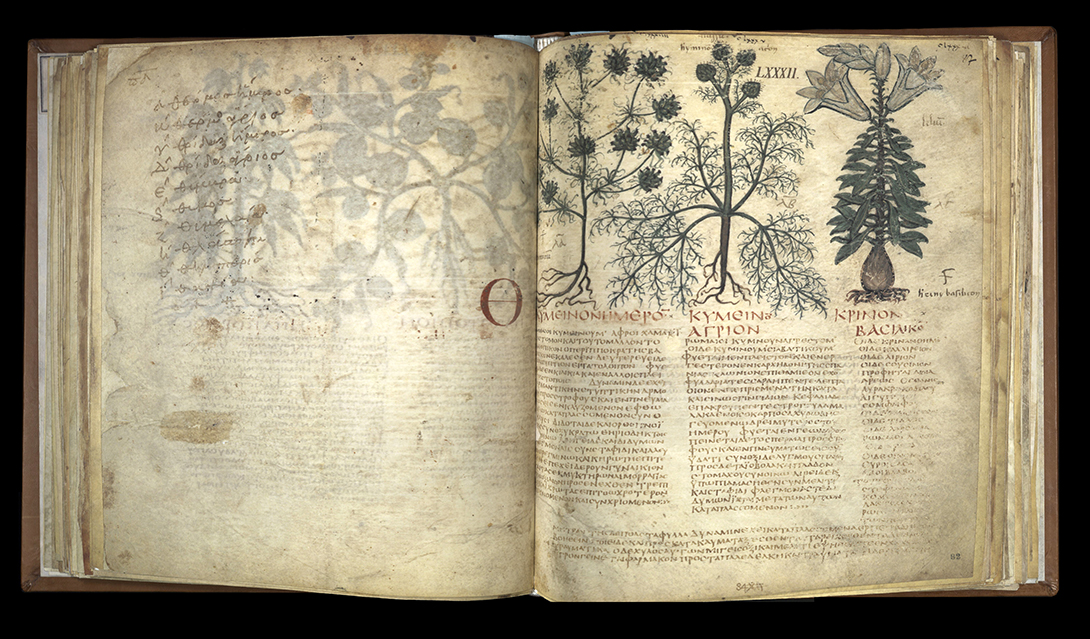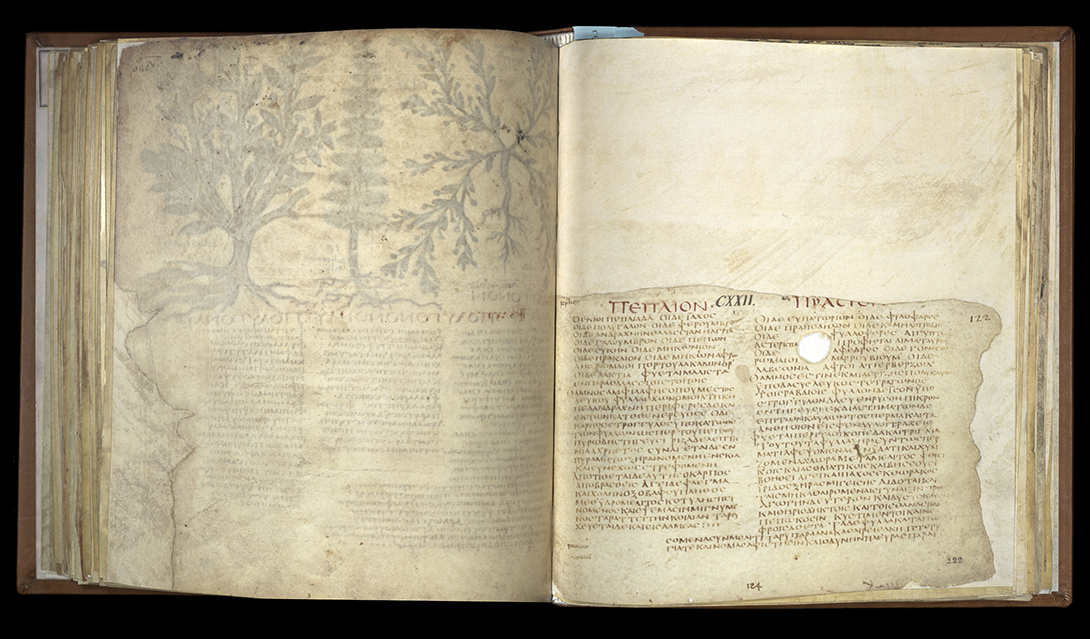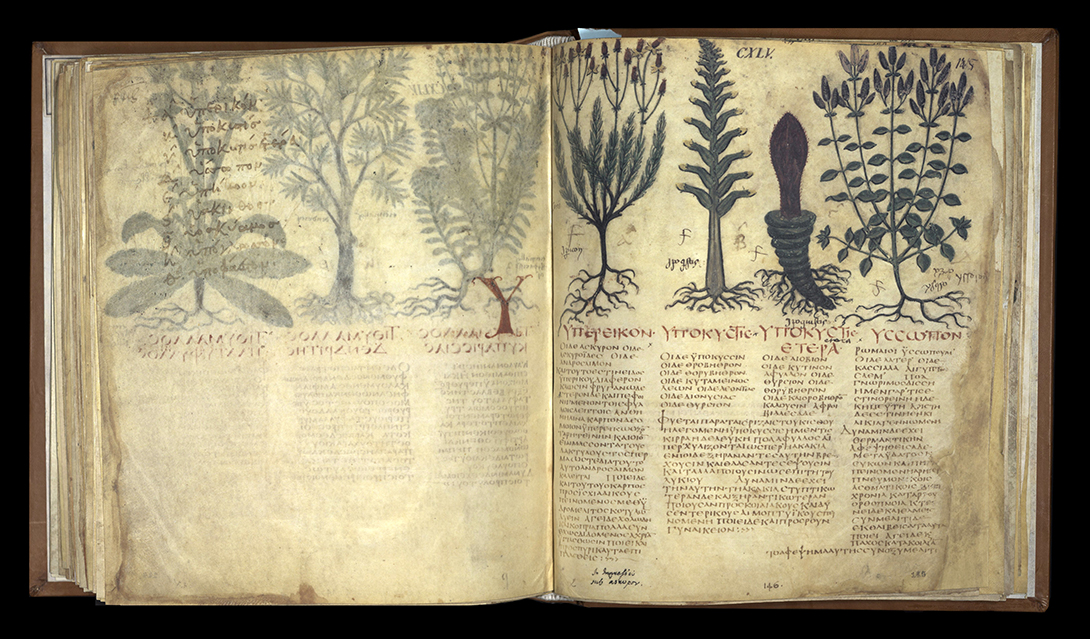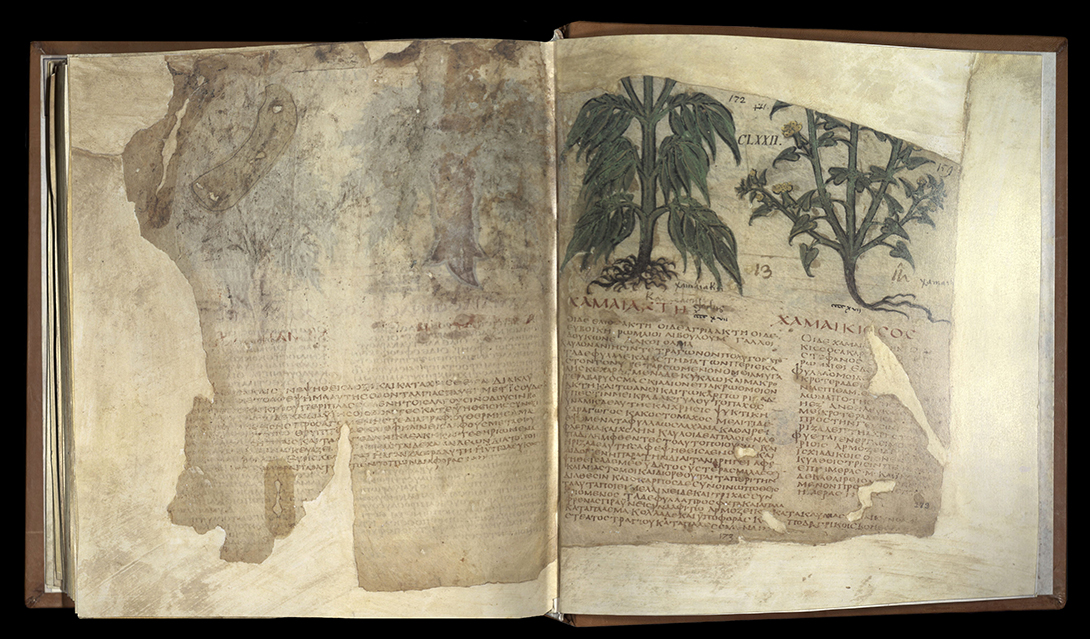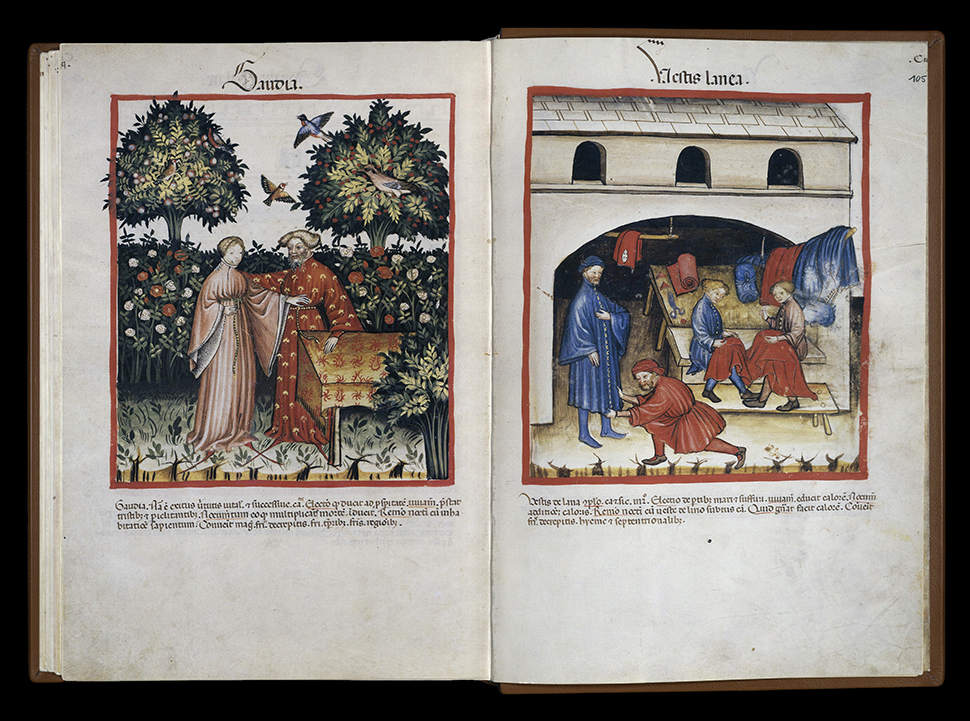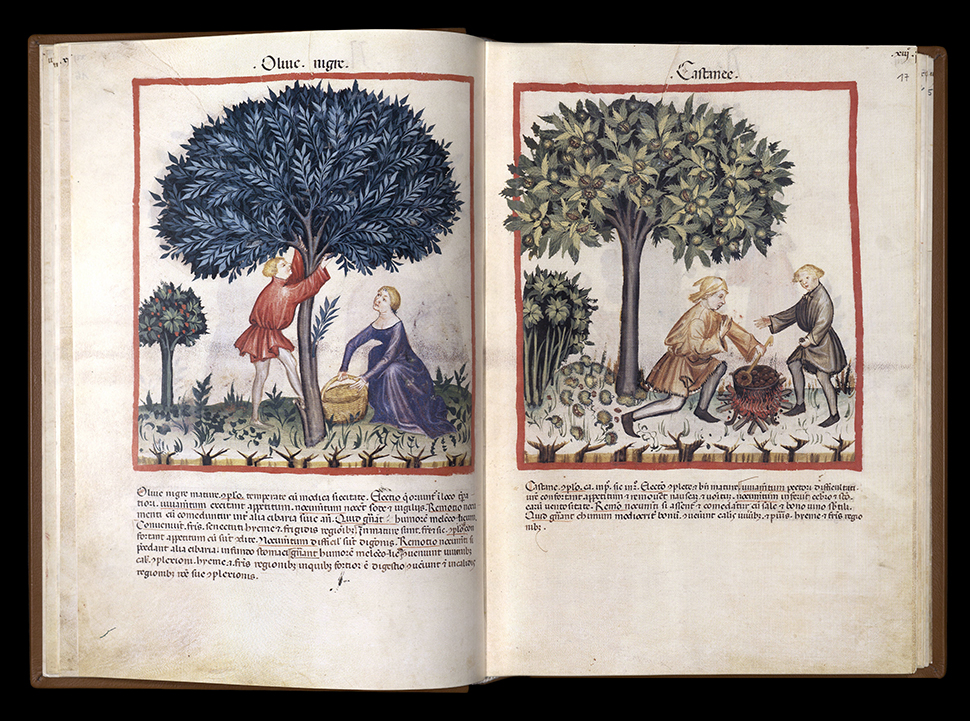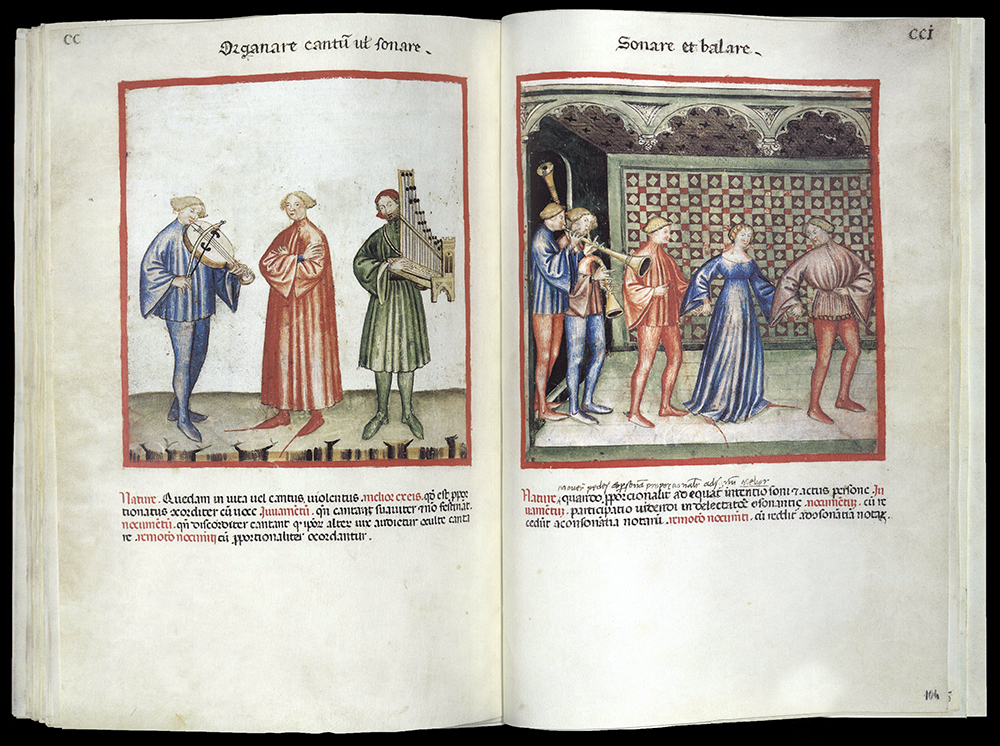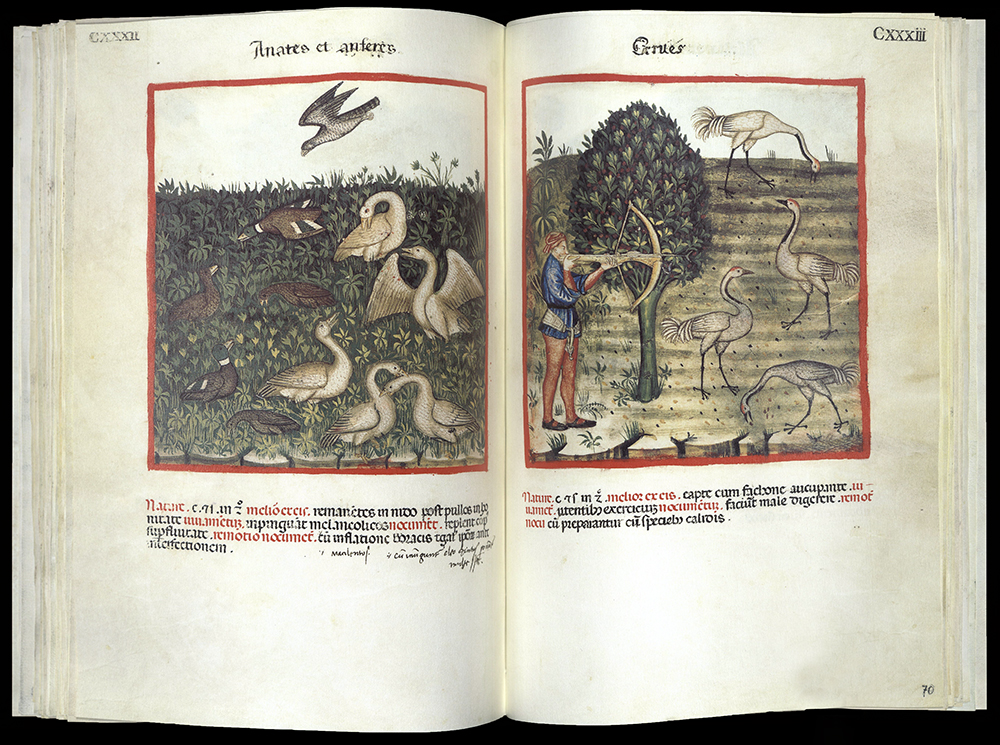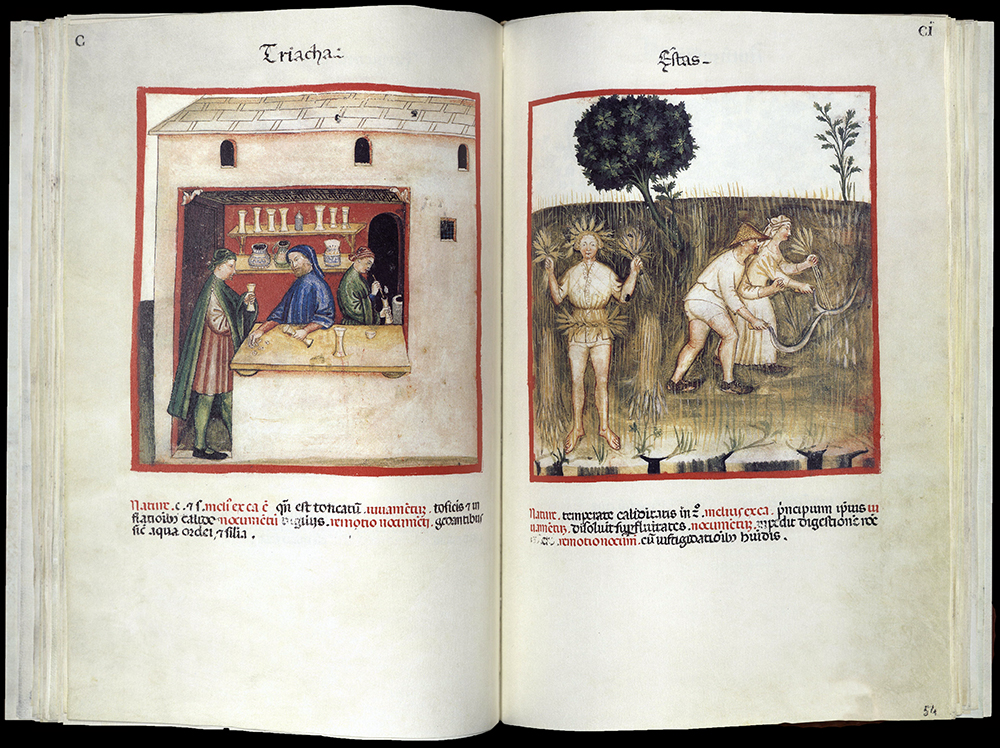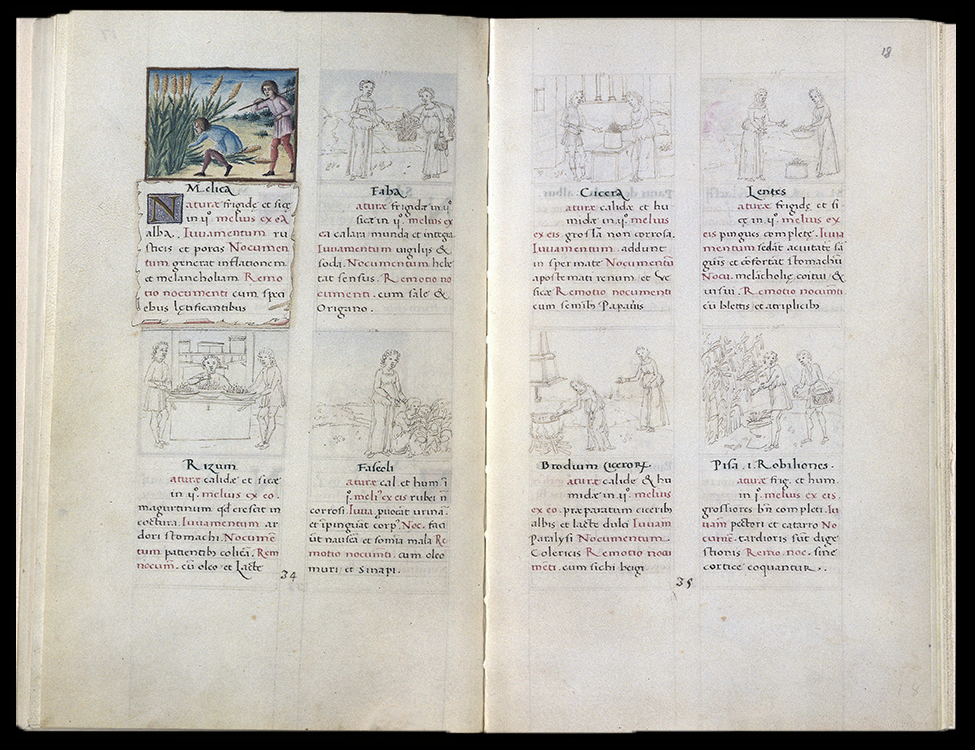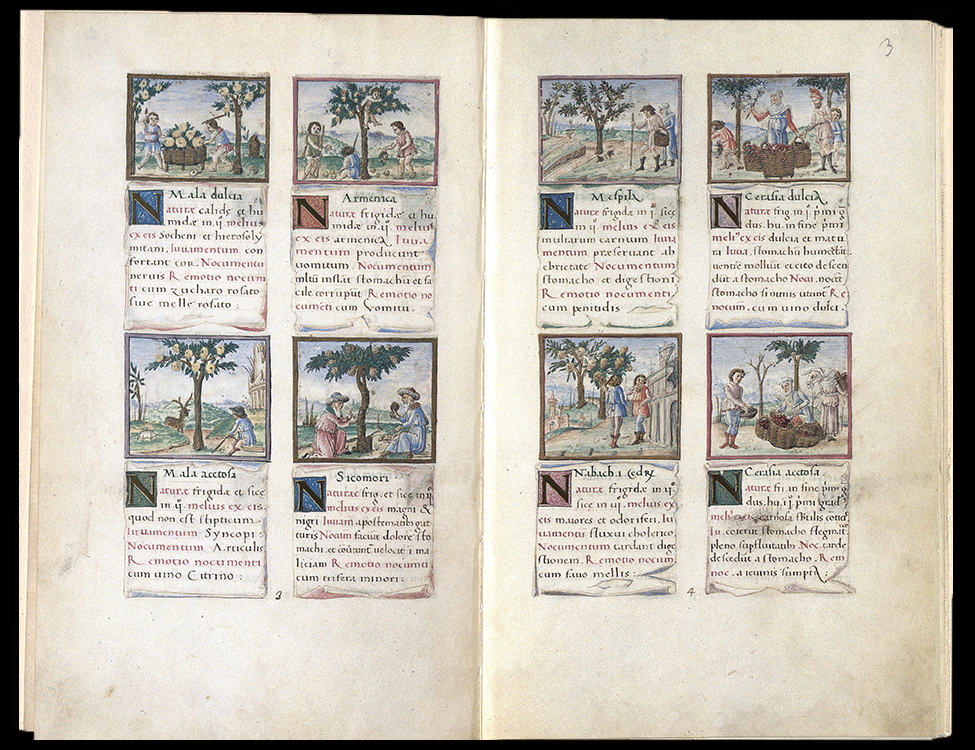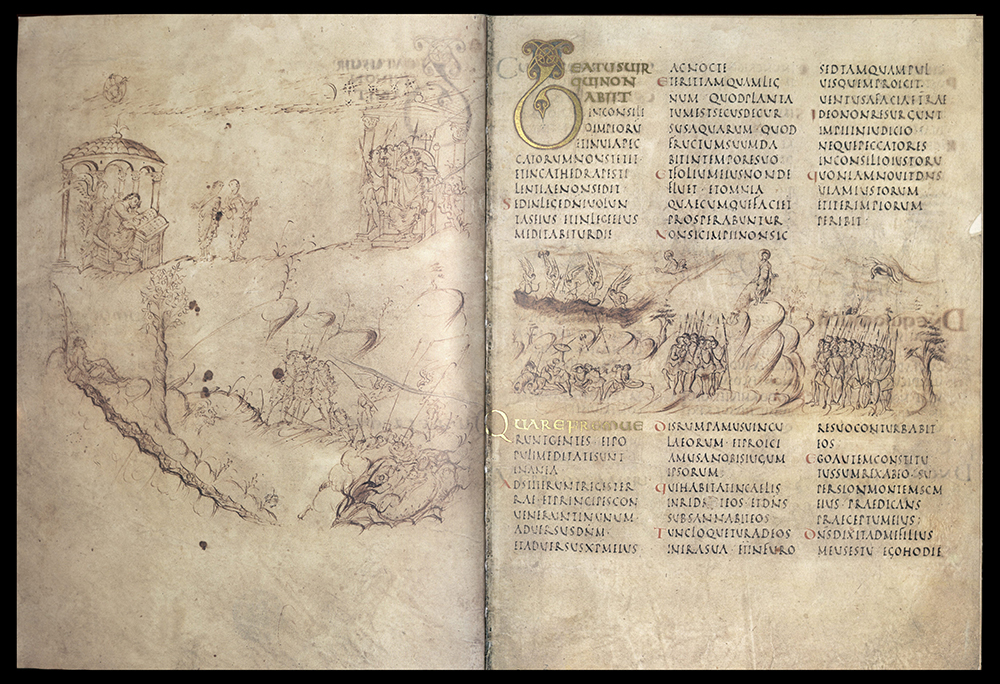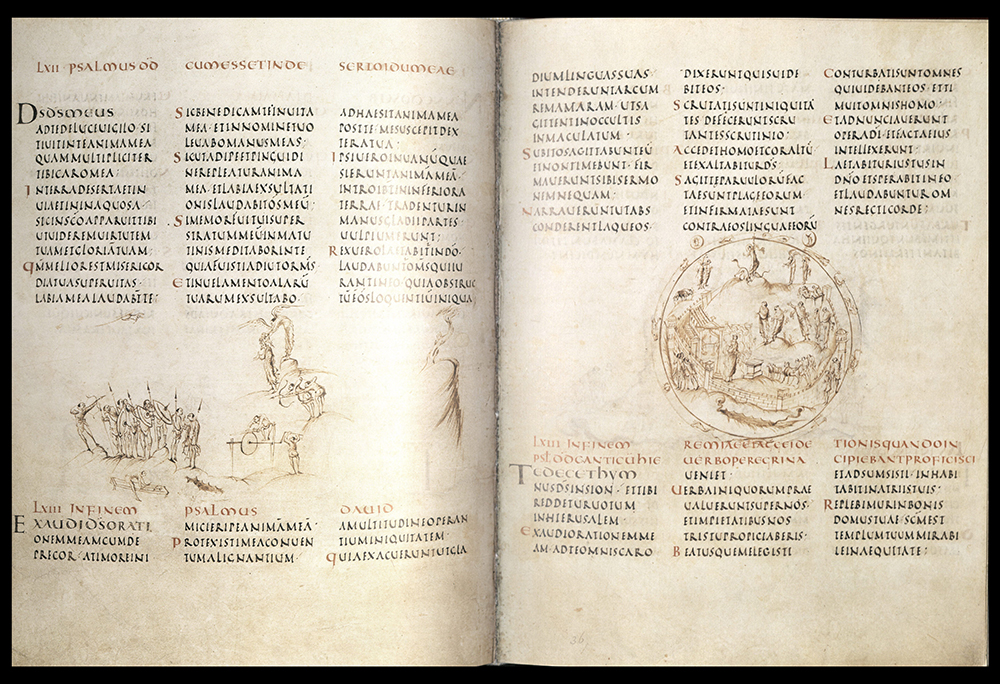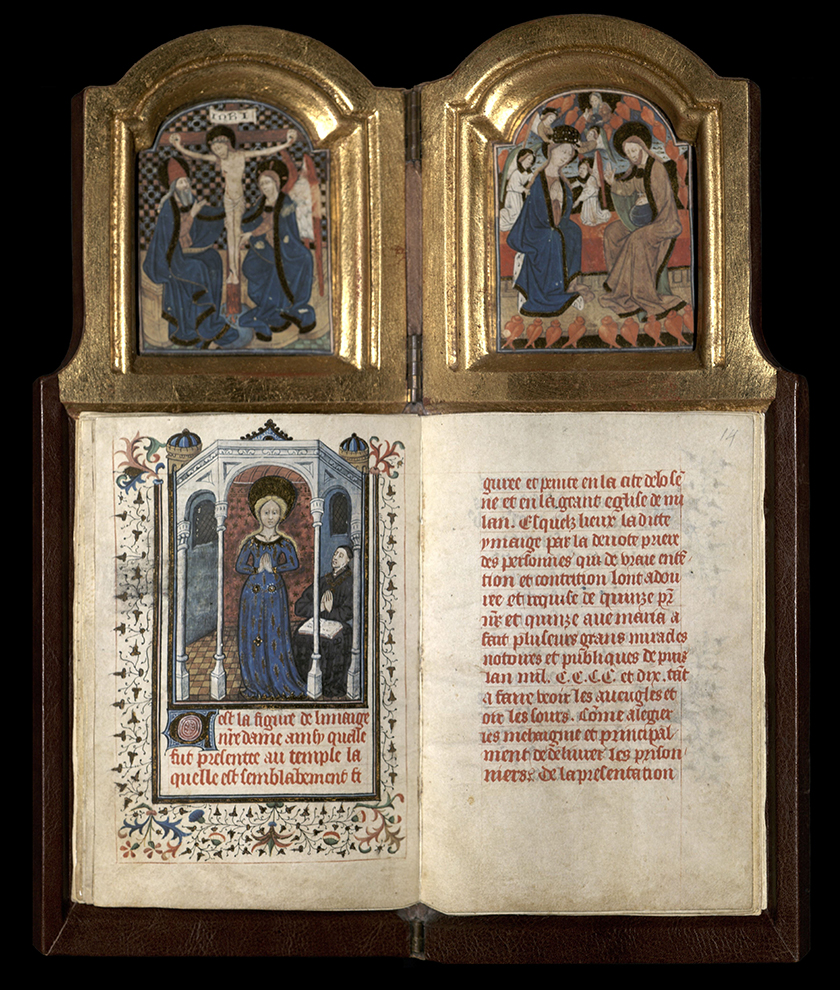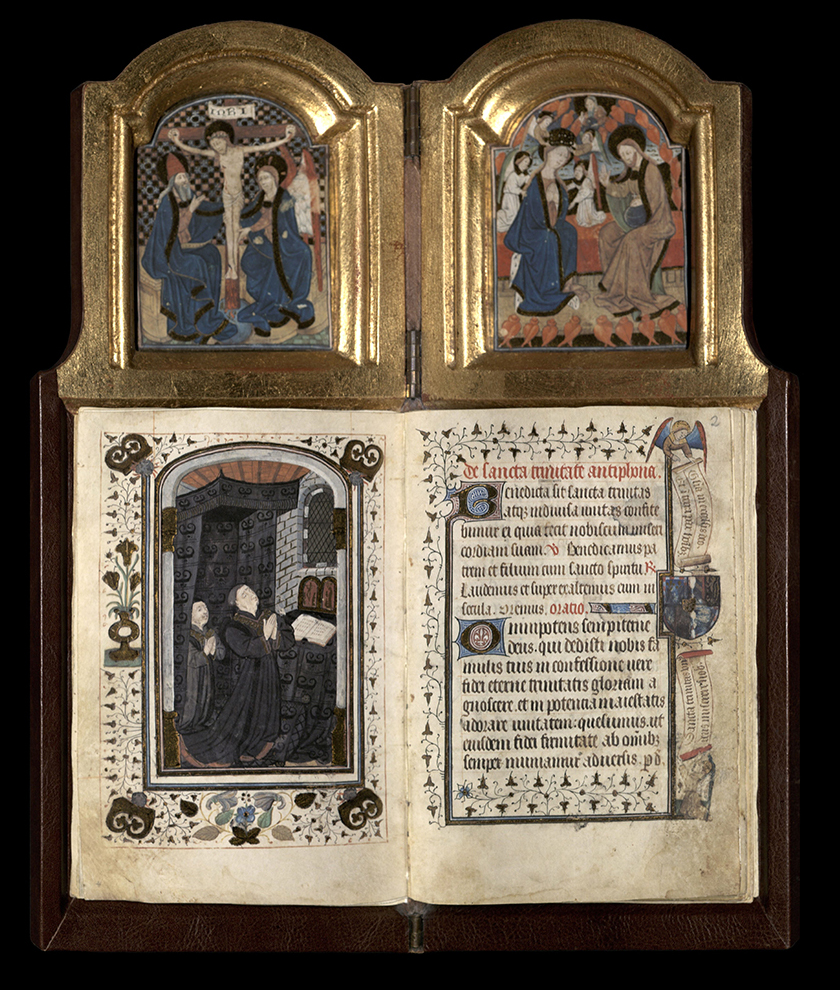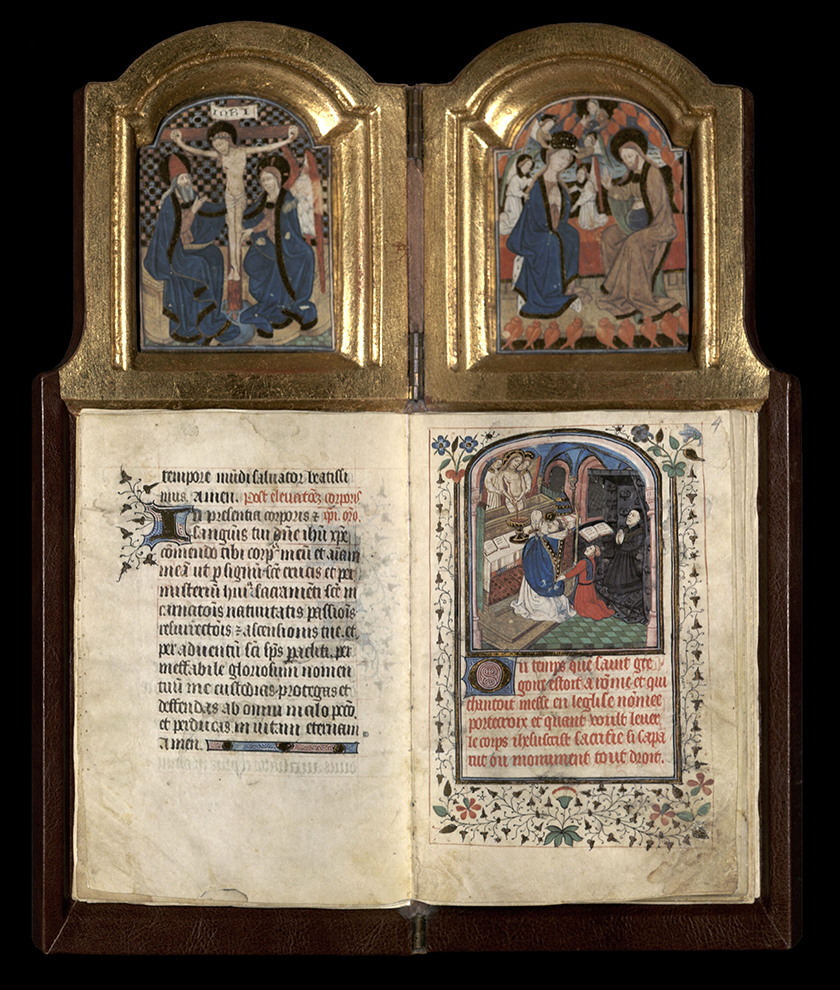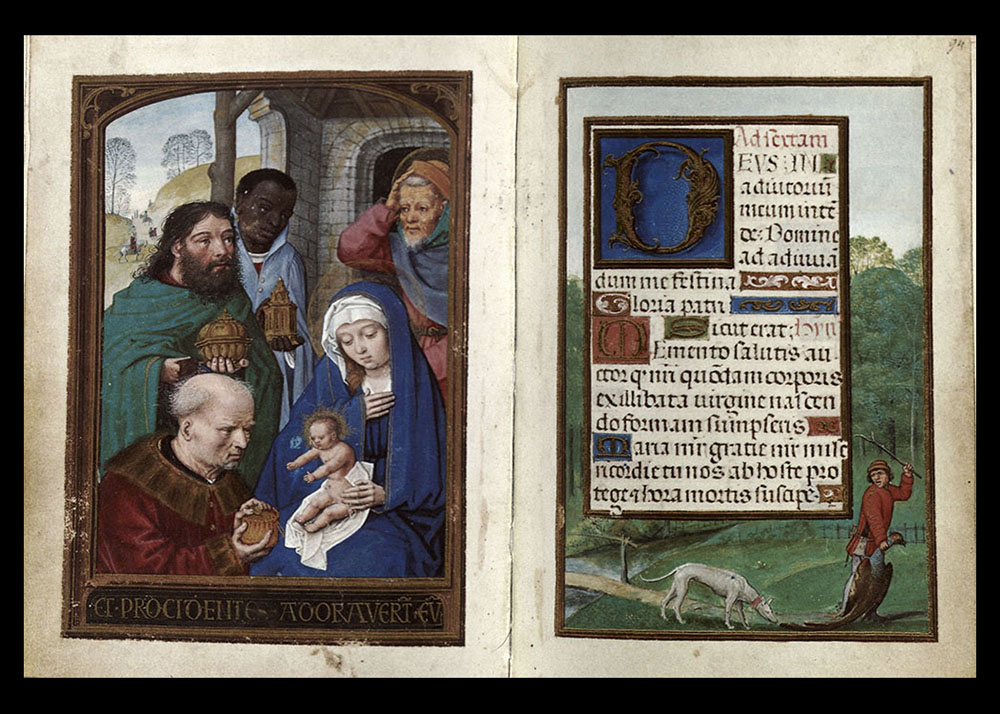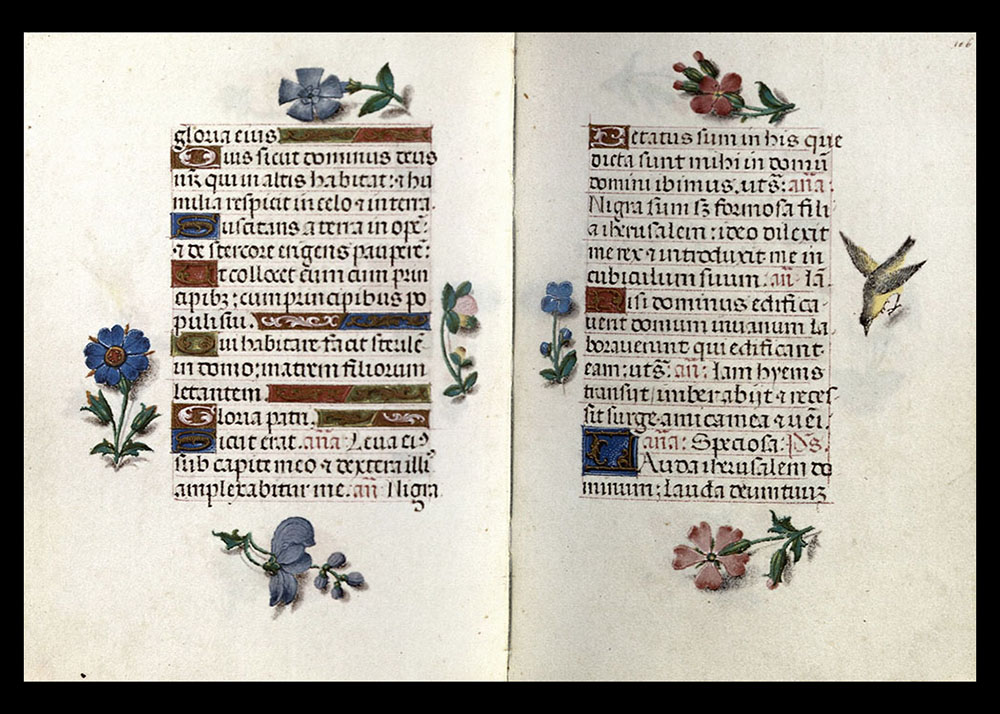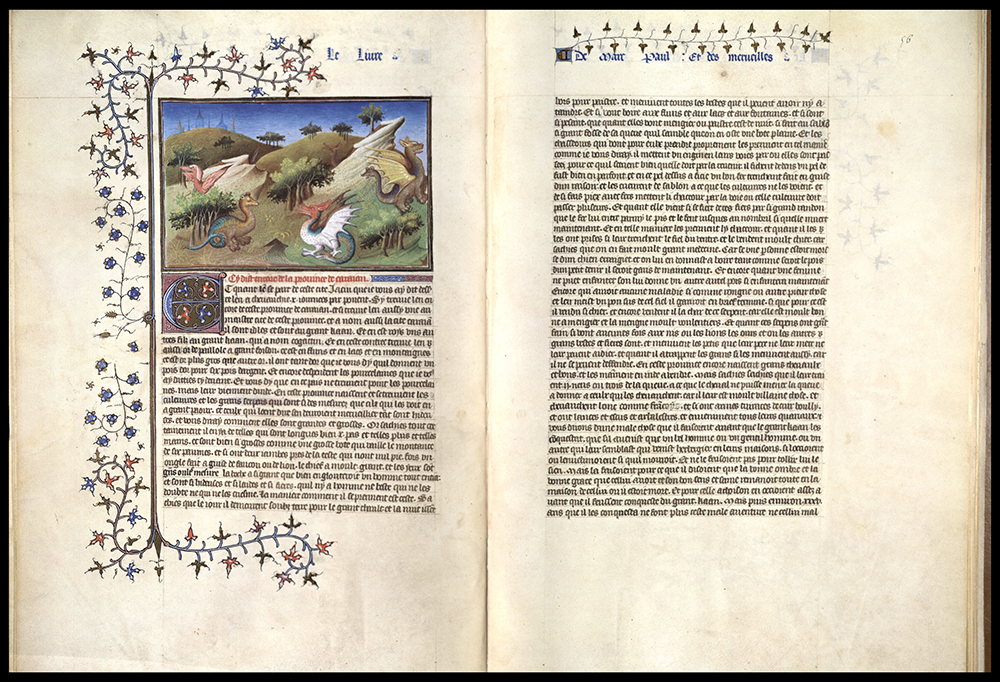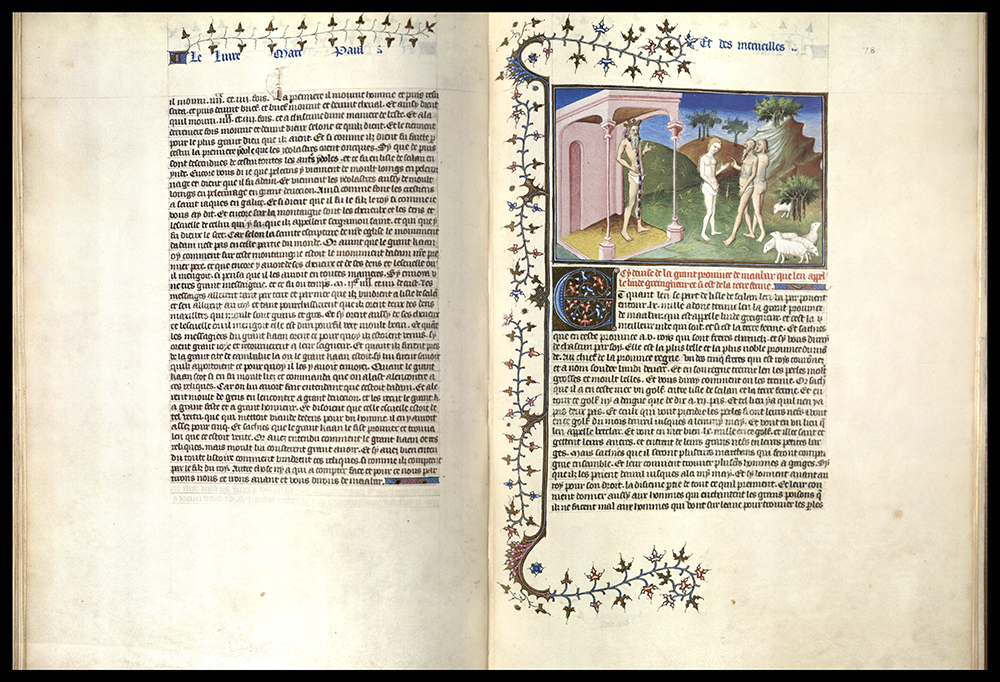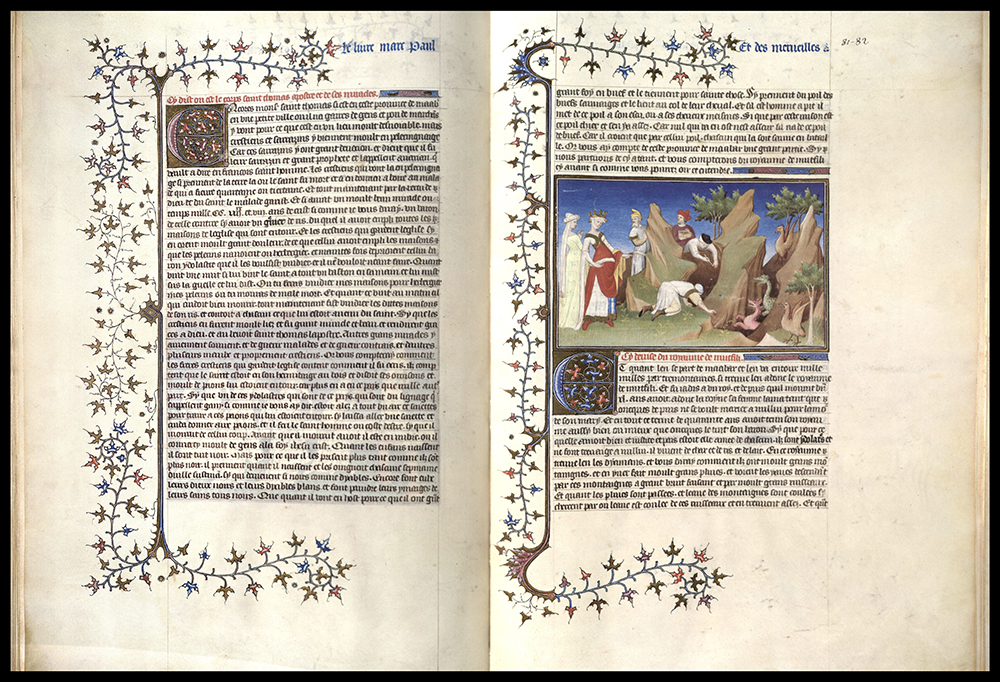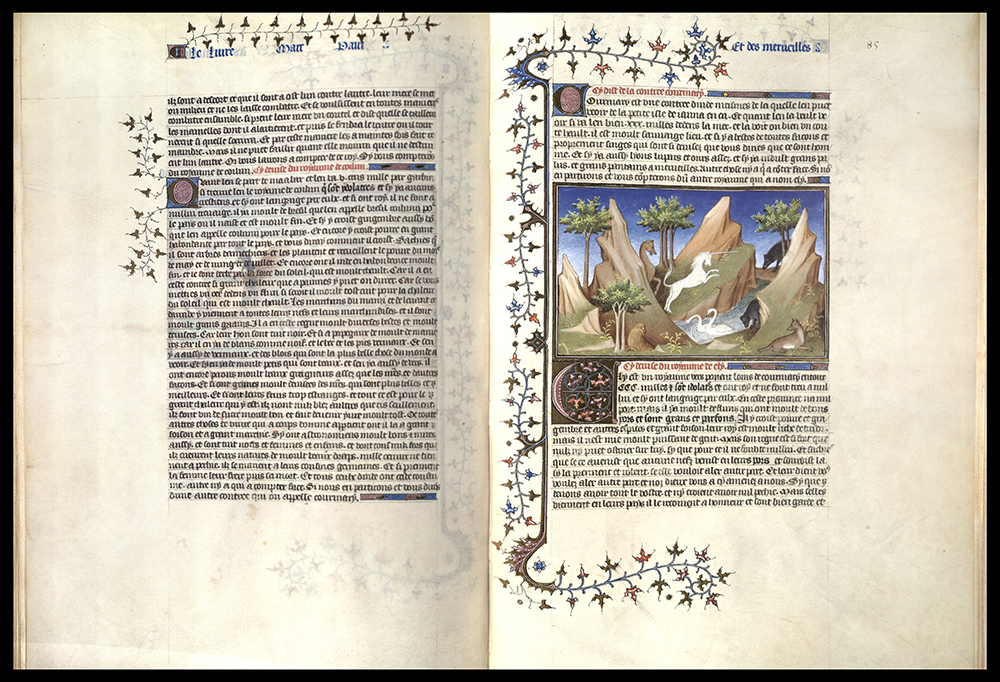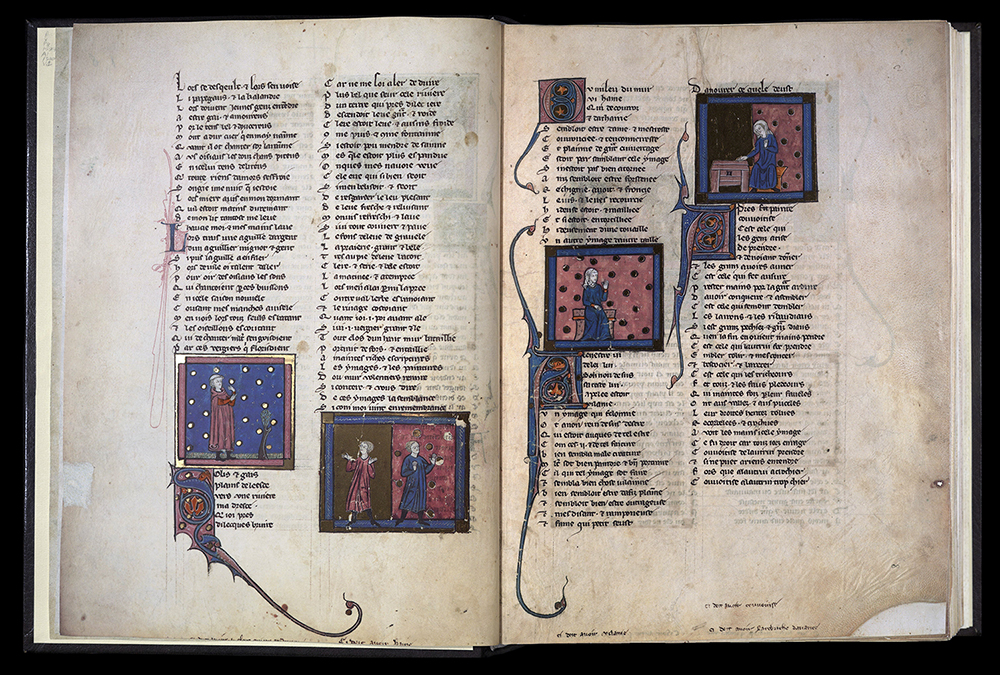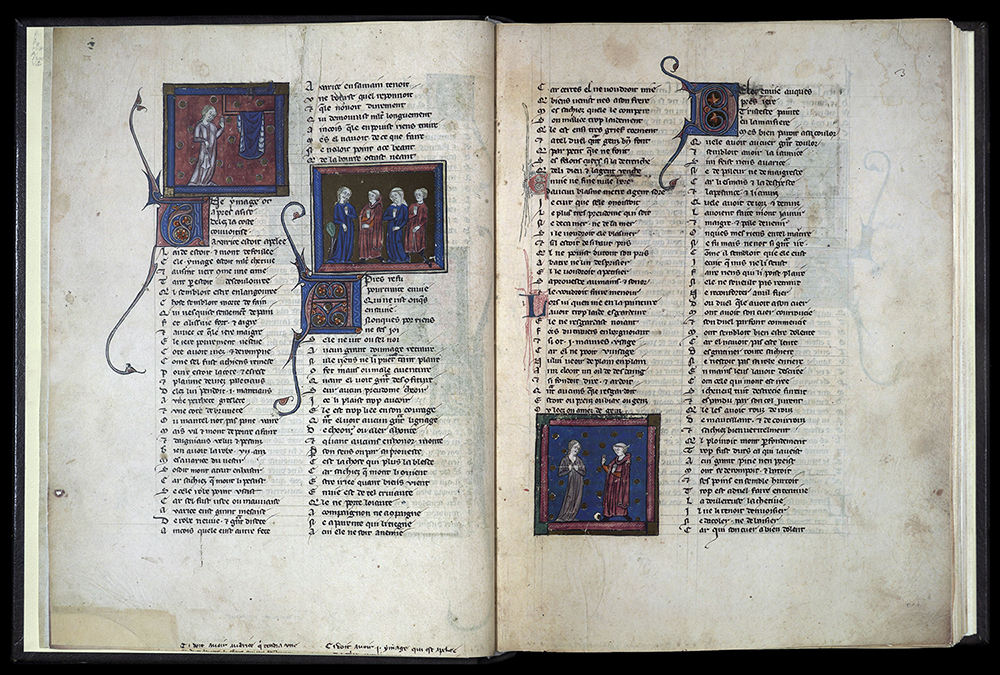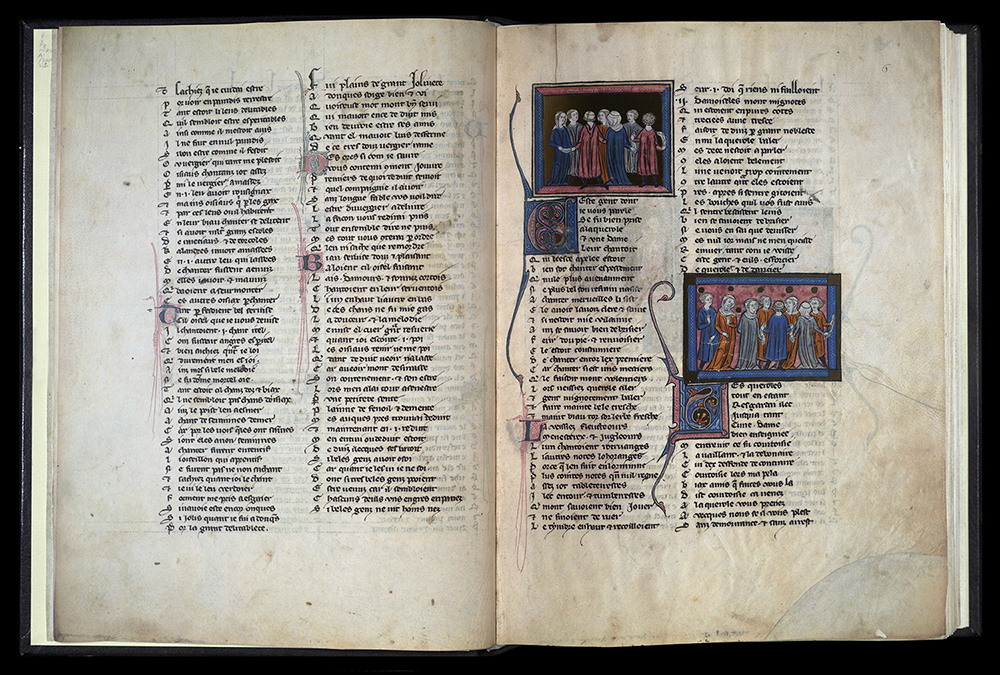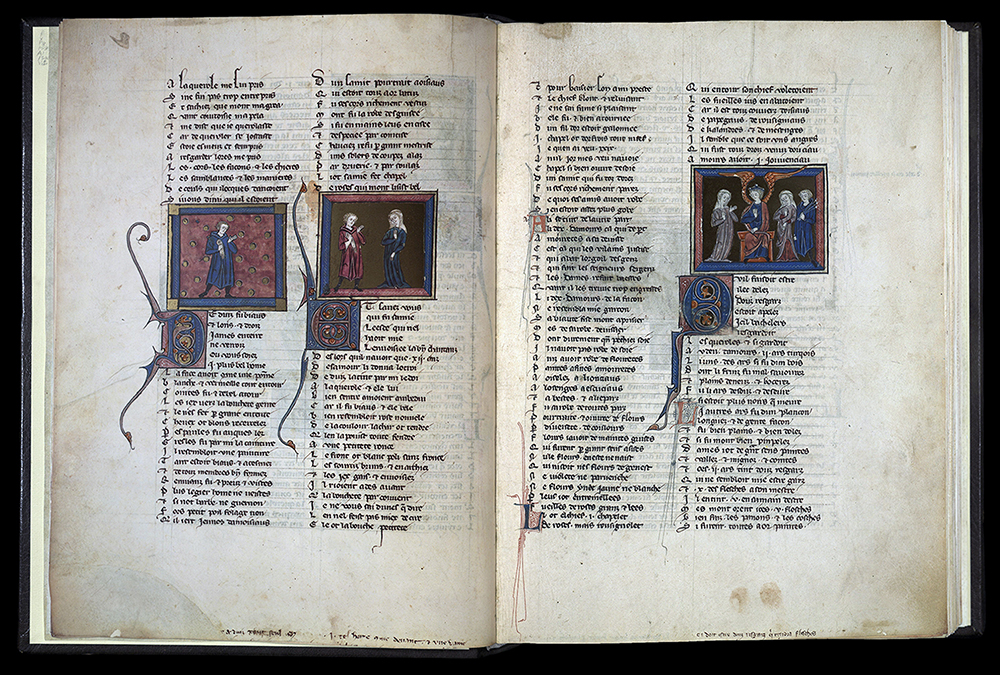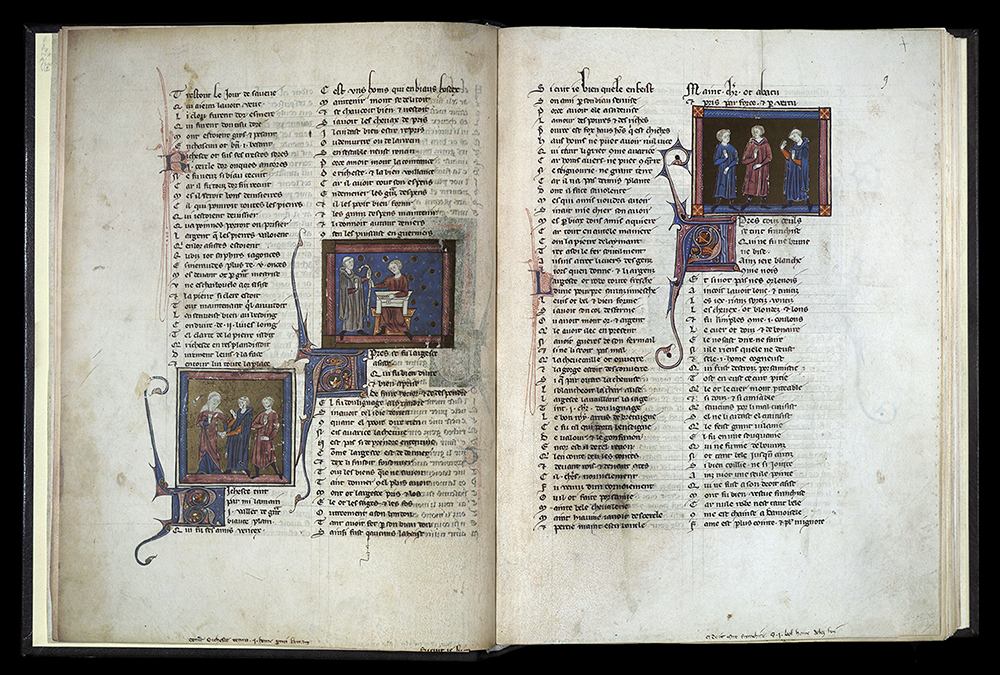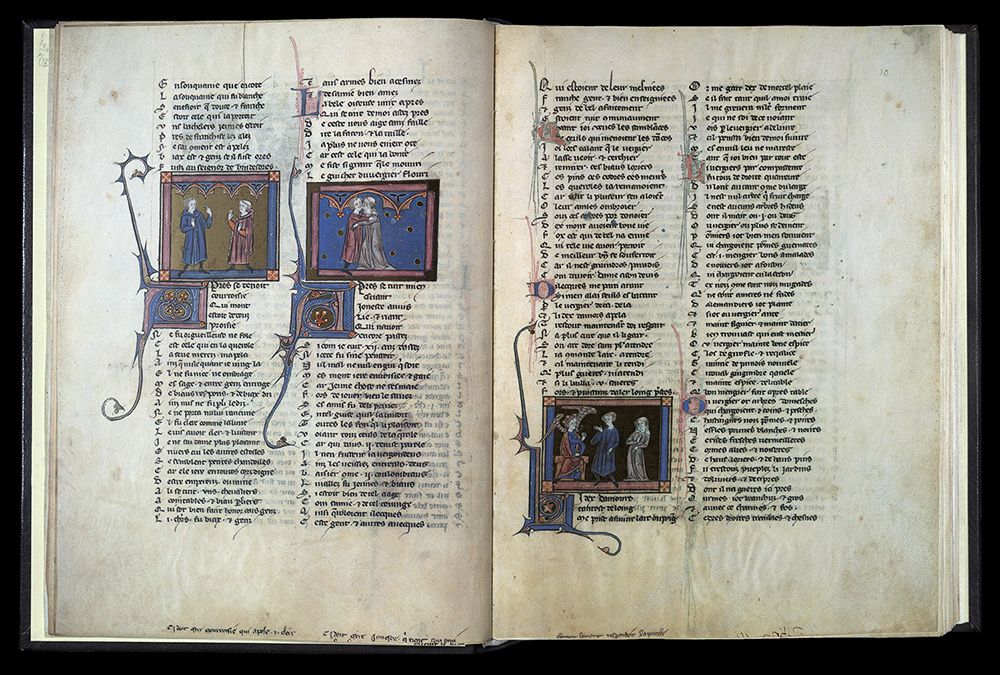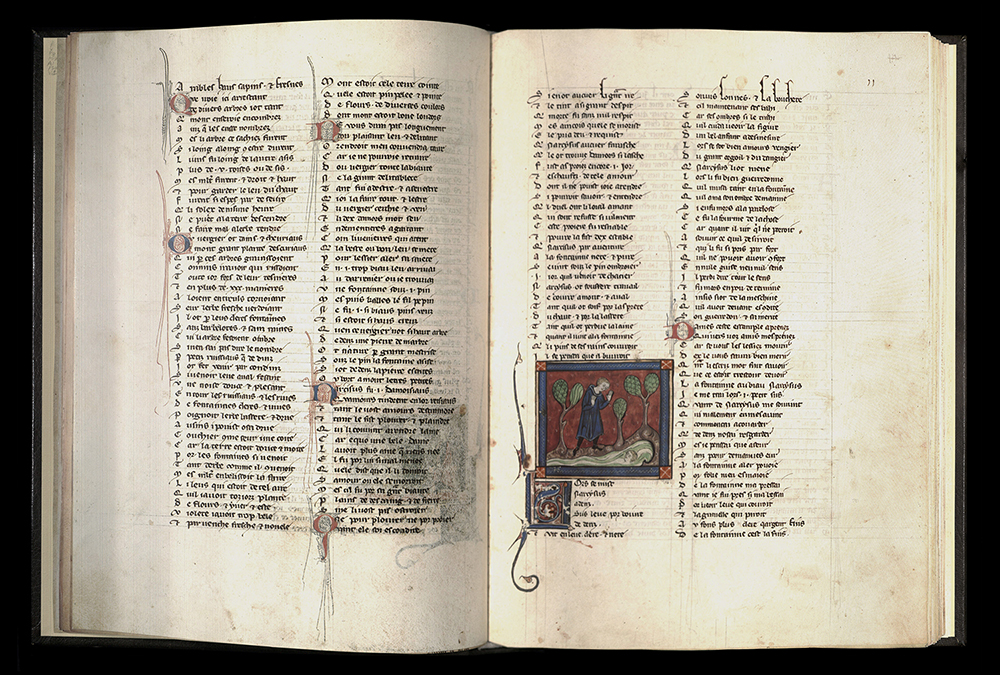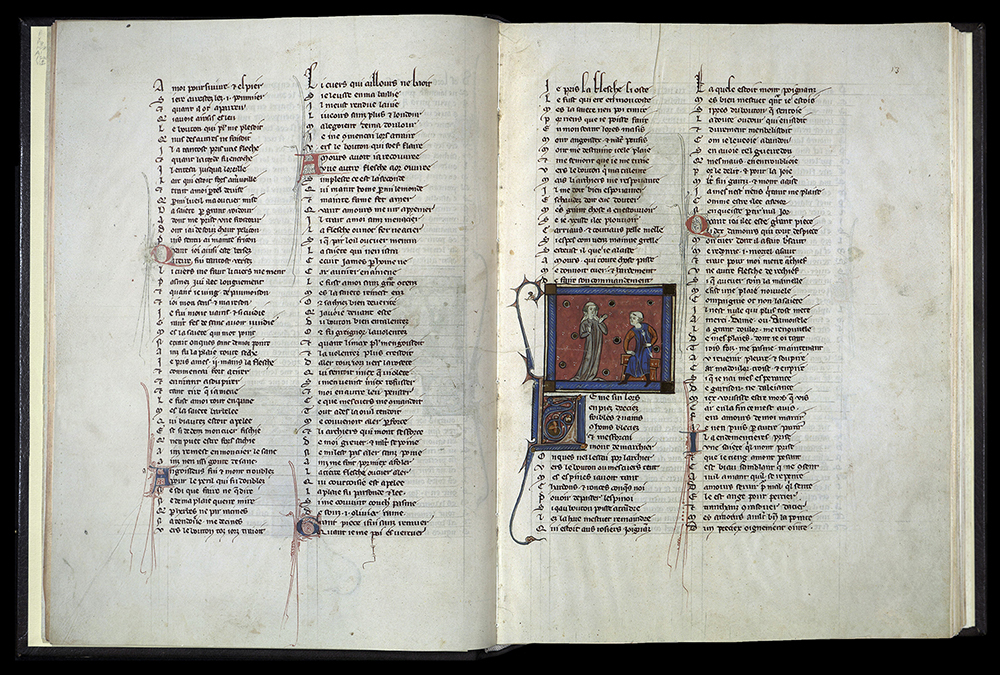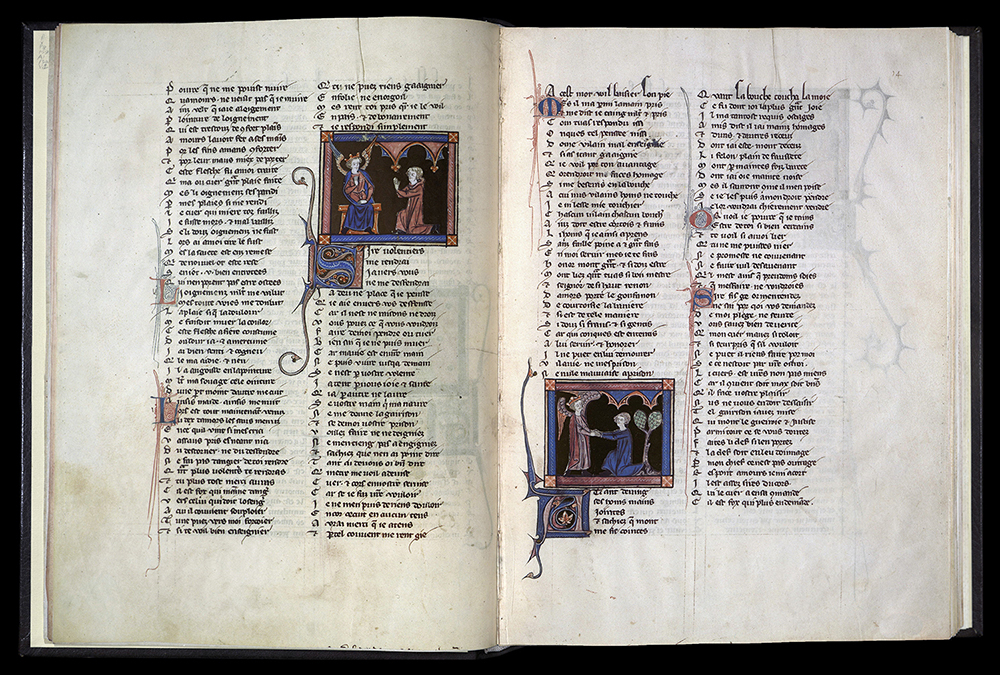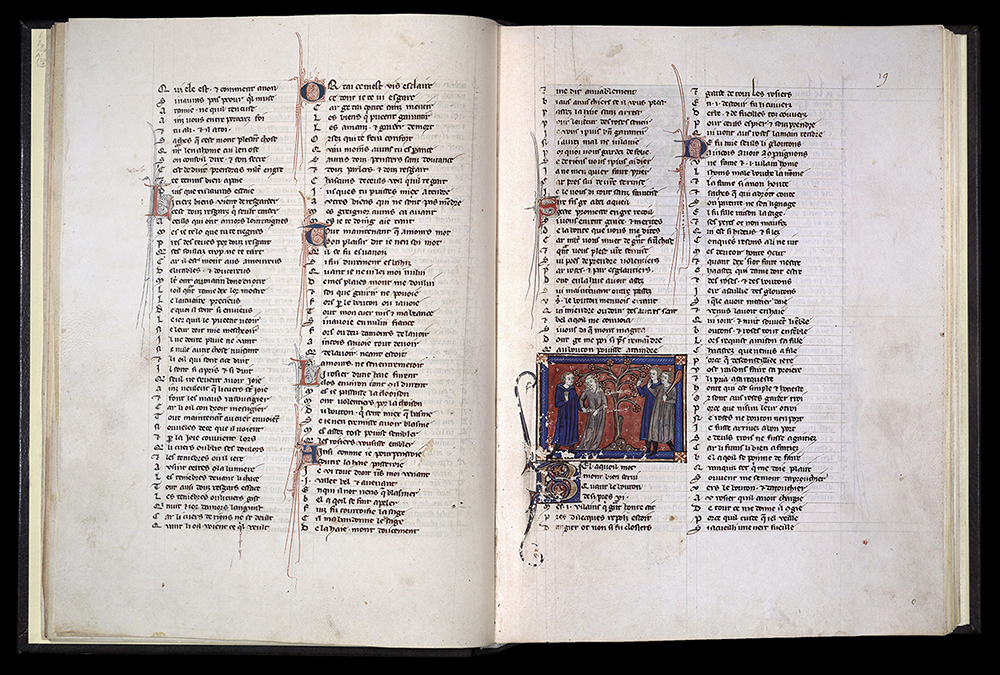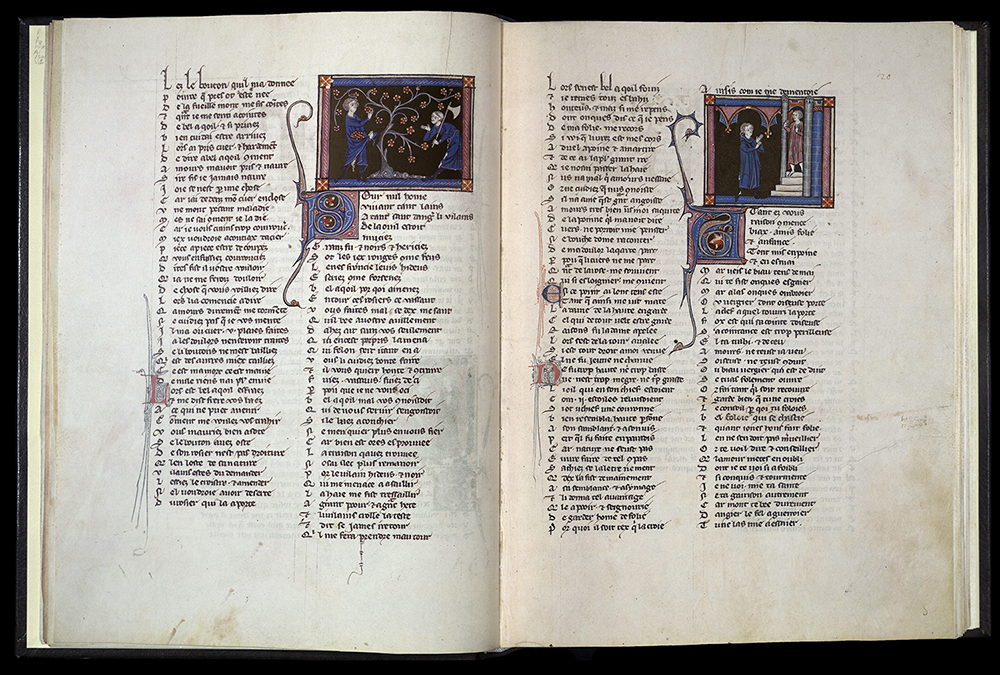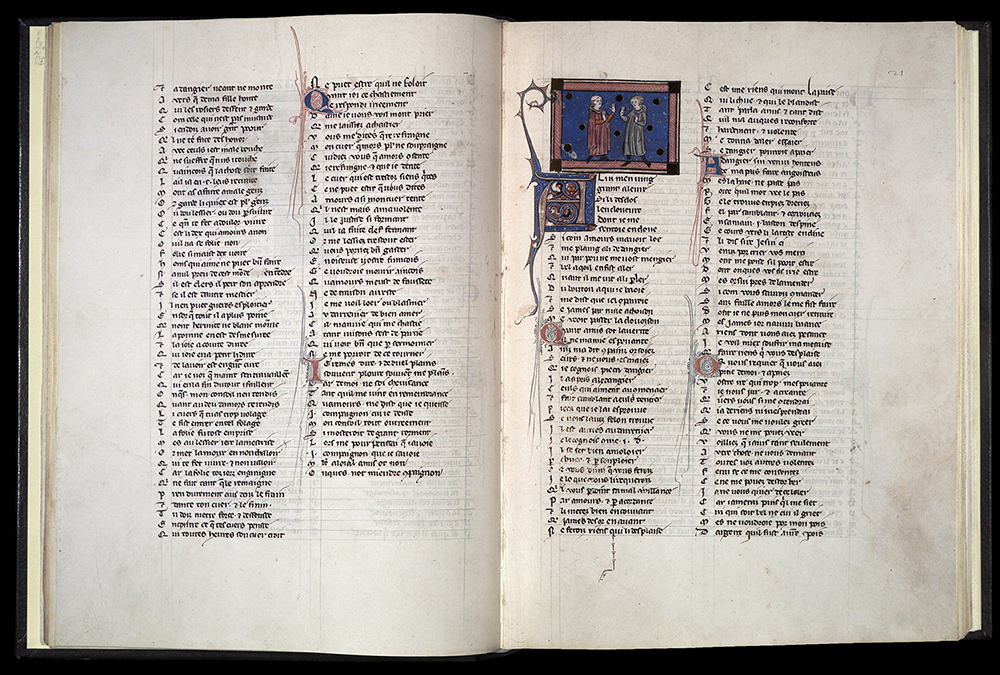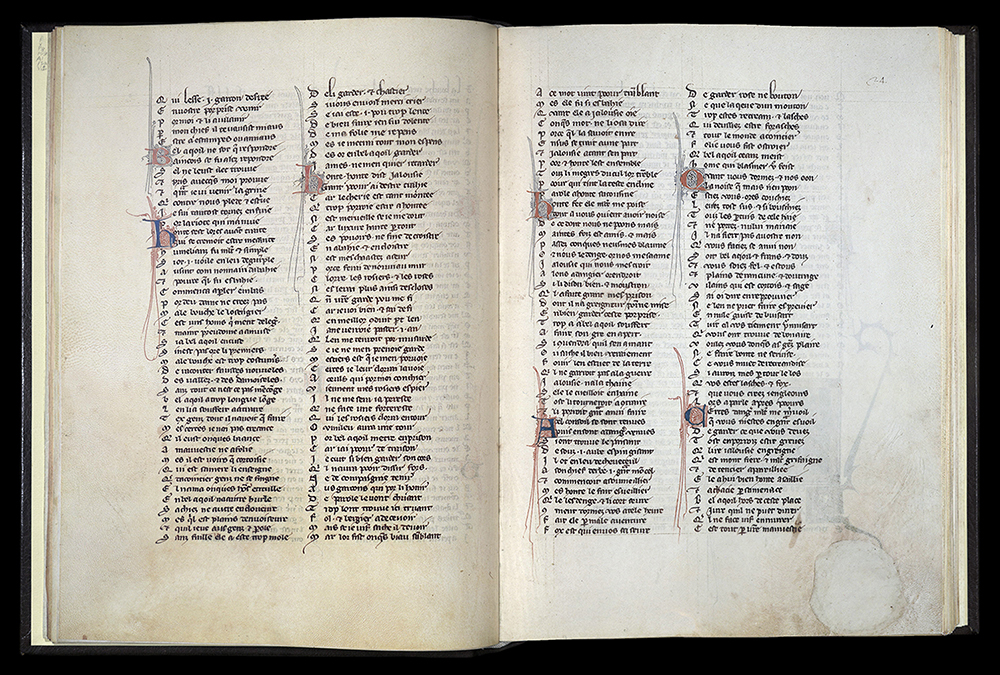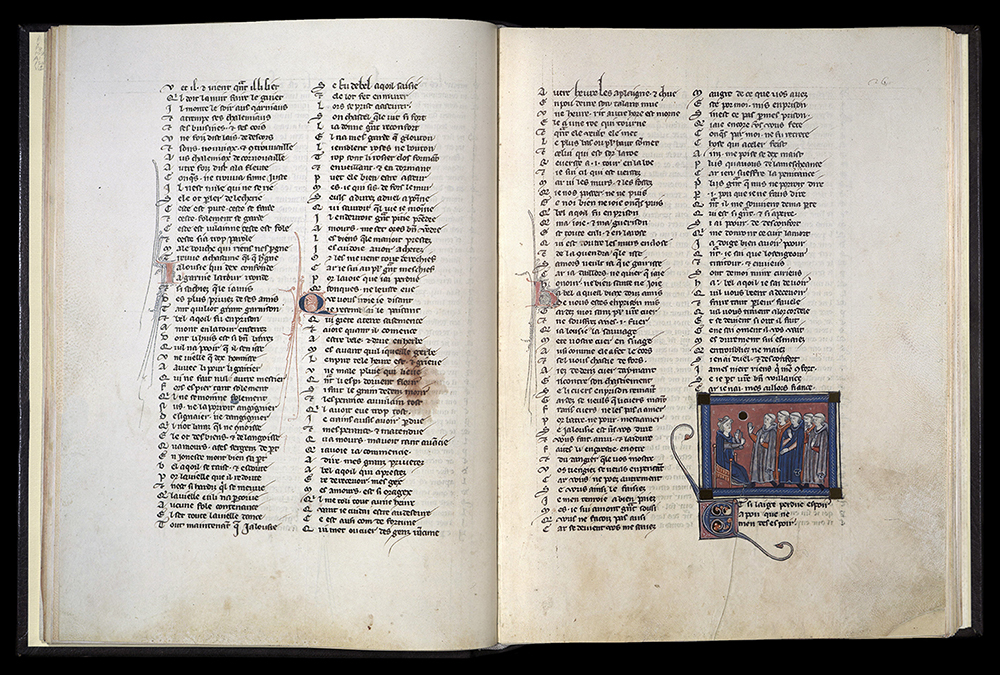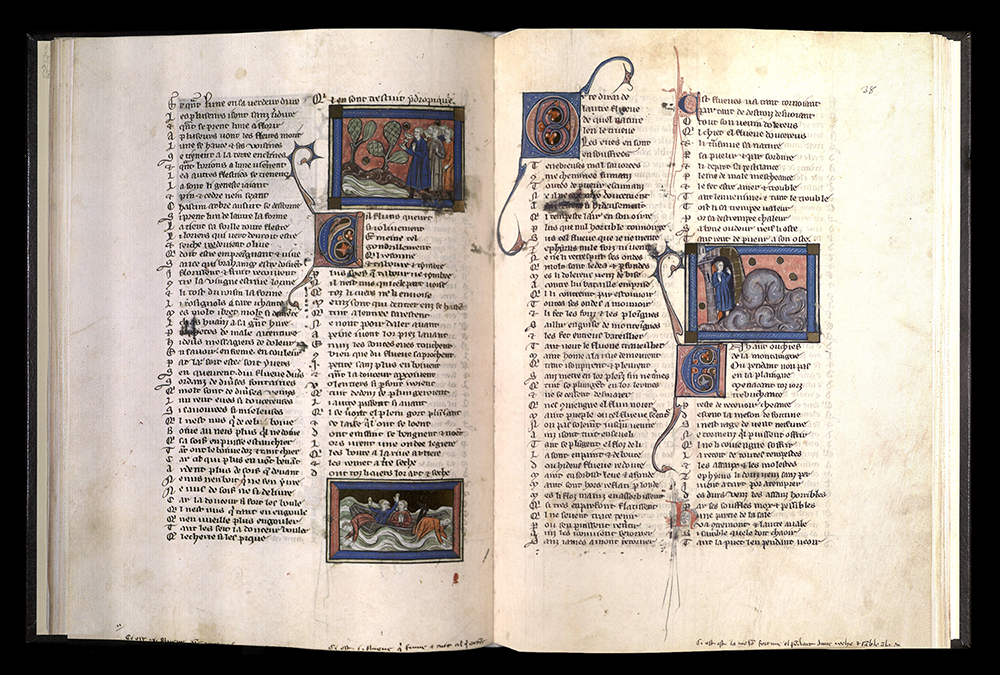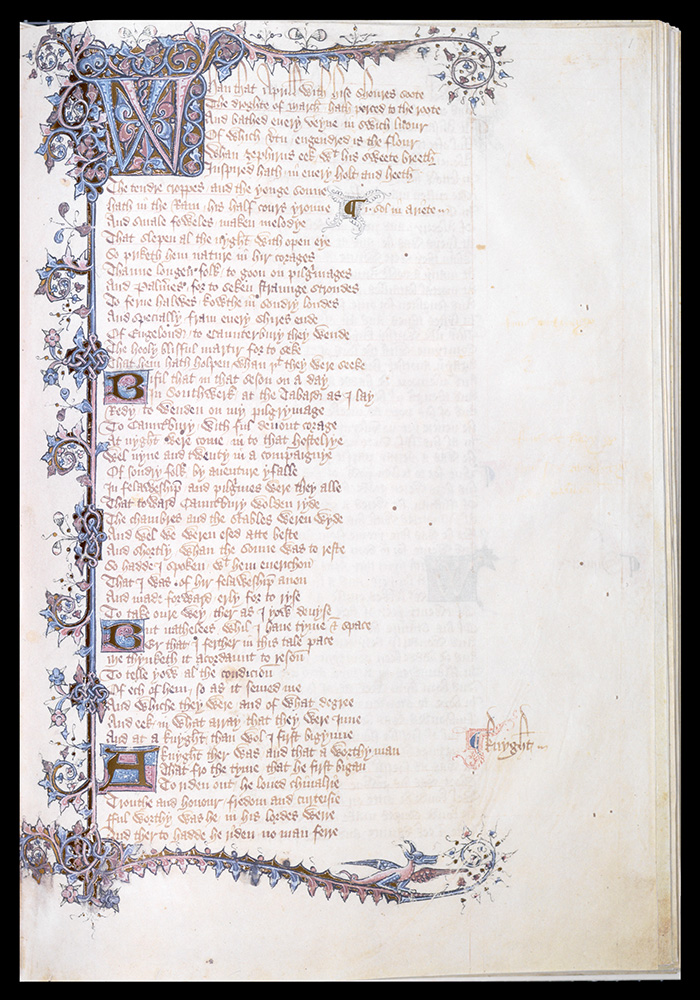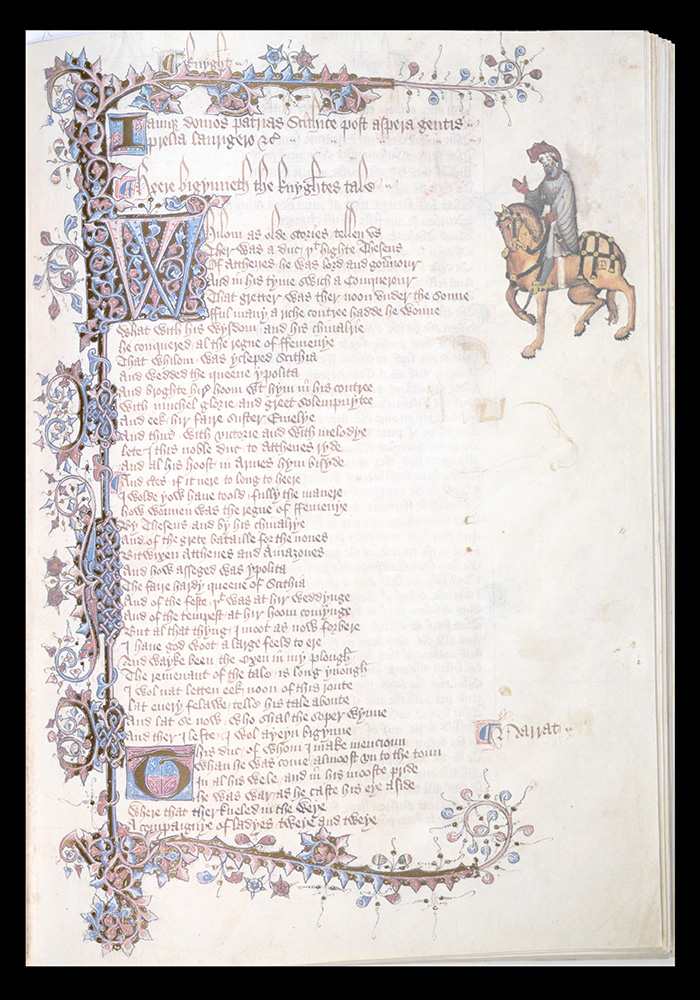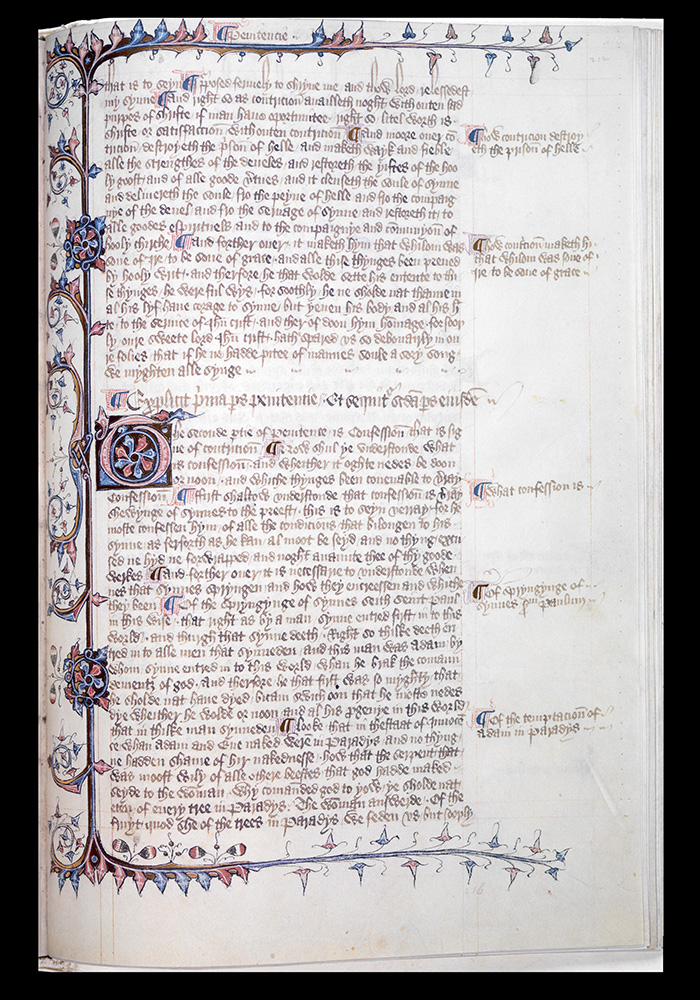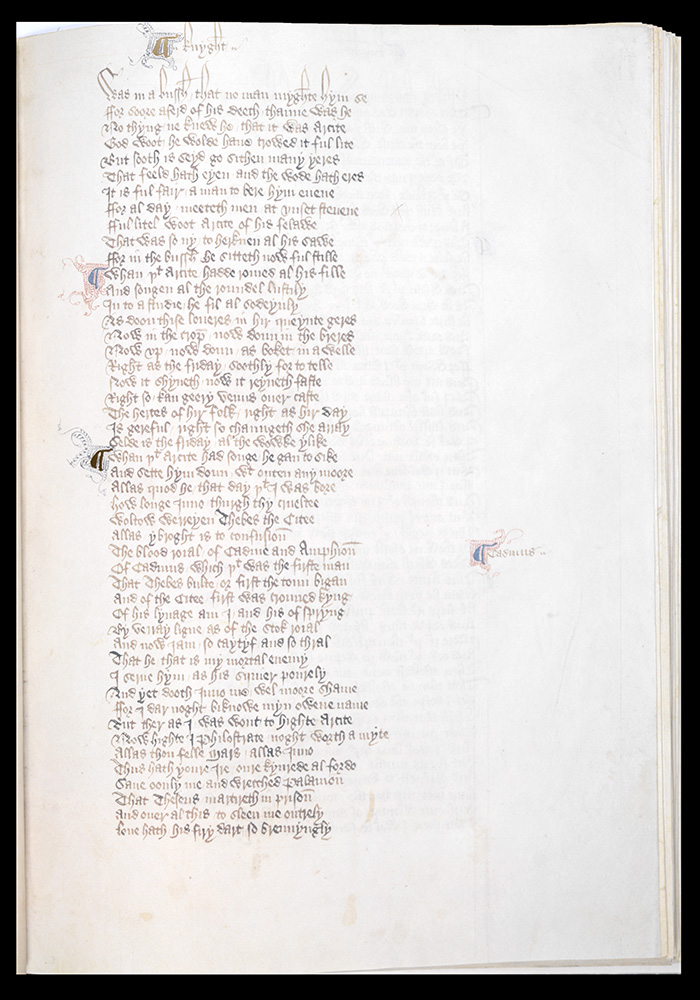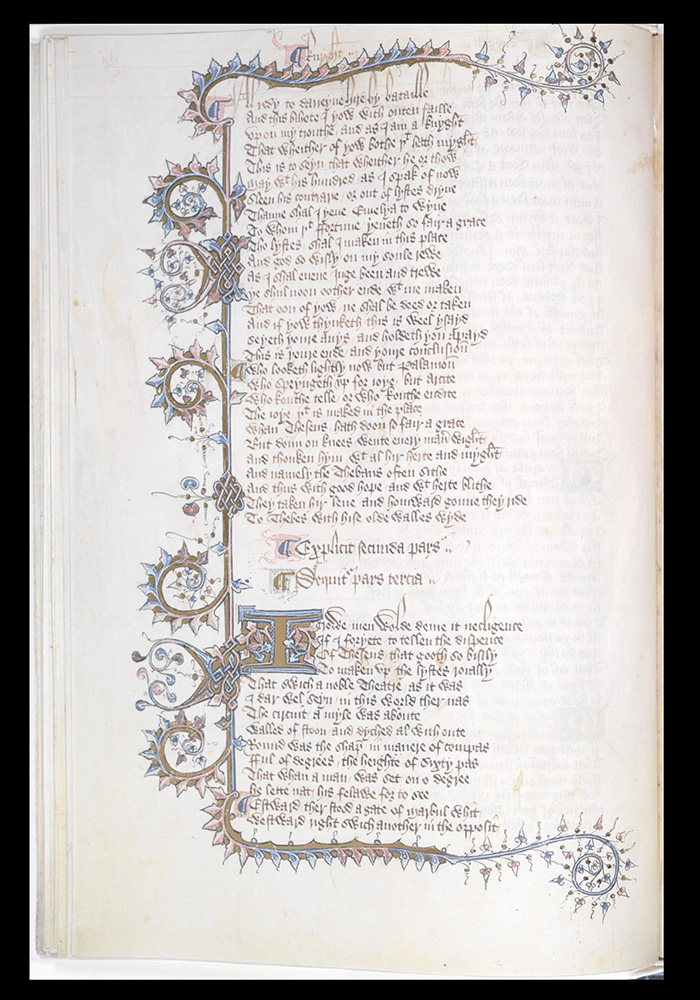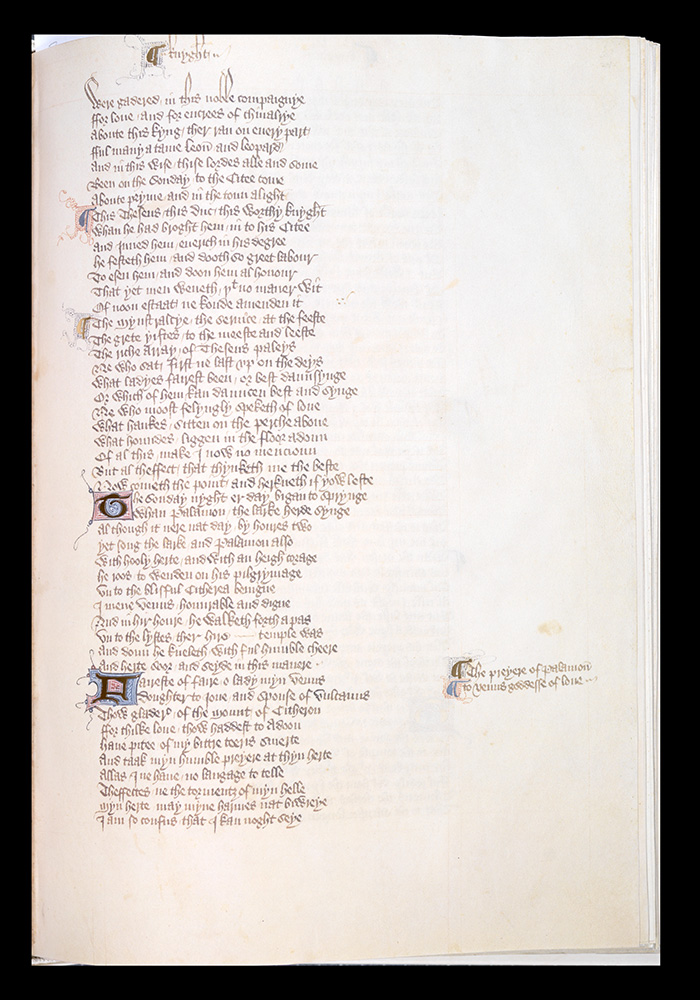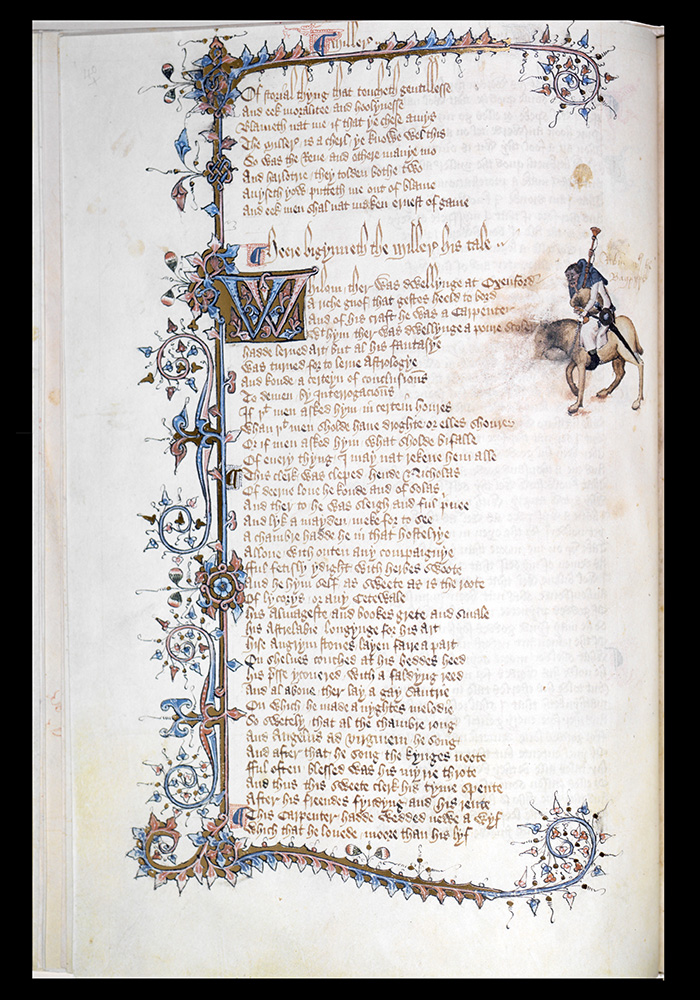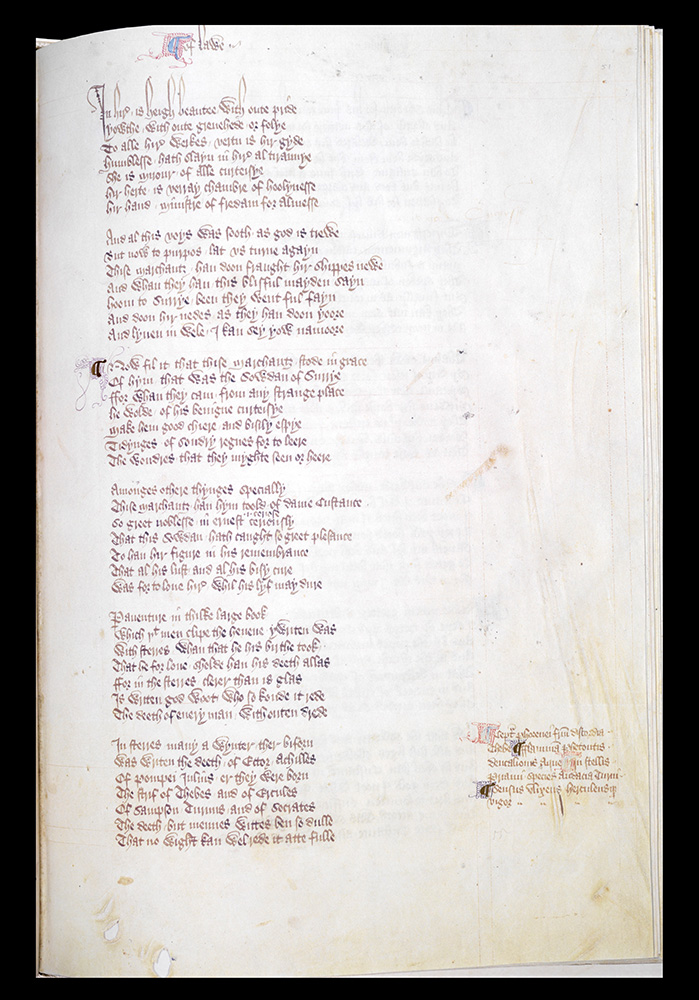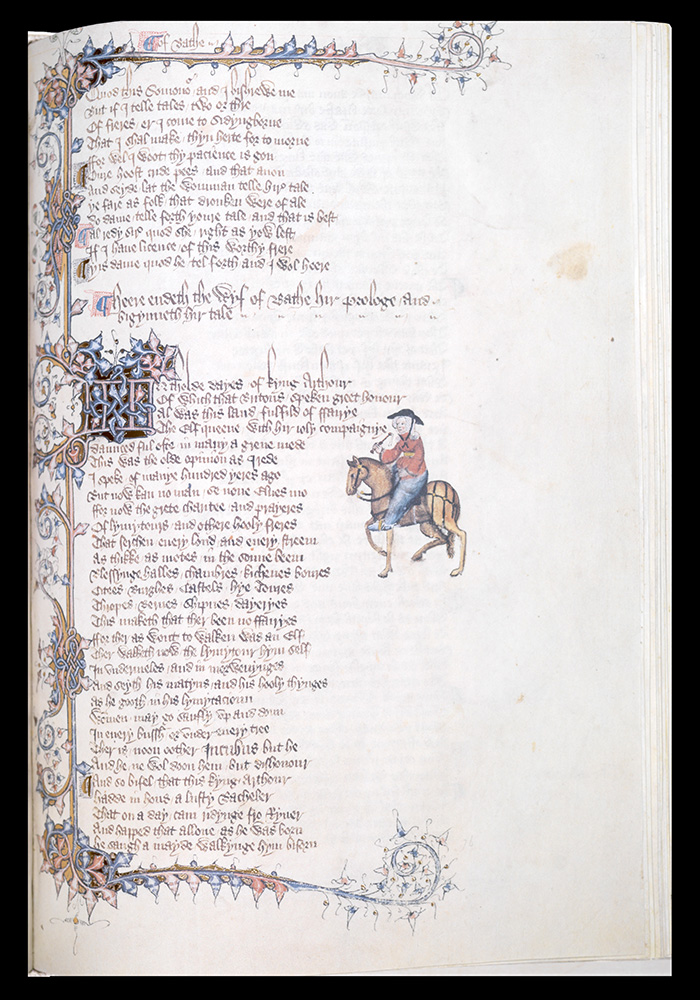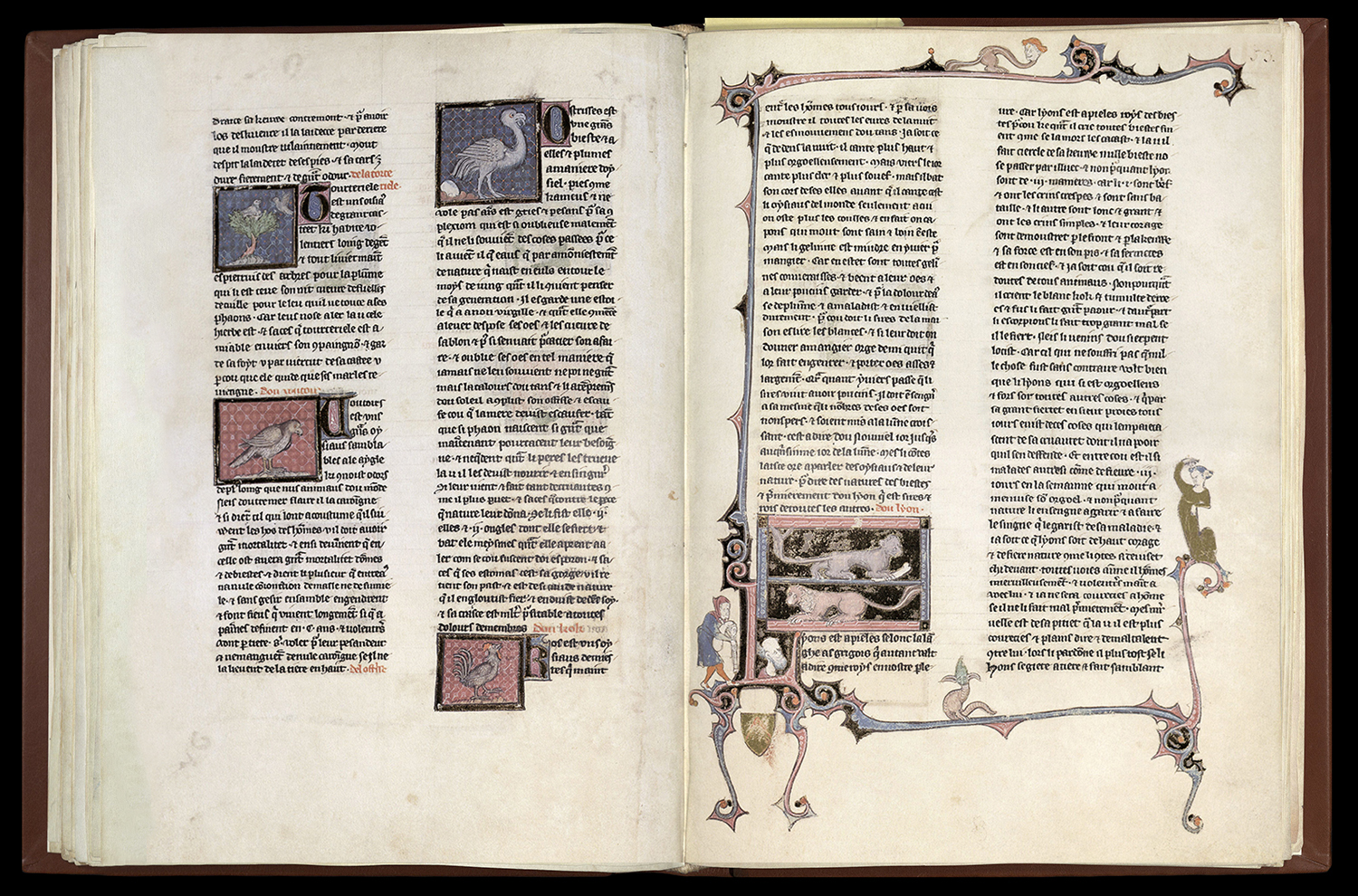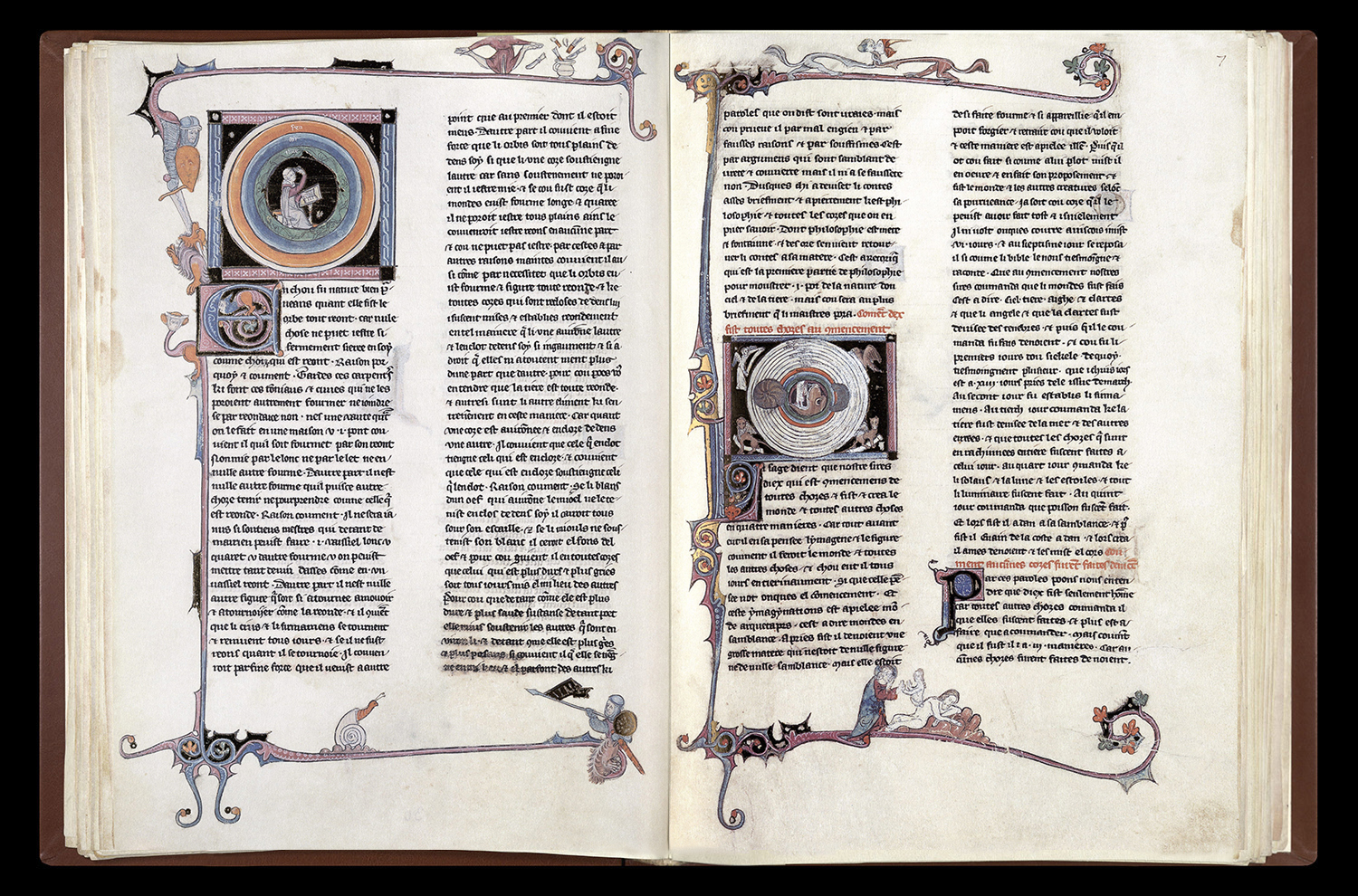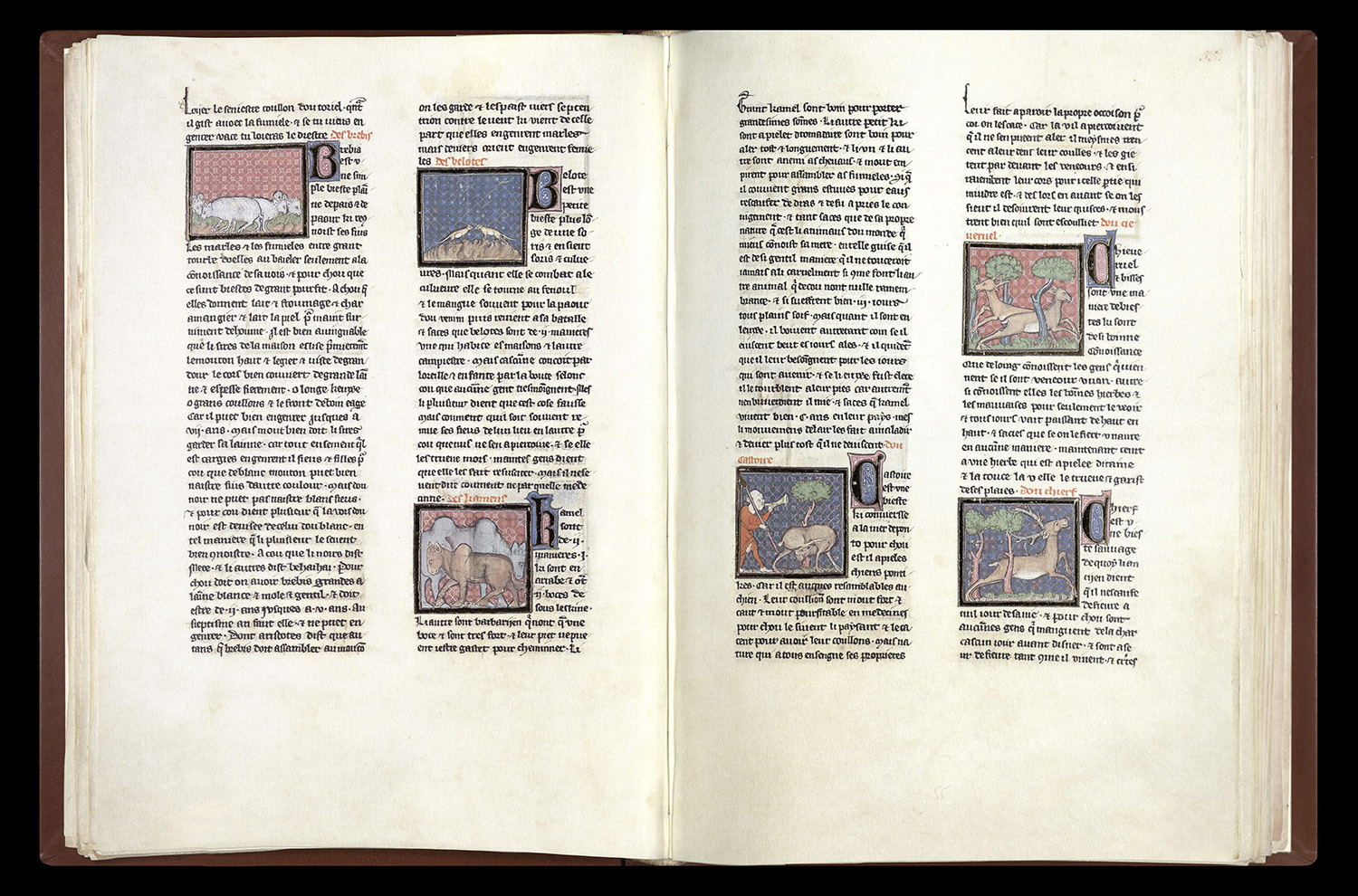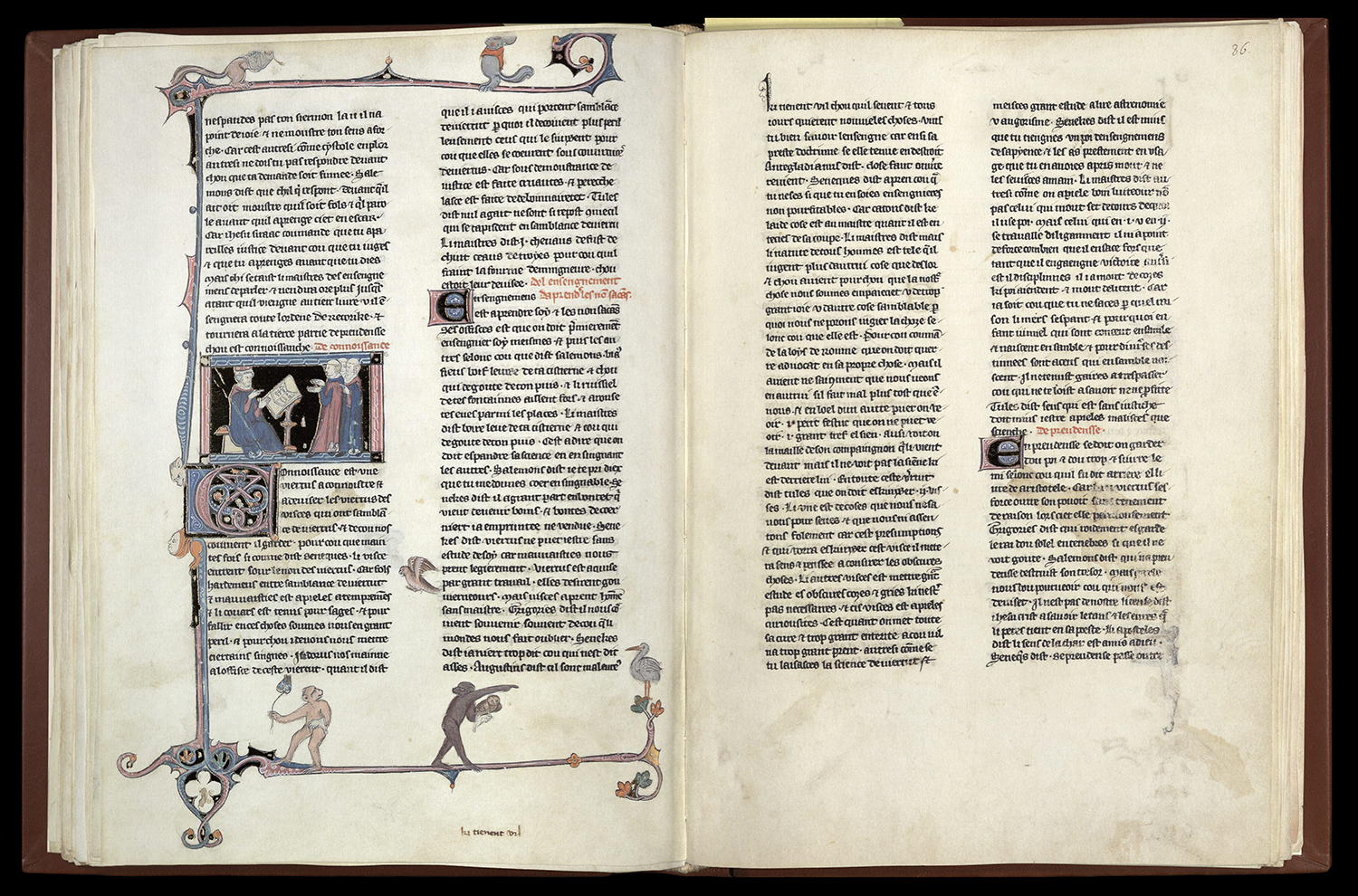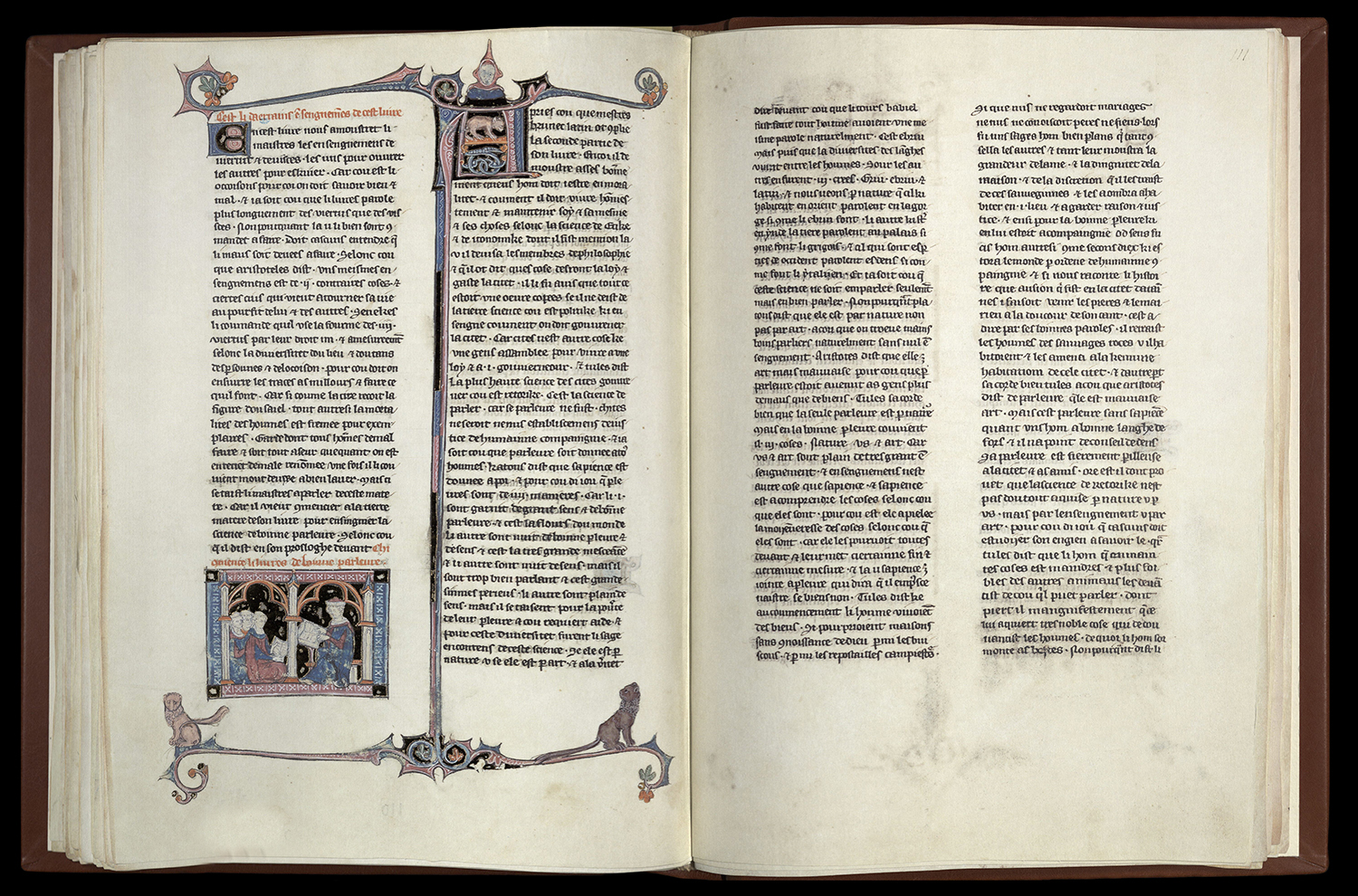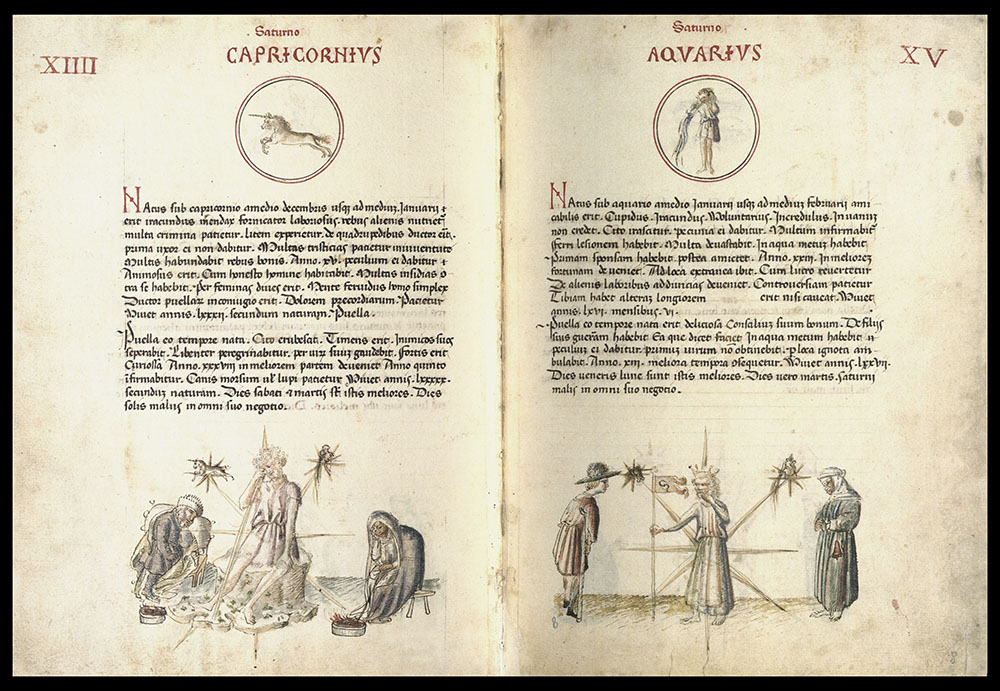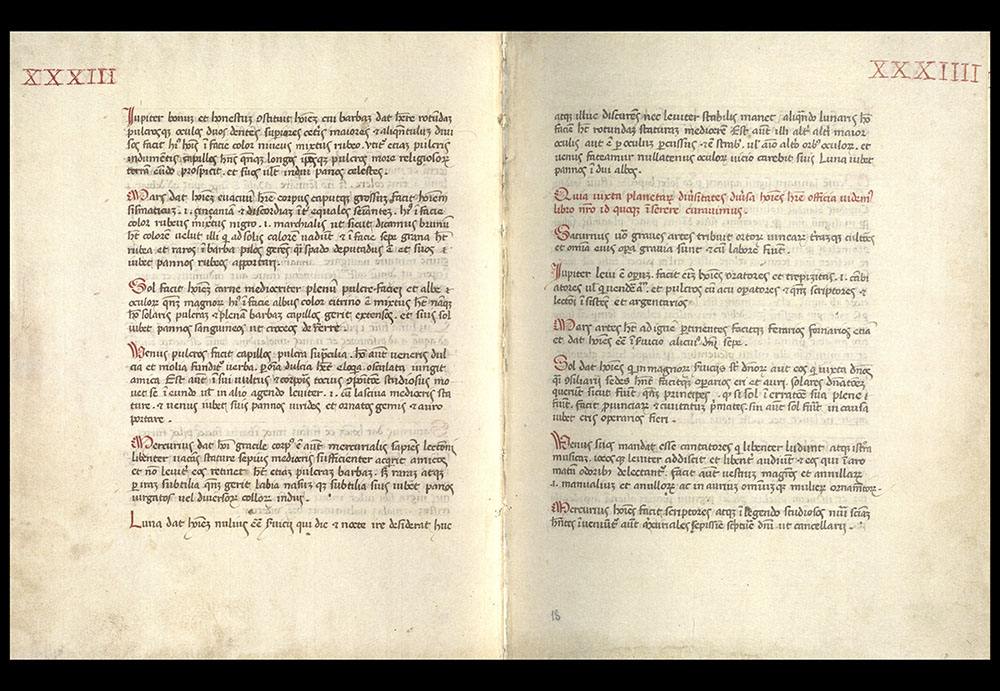OrnamentS
BEAUTIFUL BOOKS, BEAUTIFULLY REPRODUCED
Checklist for " Ornaments "
Curated by guest curator Jennifer M. Bauman, Ph.D, and Luise Poulton, 2003
Digital Exhibition produced by Lyuba Basin, 2020
FACSIMILES ARE METICULOUS REPRODUCTIONS THAT CONVEY THE SPIRIT AND POWER OF OFTEN-INACCESSIBLE, ORIGINAL BOOKS. Through the art of the facsimile, many of the most beautiful books ever made may be appreciated by audiences the world over. In particular, facsimiles of handmade, one-of-a-kind medieval manuscripts allow student and connoisseur alike to revel in the details of the magnificent work of medieval bookmakers. Visual feasts, the reproductions themselves are so lovingly created, carefully crafted, and faithful to the originals that they may be appreciated in their own right as tributes to the art of book production.
THE FACSIMILES IN THIS EXHIBITION REPRODUCE BOOKS THAT DATE FROM THE EARLY MIDDLE AGES THROUGH THE SIXTEENTH CENTURY. They range in subject from literary works and religious texts to herbals, travel books, astrological treatises, health manuals, and artists’ workshop books. The majority of these manuscripts were illustrated with color using techniques specifically devised for illuminating books. In fact, illumination became so highly developed and valued that monarchs and other rulers commissioned luxuriously illuminated book as items of display and prestige. Many of the books were so lavishly decorated that the text itself became almost incidental to the painted ornamentation.
A FACSIMILE IS AN EXACT REPLICA OF AN ORIGINAL BOOK. The word “facsimile” comes from Latin, meaning to “make the same.” The starting point of the facsimile is the original manuscript. The facsimile is a faithful copy of that unique original. The facsimiles presented here from the Marriott Library’s rare book collections are works of great artistry in book production. They have been handcrafted with the utmost care and attention to detail to achieve precise copies. The process of creating a facsimile is a lengthy one. The traditional methods used to create the original work are researched and then replicated with both state-of-the-art electronic processes and conventional techniques, employed by highly skilled bookmakers. Each book is approached individually in order to successfully duplicate the format, tone and color, unique to each work. The actual condition of the original book is respected. Water damage, tears, discoloration, uneven pages, etc., are re-created without changing, adding to, or enhancing the condition of the book in any way. No cost can be spared to achieve an exact replica. Bindings are handcrafted to faithfully duplicate things such as the original type of leather or fabric used, as well as any clasps, fasteners, gilding, and embossing. Because facsimile production is such a painstaking process, editions are necessarily expensive and limited. The Marriott Library is among the few libraries in the world to own many of these beautiful books.
ANCIENT LITERATURE
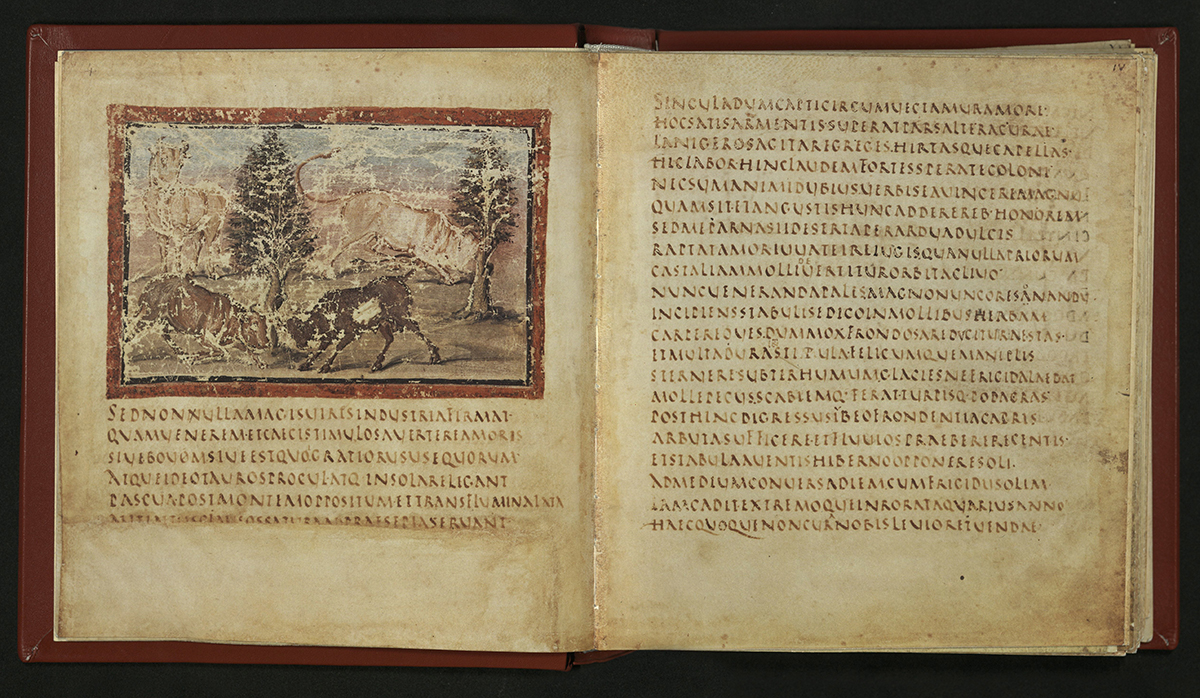
VATICAN VIRGIL (VERGILIUS VATICANUS)
Virgil, c. 400
Vatican City, Biblioteca Apostolica, Vat. lat. 3225
Graz: Akeademische Druck-u. Verlagsanstalt, c. 1984
Z114 V3 1984b
The Vatican Virgil is one of the earliest known Roman manuscripts to survive from antiquity. The manuscript in its original form consisted of approximately four hundred-thirty folios. In its present fragmentary state, only seventy-five leaves still exist. The surviving leaves contain parts of Virgil’s Georgics and the Aeneid, written throughout by one hand, in Roman rustic capitals. The book as it exists today contains fifty full-page miniatures, and a series of smaller miniatures interspersed with the text. Altogether there are nine illustrations of the Georgics and forty-one of the Aeneid. The miniatures are uneven in quality and were clearly executed by more than one artist, possibly as many as four.
The illuminator of the Georgics was the superior artist of the whole series. His pastoral pictures give the viewer a sense of the beauty of Virgil’s poetry, expressing with his graceful figures, in this scene of two jealous bulls fighting. The dynamic brute force of the animals is placed in stark contrast to the object of their quarrel, a beautiful cow, with a noticeably demure personality to the left. The scene, which takes place in Sila in the Appenines, is set against a lovely rose-tinted sky that turns to blue. On the right, the bull that has been defeated is shown charging toward the trunk of a tree, with the fierce energy of a thwarted lover.
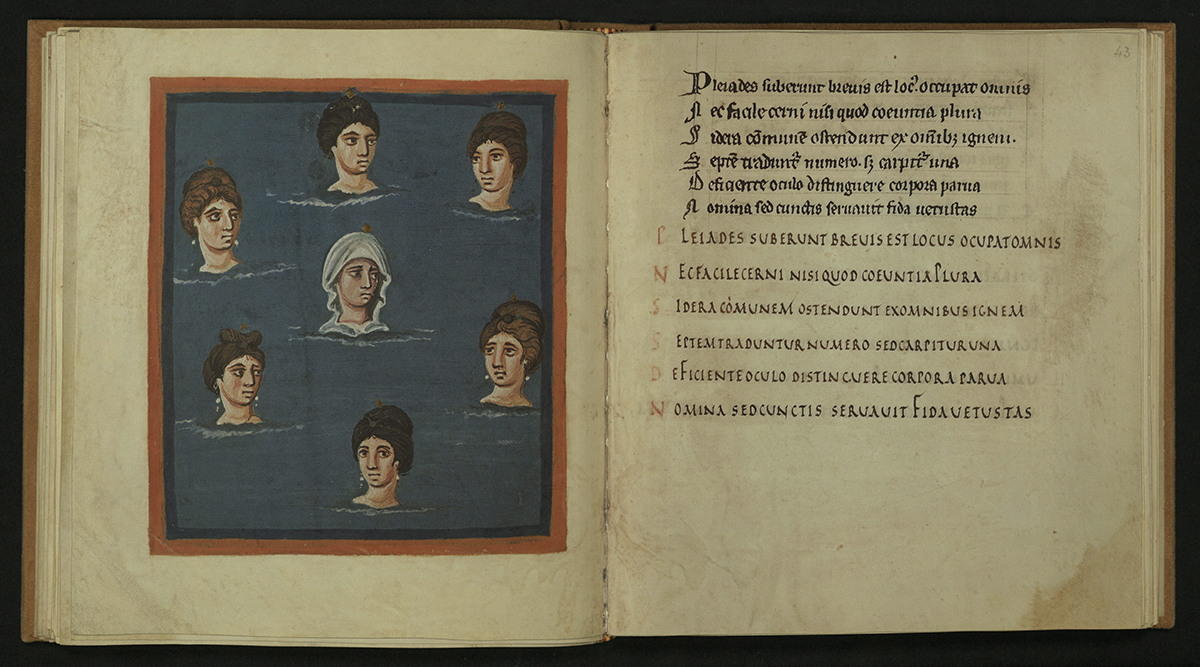
ARATEA
Claudius Caesar Germanicus, ninth century
Leiden, Universiteitsbibliotheek, Ms. Voss. Lat. Q. 79
Lucerne: Faksimile-Verlag, c. 1987
PA6392 G3 P5 1987
The Aratea is the title given to a series of astronomical manuscripts based on the Phainomena, a Greek didactic poem by Aratus of Soli (around 315 to 245 BC), describing the constellations and weather signs. Aratus’ work achieved great popularity in ancient Rome. It was translated into Latin by Claudius Caesar Germanicus. In that form, it was read during the Middle Ages as a source of information regarding the heavens.
The manuscript reproduced here was created during the Carolingian period in the area known today as the Lorraine region of France. It is thought that it was created for the Empress Judith, the second wife of Emperor Louis the Pious (814-840).
The book contains ninety-five leaves, with thirty-nine full-page miniatures, of very high quality and artistic merit. The identity of the artist who painted the miniatures is unknown. It is believed, however, that whoever it was relied heavily on what must have been a fourth-century manuscript, for the illustrations are very close to the style of Late Antique painting. The boldly colored miniatures depict personified representations of celestial bodies to illustrate the text, which is written in Capitalis Rustica on the page opposite. All of the figures appear against a dark blue night sky, with the stars painted in gold.
In the miniature above, the artist has depicted the daughters of Atlas and the nymph Pleione, all of whom were transformed into the Pleiades. The related text referring to the Pleiades describes the stars in the following way, “Seven they number, yet one is plucked away,/When failing eye fails to separate their tiny bodies.” The figure in the middle is presumbably the concealed star Merope (i.e. the one who is “plucked away”). Her head is veiled to illustrate how she hid out of shame for falling in love with the mortal Sisyphus.
MEDIEVAL MEDICINE
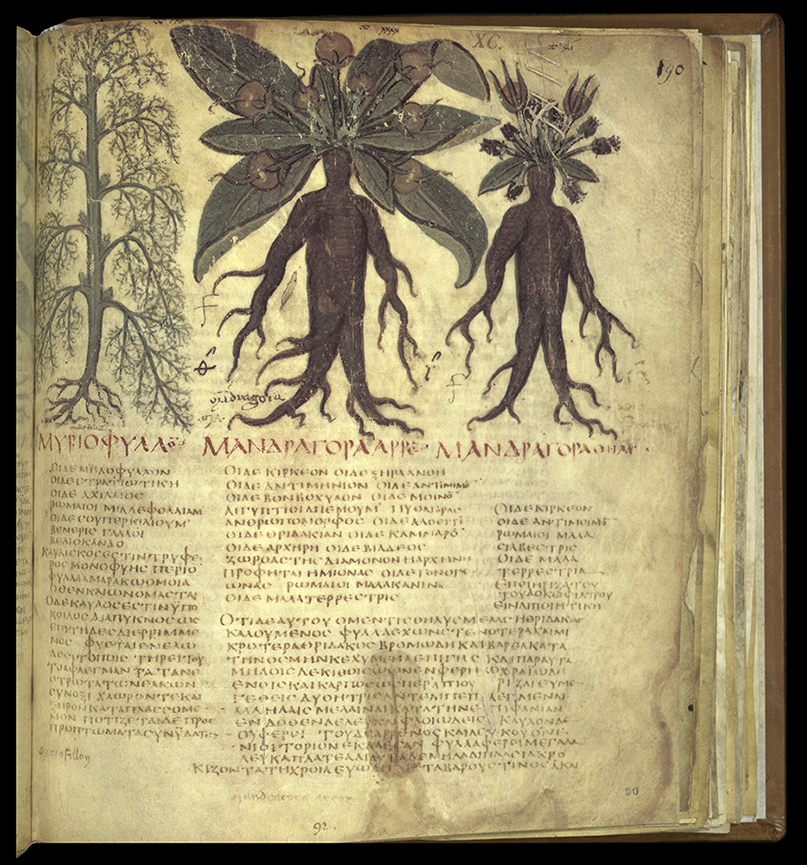
ON MEDICAL MATTERS (DE MATERIA MEDICA)
Pedanius Dioscorides, early seventh century
Naples, Biblioteca Nazionale, Ms. Ex Vindob. Gr. 1.
Graz: Akademsiche Druck-u Verlagsanstalt, 1988
R126 D57 1988
Pedanius Dioscorides was a Greek military surgeon of the first century AD. His herbal, known as the De materia medica, first established medical botany as an applied science. The original work described the properties of around six hundred plants and some animal products that were known to have therapeutic value. This book remained the main source on which other herbals drew for over fifteen hundred years. What made Dioscorides’ work particularly valuable was its succinct accounts of the plants described (which was a real necessity if one were to avoid being poisoned.)
In Chapter thirteen of his work, Dioscorides writes, “Now it behooves anyone who desires to be a skillful herbalist to be present when the plants first shoot out of the earth, when they are fully grown, and when they begin to fade. For he who is only present at the budding of the herb cannot know it when full-grown, nor can he who hath examined a full-grown herb recognize it when it has only just appeared above ground.
All illustrated herbals of the Middle Ages and Renaissance trace their descent from the famous sixth-century manuscript of Dioscorides’ text in the National Library in Vienna (Cod. Med. Graec.1). The manuscript here in facsimile form, dating to the seventh century, is no exception. Over four hundred plants are described and illustrated in color. For clarity, the name of the plant is identified in red ink. The beauty of the plants accompanying the descriptions of the text was rarely equaled in herbal illustration until the Renaissance.
The binding of the facsimile is made of wooden covers and leather in accordance with the original.
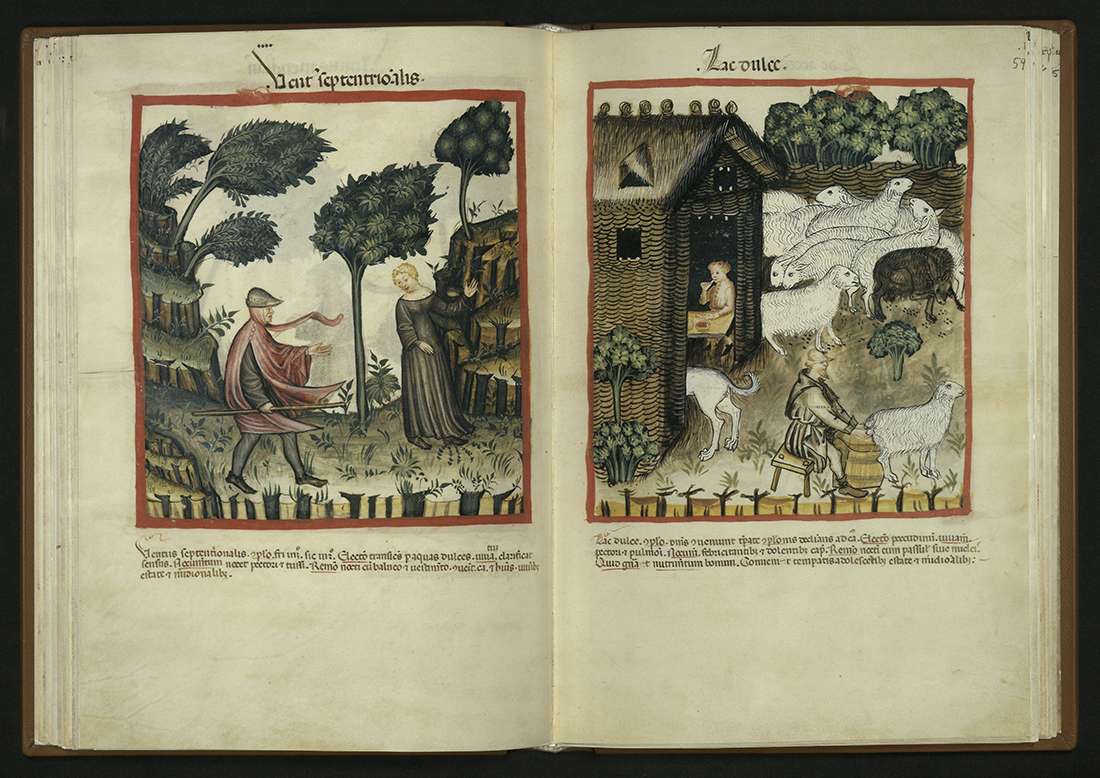
HANDBOOK OF HEALTH (TACUINUM SANITATIS IN MEDICINA)
Fourteenth century
Vienna, Österreichische NationalBibliotheck, Cod. Vindob. ser.n.2644
Graz: Akademische Druck-u. Verlagsanstalt, 1986
RS79 T335 1986
Handbooks on health were in great demand during the fourteenth and fifteenth centuries. They were considered especially relevant to North Italian court life, presenting as they did everything one needed to know to live well. The handbooks were typically produced for the layperson rather than the professional. It has been suggested that in the case of this particular manuscript – with its emphasis on household management and well-being – that this layperson was a woman whose elevated station would have allowed her the means to own and utilize such a book.
The source for the information contained within stems from the writings of the Arab Ibn Butlan, an eleventh-century physician, whose writings would have been known from at least one translation completed at the court of King Manfred of Sicily between 1254 and 1266. These writings, entitled the Taqwin al-sihhah in the original version, gained in popularity as part of a revived interest in medicine sparked by Arab culture.
Good health, according to the author, depends on six things: “the treatment of air;” “the right use of foods and drinks;” “the correct use of movement and rest;” “the problem of prohibition of sleep, or excessive wakefulness;” “the correct use of elimination and retention of humors;” and “the regulating of the person by moderating joy, anger, fear and distress.”
The Vienna manuscript is one of the most beautiful examples of its kind. It contains more than two hundred full-page miniatures that vividly illustrate such things as plants, animals, foods, the winds, and the seasons. The illuminations accompany the text that describes how each of the things pictured pertains to health.
The book is assumed to have originated in Verona, as it is painted in the engaging naturalistic style characteristic of northern Italy around that city. The two pages shown above illustrate, on the left, the cold north wind and its chilling effects, and on the right, sweet milk being gathered from some goats. Sour mild is illustrated on the following page.
The facsimile version here is bound in leather and is stamped by hand.
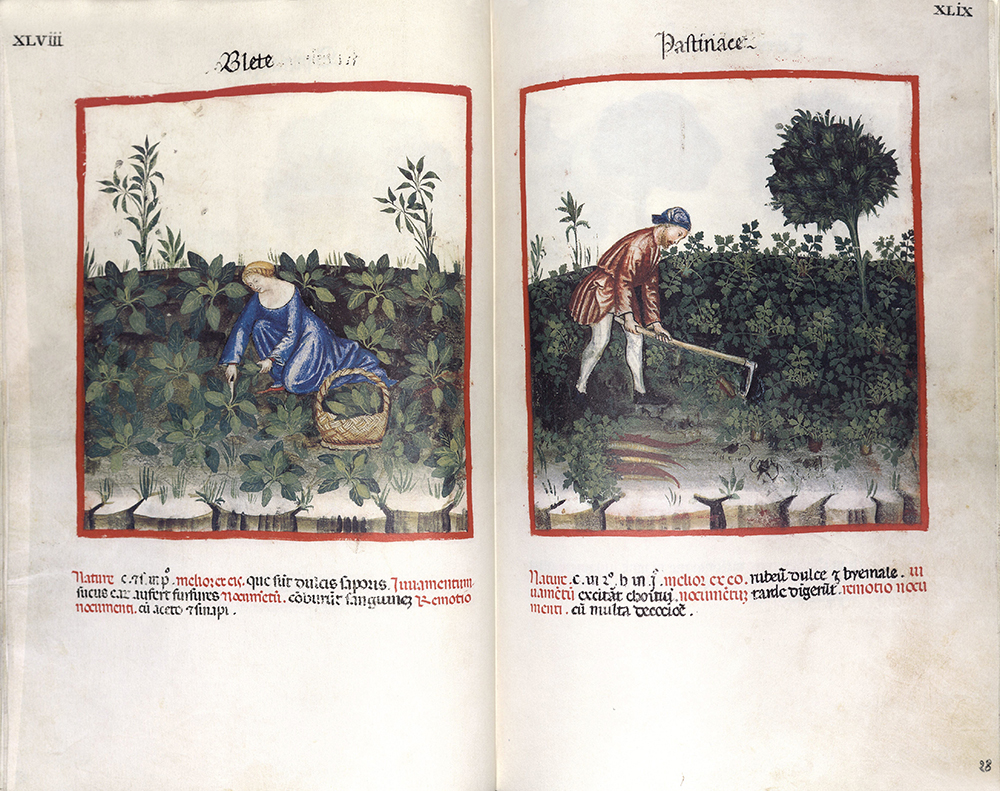
A MEDIEVAL HEALTH MANUAL (THEATRUM SANITATIS)
Fourteenth century
Rome, Biblioteca casanatense, Ms. 4182
Barcelona: M. Moleiro Editor, c. 1999
Edition of 987. Rare Books copy is no. 873
RS79 T46 1999
This manual of health derives from the medical and pharmacological writings of the eleventh-century Arab physician Ibn Butlan, referred to in the manuscript as Ububchasym of Baldach, but better known in medieval literature as Ellucasim Elimittar. A number of versions of his writings appeared in the fourteenth and fifteenth centuries, especially in Italy, called the Tacuinum Sanitatis. The information gathered together in the book, so the text explains, was to enable the lay person to have access to practical medical information without having to request the assistance of men of learning. The book thus supplies in and easily understood format information on medicinal treatments, hygiene and animals and plants that are useful to maintaining good health.
The two hundred and eight nearly full-page illuminations on the recto and verso of each page illustrate and help to explicate the text. Representations of flowers, fruits, and therapeutic herbs, like the ones above, predominate, though other subjects such as the seasons, the winds, various waters, and the slaughtering of animals are also treated. Of particular interest are scenes from daily life that so nicely recreate the character of the times for the modern viewer.
The illuminations are attributed to the school of the great north Italian artist, Giovannino de Grassi, a copy of whose Sketchbook is also included in this exhibition. This particular Theatrum Sanitatis is closely related to the Vienna manuscript, Tacuinum Sanitatis in Medicina – also on exhibit in facsimile form – and probably derives from it.
The facsimile here is hand-bound in brown leather with gold engraving, and arabesques on the spine. The paper was handmade to reproduce the thickness, feel, and odor of the original.
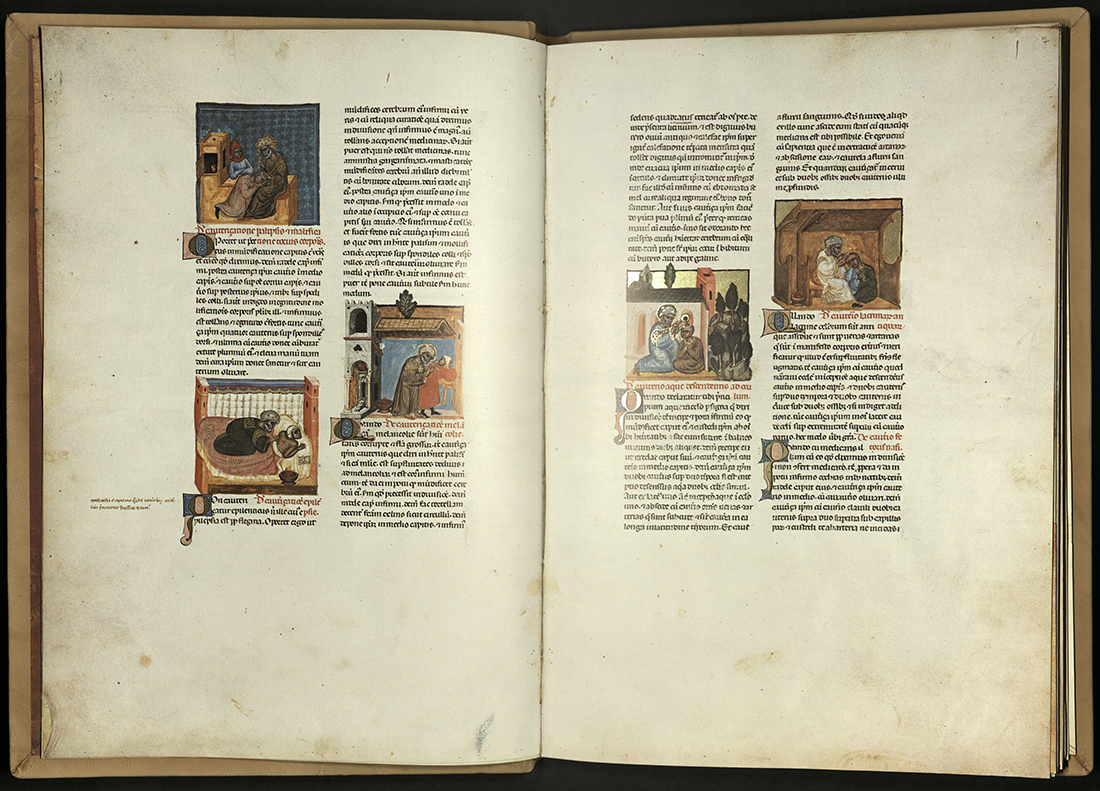
ON SURGERY (CHIRURGIA)
Abu al-Qasim Khalaf ibn ‘Abbas al-Zahrawi, translated into Latin by Gerardo of Cremona, fourteenth century
Vienna, Österreichische NationalBibliotheck, Cod. Vindob. ser. n. 2641
Graz: Akademische Druck-u. Verlagsanstalt, 1979
RD30 A2816 1979
This book on surgery was written by tenth-century Arab physician and surgeon, Abu al-Qasim Khalf (d. 1013), who served as court physician to the caliph, Abdur-Rahman III (912-961) in Cordova, Spain. The book is the last part of what was originally a thirty-volume compendium of current medical knowledge. Only a small portion of this monumental work was made available to the west through translation.
The part dedicated to surgery, presented here, was first translated into Latin by the Italian, Gerardo of Cremona (1114-1187), during the twelfth century. That translation provided a significant source of medical knowledge. With Abu al-Qasim’s understanding and use of Galen and Hippocrates, his text was important in linking classical Greek and European medicine. Chirurgia supplies practical information about various medical interventions from midwifery to cauterization.
This particular manuscript, which dated to the fourteenth century, is decorated throughout with a series of sixty-eight miniatures illustrating in graphic detail the various procedures described in the text. Forty of the miniatures appear in the first of the three books that make up the work. The figures are painted boldly. Most of them show a capable physician, whose competence is revealed by the control and mastery he has over the procedures he is executing. The patients by contrast appear somewhat helpless, but nevertheless pleased he is in good hands.
The miniatures shown above all pertain to cauterization procedures for a variety of ailments, including melancholy and epilepsy. Many of the initials are highlighted in gold to aid the reader, together with the miniatures, in locating various sections of the text.
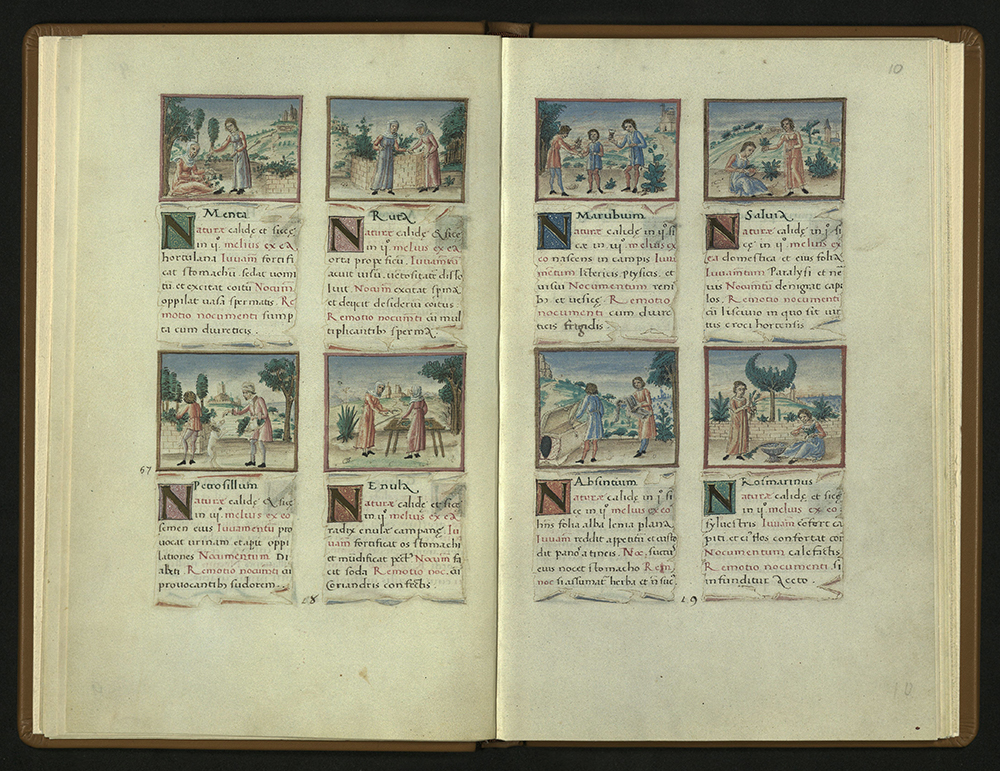
HANDBOOK OF HEALTH (TACUINUM SANITATIS)
c. 1480
Vienna, Österreichische NationalBibliotheck, Cod. Vindob. 2396
Graz: Akademische Druck-u. Verlagsanstalt, 1984
RS79 T33 1984
The term “tacuinum” derives from the Arabic word, taqwīm, meaning “table” or “catalogue,” as in a table of contents. “Sanitatis” refers to the information contained within the book, pertaining to human health and well-being. A “tacuinum sanitatis” is therefore a kind of encyclopedia of health that describes the healing properties of plants, animals and minerals. As is the caser with the other two health handbooks in this exhibition, the text of this book is based on the Taqwīm al-sibbah of Ibn Butlan (d. 1066).
The delicately colored illustrations of the various elements treated in the text, are made four to a page, all of them neatly framed to make them more legible. The colored miniatures only continue to folio 17 verso. The rest of the book consists of drawings that were clearly created for painting like the others. Altogether, the drawings and the painted illustrations number two hundred ninety-four. Those shown here illustrate various herbs that could be used for home remedies. They include mint, sage, and rosemary.
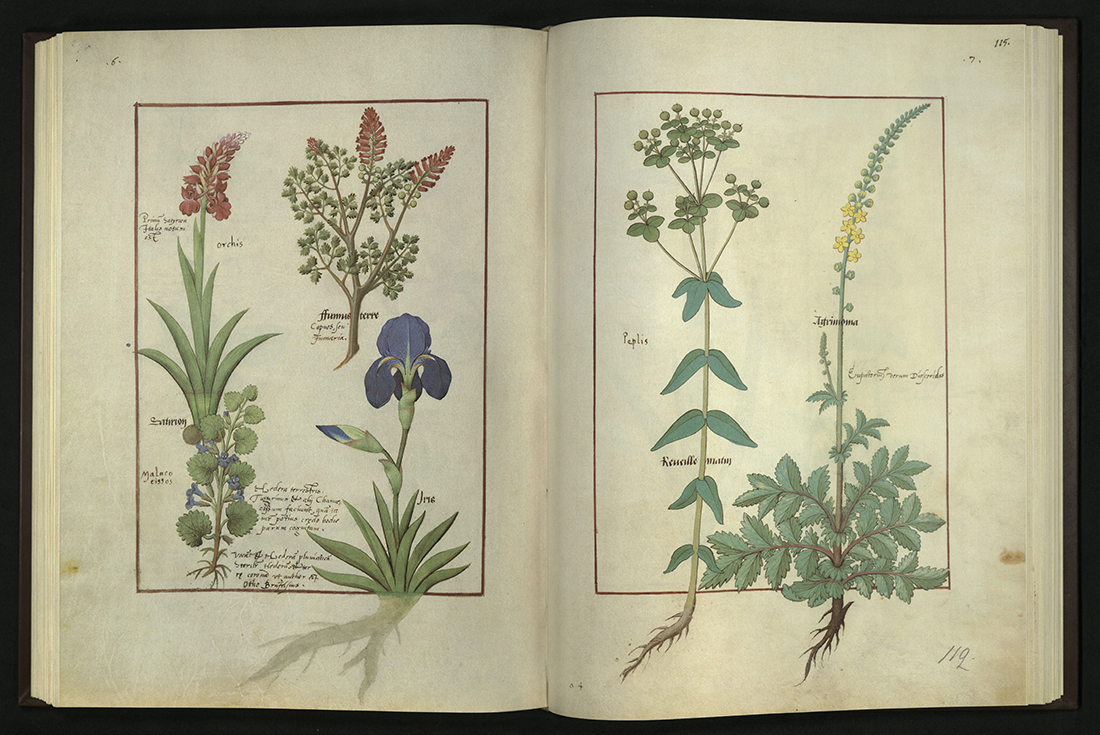
BOOK OF SIMPLE MEDICINES (DE SIMPLICI MEDICINA)
Matthaeus Platearius, c. 1470
St. Petersburg, National Library of Russia
Barcelona: M. Moleiro Editor, 2000
Edition of 987 copies. Rare Books copy is no. 802
RS81 P614 2000
The Book of Simples is one of the best known and most important pharmacopoeias of the Middle Ages. It was written in Latin originally, by Matthaeus Platearius (d. 1161). The St. Petersburg manuscript, here in facsimile form, is a French translation. Robinet Testard, an artist who was in the employ of Charles Angouleme, illuminated this beautiful manuscript for a noble woman, possibly Louise of Savoy, the wife of Charles Angouleme. With the exception of eleven miniatures that appear incorporated in with the text, all the rest of the one hundred and twenty-seven illustrations are gathered together and appended to the end of the book.
The pages shown above give an idea of the beauty and detail of these colored illustrations. The Iris is particularly stunning, not only for the brilliance of the colors used, but for the naturalism with which the delicate flower is portrayed. It is important to note the attention paid to depicting the roots together with the leaves, and the flower in full bloom as well as in bud when possible. This was to ensure that the viewer would be able to identify the plant no matter what stage of development it was in.
RELIGIOUS TEXTS
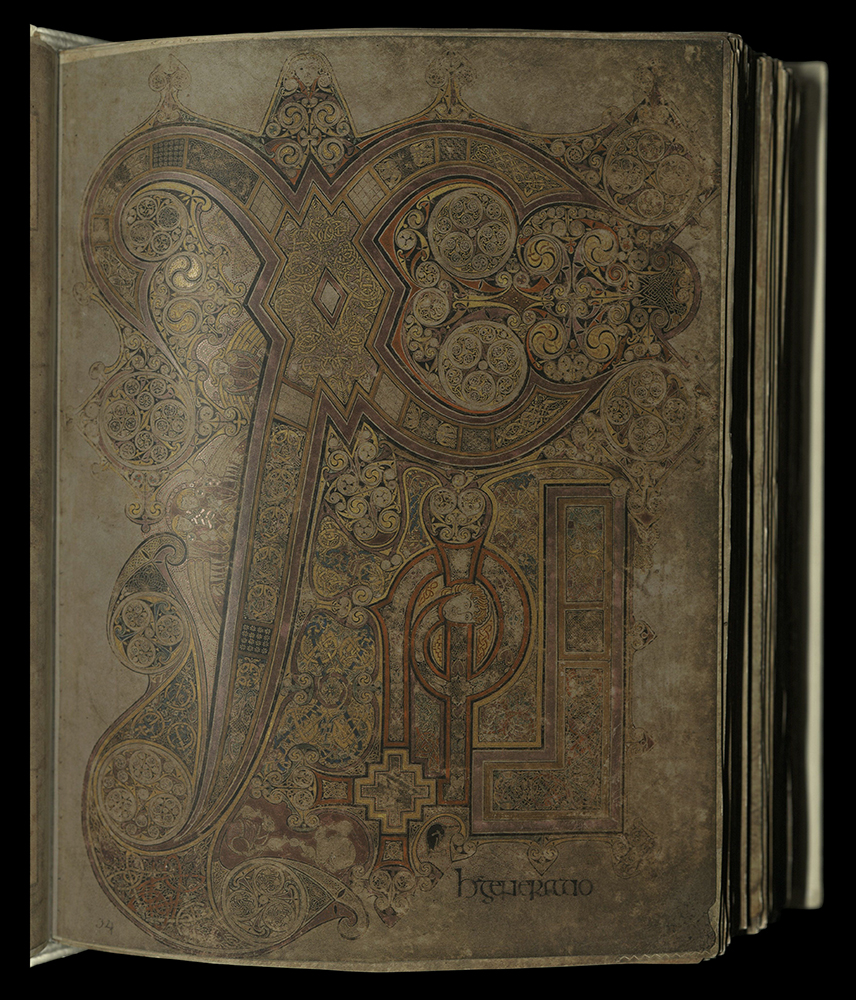
THE BOOK OF KELLS
c. 800
Dublin, Trinity College Library, Ms. 58 (A.I.6)
Lucerne: Faksimile-Verlag, c. 1990
Edition of 1480 copies
ND3359 K4 B65 1990
Donated by the George S. and Dolores Dore Eccles Foundation, in appreciation of Elizabeth Libby Fuhriman Gardner, First Lady, University of Utah, 1973-1983
The Book of Kells is one of the supreme achievements of medieval illumination. Precisely when and wh3ere it was made has never been determined. However, it is thought that it was produced around 800 at Iona off the west coast of Scotland, and brought to Kells in 804 by Irish monks fleeing from Viking raiders. The Gospel Book was preserved at Kells, County Meath, Ireland, certainly from the twelfth century, and is now considered Ireland’s premier national treasure. The Book of Kells, as it is known today, is a Latin copy of the four Gospels of the Bible. It is written on calf vellum and painted in what is called the Insular style. In terms of the profusion, variety and perfection of its decorations, this book has no equal, as is plainly evident from the page above.
The illumination shown illustrates the Xpi, which are the first letters of Christ’s name in Greek. The page belongs to the opening of the Gospel of Saint Matthew. On this magnificent page, the letters, with their purple and orange outlines, can be distinguished against the densely decorated patterns. The regularity and precision of the twisting interlace in between, give the impression of a dynamic, elegant calligraphy.
In addition to the intricate patterning, the manuscript is alive with representations of human heads, animals, birds, moths, and even an otter eating a salmon, the latter symbolizing Christ’s sacrifice. The special nature of this book is a reflection of the beliefs of its creators. As the great art historian Otto Pächt, so aptly stated: “The book was a source of faith made palpable: it not only contained the Gospel, it was the Gospel.”
Hence, just as Christ was the word made flesh, so are the words and letters of the book the living word of God. A famous passage from Grialdus Cambrensis’ (d. c. 1220) Topographia Hiberniae describes the Medieval experience of viewing a book like this one: “Fine craftsmanship is all about you, but you might not notice it. Look more keenly at it and you will penetrate to the very shrine of art. You will make out intricacies, so delicate and subtle, so exact and compact, so full of knots and links, with colours so fresh and vivid, that you might say that all this was the work of an angel, and not of a man…For my part the oftener I see the book, and the more carefully I study it, the more I am lost in ever fresh amazement, and I see more and more wonders in the book.”
The original manuscript is continually on display today at Trinity College Library, Dublin. Each day a new page is turned for the viewer.
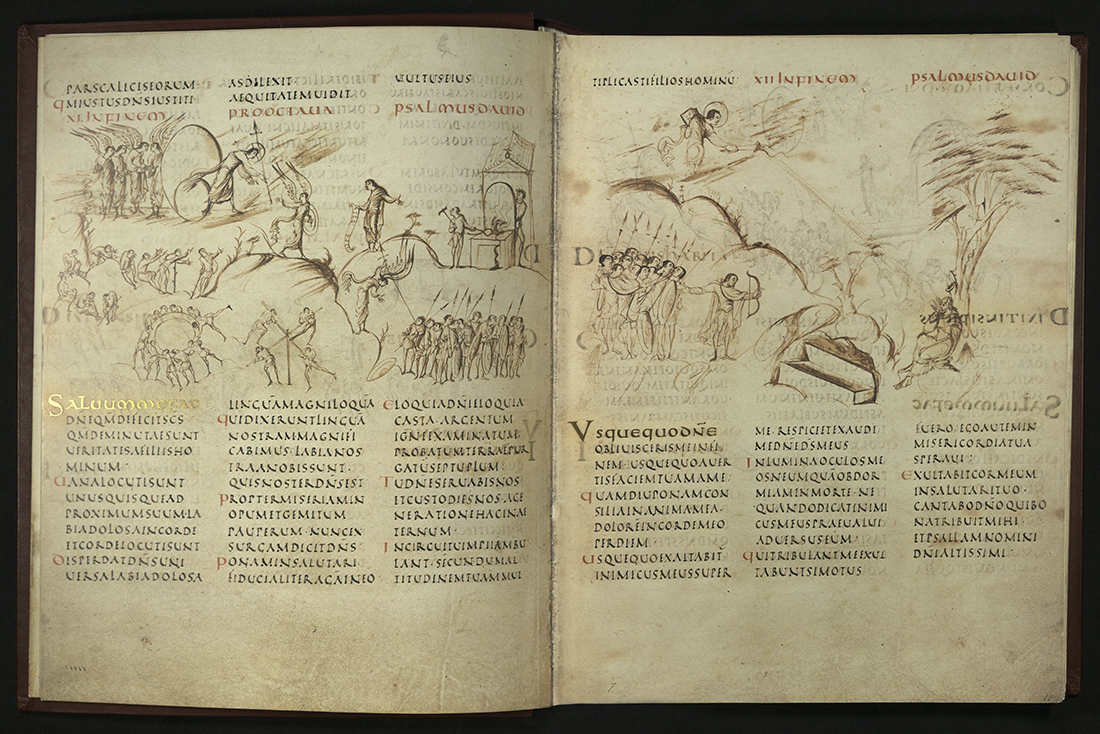
THE UTRECHT PSALTER
c. 820-840
Utrecht, Bibliotheek der Rijksuniversiteit, Ms. 32
Graz: Akademische Druck-u. Verlagsanstalt, 1982-1984
BX2033 A35 V86 1982
The Psalter is a book comprised of the one hundred and fifty Biblical Psalms. The word psalm comes from the Greek, psalmos meaning “song.” The psalms were originally recorded in Hebrew, and then translated into Latin by Saint Jerome at the end of the fourth century. Jerome was responsible for three versions of the Psalter, the most popular of these during the Middle Ages being the one employed here, called the Gallican Psalter. The Psalms were extremely important to religious practice in the Middle Ages. Monks and nuns recited the entire Psalter once a week. And the laity liked to include the psalms in their private devotionals, as they were easily understood and, not being time-specific, they could be recited at any time.
The Utrecht Psalter (shown here in facsimile) is one of the great, illustrated manuscripts of the Carolingian period. It was produced at the Benedictine abbey of Hauvillers near Reims at the behest of the Archbishop Ebbo of Riems, a foster-brother of Emperor Louis the Pious. The Utrecht Psalter is both the earliest and most unusual surviving illustrated Psalters of the Western Middle Ages.
Spirited drawings accompany the text on every page. The psalms provided a special challenge to the artist, because they do not tell stories that can be easily translated into a visual narrative. The rapid pen and ink drawings of the Utrecht manuscript thus illustrate only particular lines of the psalms, as in the page shown above, which illustrates Psalm 12, verses 4 and 5. Here the psalmist, shown on the far right sitting against a tree, has asked how long the Lord will allow his enemy to prevail. He begs the Lord to “lighten” his eyes “lest I sleep the sleep of death; Lest mine enemy say, I have prevailed against him.” In the upper left, the Lord is shown sending rays of light toward the eyes of the psalmist to “lighten” them. The sarcophagus in the middle foreground alludes to “the sleep of death.” On the left is the group of enemies armed with lances. One of them stand in front and menaces the psalmist with a bow.
In some cases, the illustrations do not correspond to the Gallican translation of the psalms used in the Utrecht Psalter, but follow instead another version known as the Hebraicum. The illustrations are therefore considered to have derived from an earlier, possibly Late Antique manuscript. The script of the Latin text is Roman rustic, written in majuscules, giving the manuscript a classical appearance.
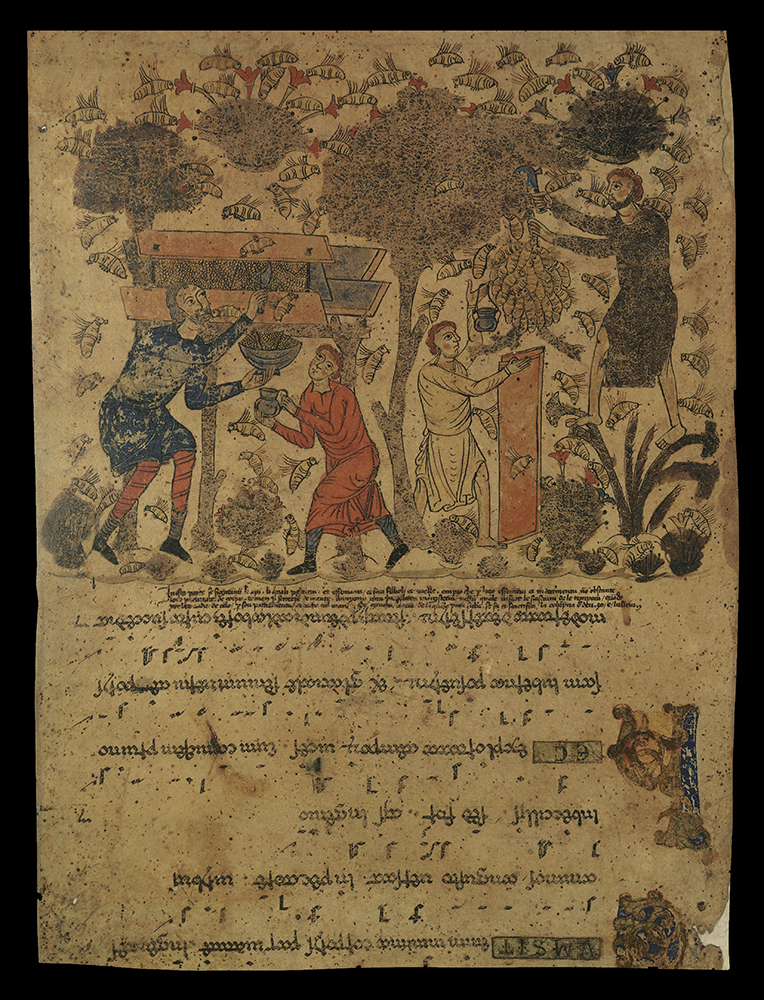
BARBERINI EXULTETROLLE
Tenth century
Vatican City, Biblioteca Apostolica Vaticana, Ms. Vat. Bart. lat. 592
Zurich: Belser Verlag, c. 1988
ND3380.4 B37 E36 1988
The Barberini Exultetrolle is the oldest surviving exulted scroll. The Exultet was a prayer used in the Latin liturgy during the Easter Vigil for the benediction of the candle. It was chanted by the deacon, who would sing the “Exultet” from the ambo. A type of musical notation used in the Middle Ages, called neumes, appear over the text to guide the deacon’s chant (incipit exulted iam angelica turba caelorum…, now the heavenly host of angels shout for joy). The text of the Exultet scroll was written in the opposite direction of the illuminations. That way the scroll could be arranged to hang over a railing, so that the deacon could see the text to be read, while at the same time the congregation could follow the recitation through the pictures on the opposite side.
The Barberini Exultetrolle was produced at the Benedictine abbey of Monte Casino around 1087. Only five sections of the original survive. The illuminations were painted before the text was written. They vary in quality and appear to be the work of two different artists.
The portion above shows two men gathering beeswax (on the left) and another two trying to smoke some bees out of their hive (on the right). The image illustrates the praise of bees, which is a reference to Mary’s virginity.
Accompanying Latin and Italian inscriptions appear on the scroll. These are thirteenth-century additions, made by monks carrying out an early restoration of the manuscript.
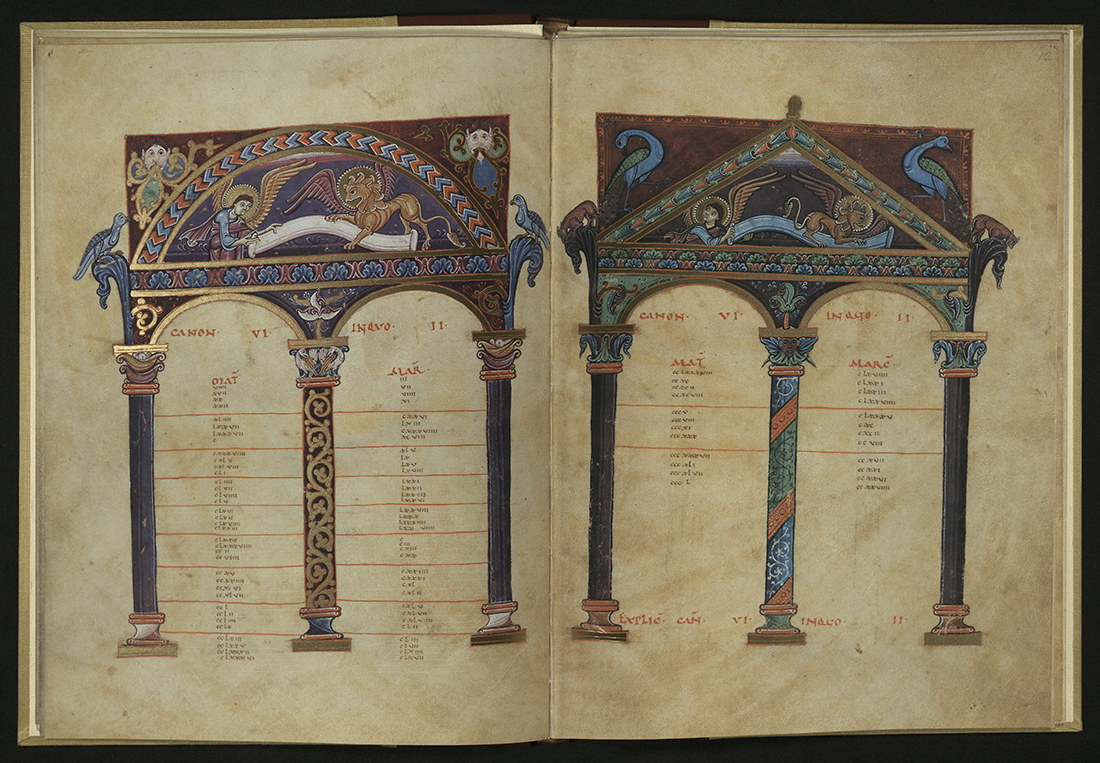
THE GOSPEL HARMONEY OF EUSEBIUS
Eusebius Pamphilii of Caesarea, eleventh century
Brescia, Biblioteca civica queriniana, Codex F. II. 1.
Graz: Akademische Druck-u. Verlagsanstalt, 1991-1992
BX2005 A35 C58 1991
The Gospel Harmony of eusebius contains the concordance, or canon table, of the Gospel of the Bible, created by Eusebius Pamphilii, Bishop of Caesarea in Palestine (active c. 300-340). Eusebius was an ecclesiastical historian and one of the most learned men of his age. His canon tables were composed as an aid for the study and exegesis of the four Gospels.
The Brescia manuscript, shown here in facsimile form, is one of the masterpieces of Ottonian manuscript illumination from the School of Reichenau. It is richly ornamented with gold, and the bold bright colors typical of Ottonian miniature painting. The codex begins with nineteen different architectural arches, all classical in style, surrounding Eusebius’ Gospel Harmony. Since the canon tables only make sense in conjunction with the Gospel, the Gospel Pericopes follow. Eleven full-page miniatures and twelve ornamental initials serve to mark the feast days of the readings. It is now understood that the two portions of the book – the canon tables and the Gospel Pericopes – were actually executed at different times and then brought together at some later date.
The page shown above comes from the section of the book containing Eusebius’ canon tables. It is decorated with the symbols for the Evangelists, Saint Matthew (the winged man) and Saint Mark (the lion). The beauty of the canon tables, and the care lavished on their adornment, are amply illustrated by this page.
The importance of decorated canon tables is eloquently stated by Carl Nordenfalk, one of the great scholars of illuminated manuscripts. He writes, “[Eusebius’] canon-tables partook in the sacredness of the Holy Word which they prefaced, and made them entitled to an unusually splendid adornment of their setting that pleases the eye and more than anything else accounts for the wide distribution of Eusebius’ invention and the tenacity with which it survived.”
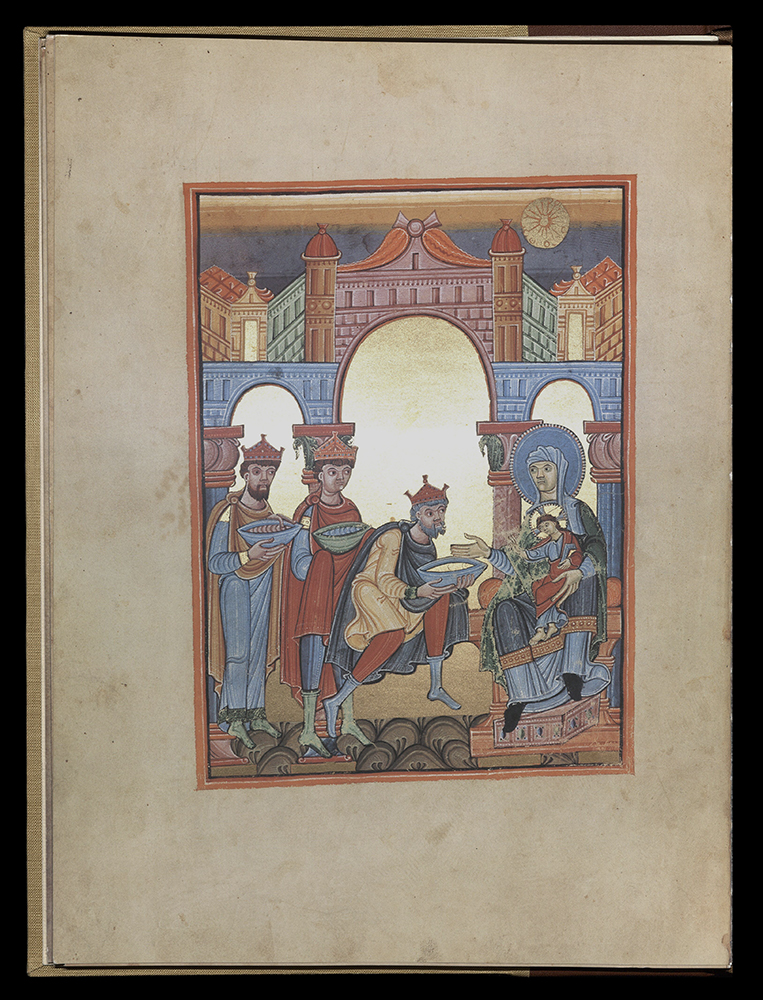
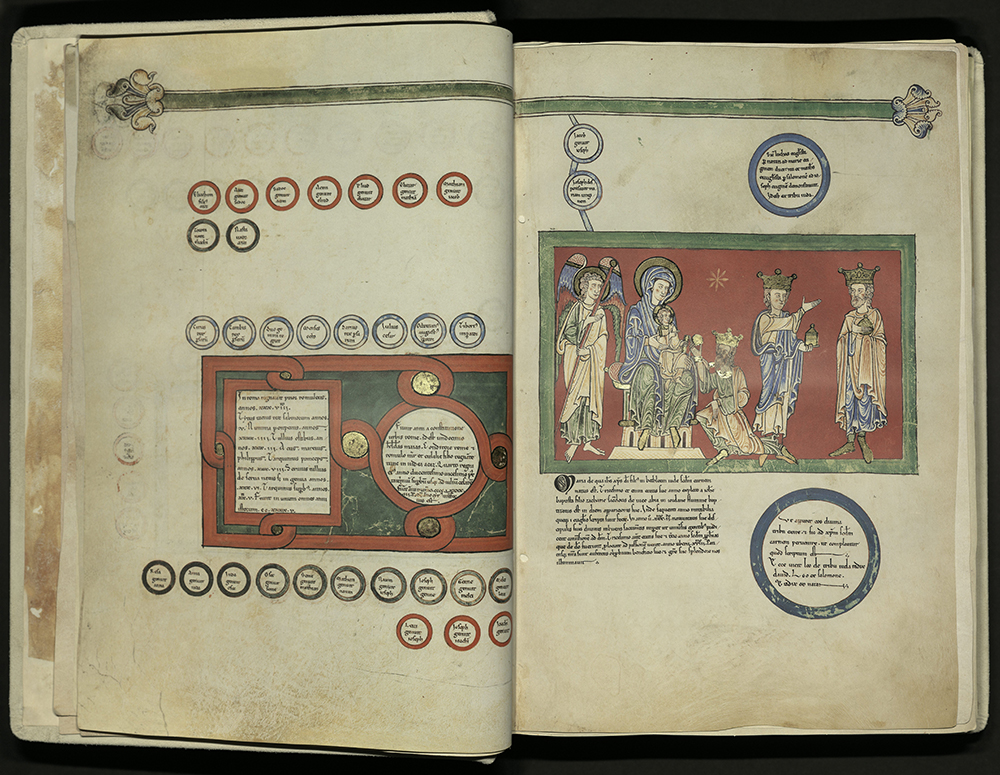
COMMENTARY ON ST. JOHN THE EVANGELIST'S REVELATIONS (IN APOCALIPSIN)
Saint Beatus, presbyter of Liébana, twelfth century
Cardeña, Monastery of San Pedro
Barcelona: M. Moleiro Editor, 2000
Edition of 987 copies
BS2825 B4 2000
Saint Beatus of Liébana (730-798), a Spanish theologian and geographer, wrote his famous commentary on the Apocalypse of St. John in 776. To this, he attached one of the oldest Christian world maps to illustrate the various apostolic missions around the world. He made some later revisions to the manuscript in both 784 and again in 786, ultimately shaping it into an offensive against heresy. To compose his text, Beatus collected other commentaries by a variety of writers, including the church fathers, Saints Jerome, Augustine, and Ambrose, and other writers like Fulgentius. The Commentary was primarily directed toward and used by monks.
This particular copy was written out in Carolingian/early Gothic script between 1175 and 1185, at the Monastery of San Pedro de Cardeña. Two unknown artists, no doubt both of them monks, were responsible for the many illuminations throughout.
The folio above shows as boldly colored miniature of the Adoration of the Magi, together with the genealogy of Christ.
The binding is made of a lovely cream calfskin studded with metal bosses.
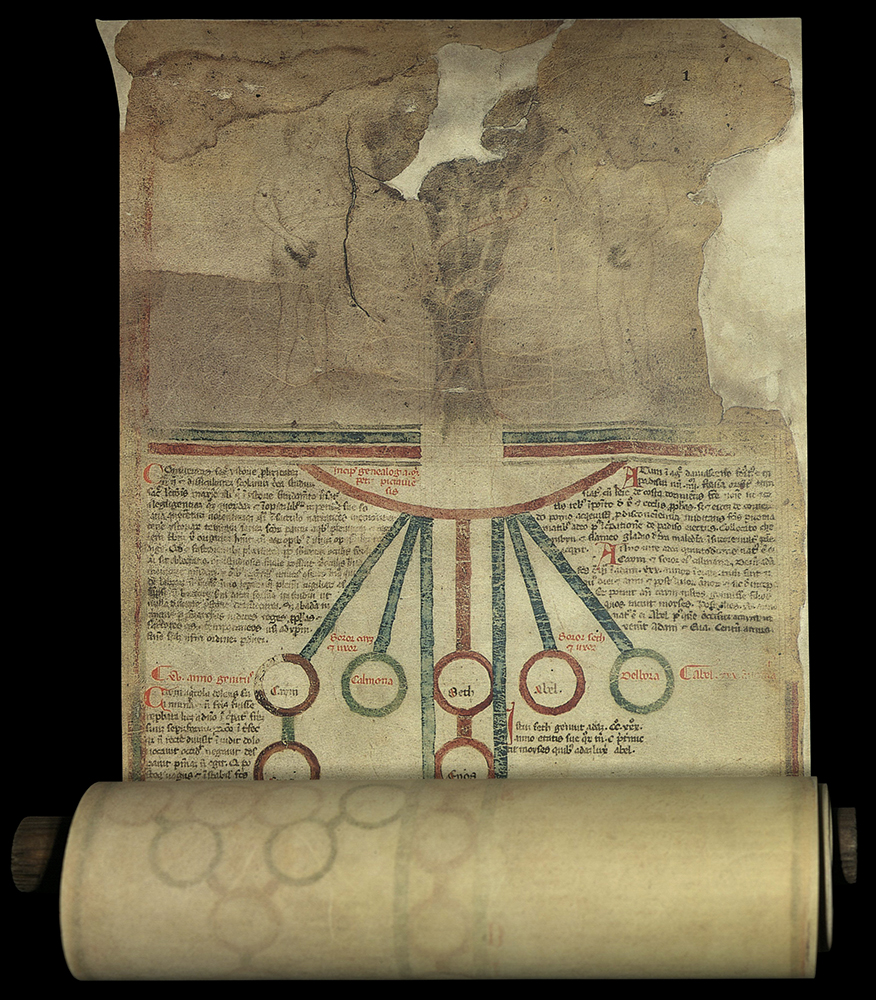
GENEALOGY OF CHRIST (GENEALOGIA JESU CHRISTI)
Peter of Poitiers, thirteenth century
Rome, Biblioteca casanatense 4254 (Roll MS)
Barcelona: M. Moleiro Editor, 2000
Edition of 987 copies
BT314 P47 2000
Although we do not know who wrote the Genealogy of Christ, its authorship has been attributed to Peter of Poitiers, who served as Chancellor of the University of Paris from 1193 to 1205. The Genealogy of Christ, which we believe he wrote, is a version of biblical history in an abridged from intended as an aid to understanding the Bible in a historical sense. This particular manuscript version, like others of its kind, contains a genealogical tree that unrolls to show the lineage of Christ from Adam (shown at the top together with Eve), to his resurrection. Genealogical trees like this one served as memory aids and may have been used in classrooms where they would have hung on the walls.
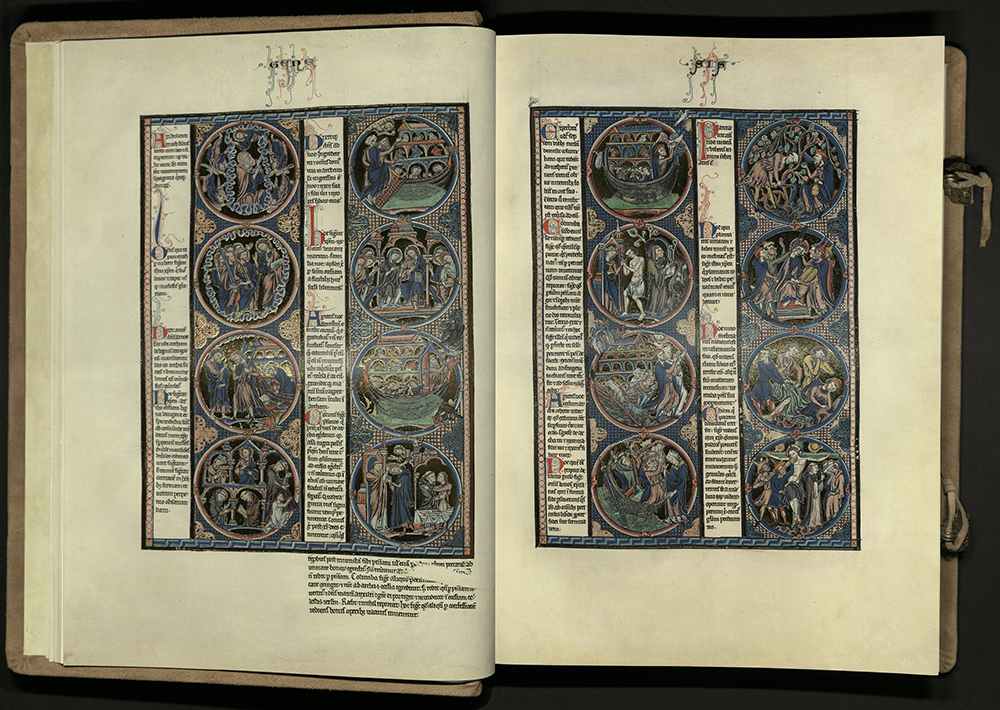
THE BIBLE OF ST. LOUIS (LA BIBLIA DE SAN LUIS)
The creation of Guillaume d’Auvergne, Bishop of Paris, thirteenth century
Toledo, Treasurey of the Cathedral of Toledo
Barcelona: M. Moleiro Editor, 2000-2001
Edition of 987 copies. Rare Books copy is no. 118
BX89 S36 2000
Volumes containing the complete Bible were rare before the ninth century. It was more common to produce individual books of the Bible, of which some of the volumes in this exhibition are good examples. During the eleventh and twelfth centuries, religious reforms encouraged a greater interest in Bible production. By the thirteenth century, a major revision in the organization of the Bible was taking place at the University of Paris. The result was the so-called Paris Bible, which was the basis for many of the early printed bibles.
The manuscript here in facsimile form was produced in Paris during this period of reform in the thirteenth century. It was commissioned by Blanche of Castile for her son, Louis IX (Saint Louis), the King of France, who then presented it to King Alfonso X the Wise of Castile. Because this was a royal production, the book is more sumptuously decorated than others. Nearly 5000 medallions, organized in two columns down every page, were painted to illustrate the scenes described in the text. The colors blue, red, gold, with occasional orange and green touches, remain uniform throughout.
The medallion on the left page of the top of the second column in the image above, illustrating the Adoration of the Magi, is one of the most beautiful images in the book. The three kings are arranged in a lyrical manner, curving one over the other, in adoration of Christ with His mother, whose sinuous elegance is accentuated by the dazzling bright blue robe she wears.
To preserve the integrity of the images and text, only the front sides of the pages were decorated. This added to the expense and magnificence of the whole production.
The facsimile is noteworthy for the skill with which the miniatures have been reproduced to give a very real sense of the brightness of the colors and the radiance of the gold in the original illuminations. The paper for this facsimile was specially handmade to replicate the thickness, feel, and odor of the original.
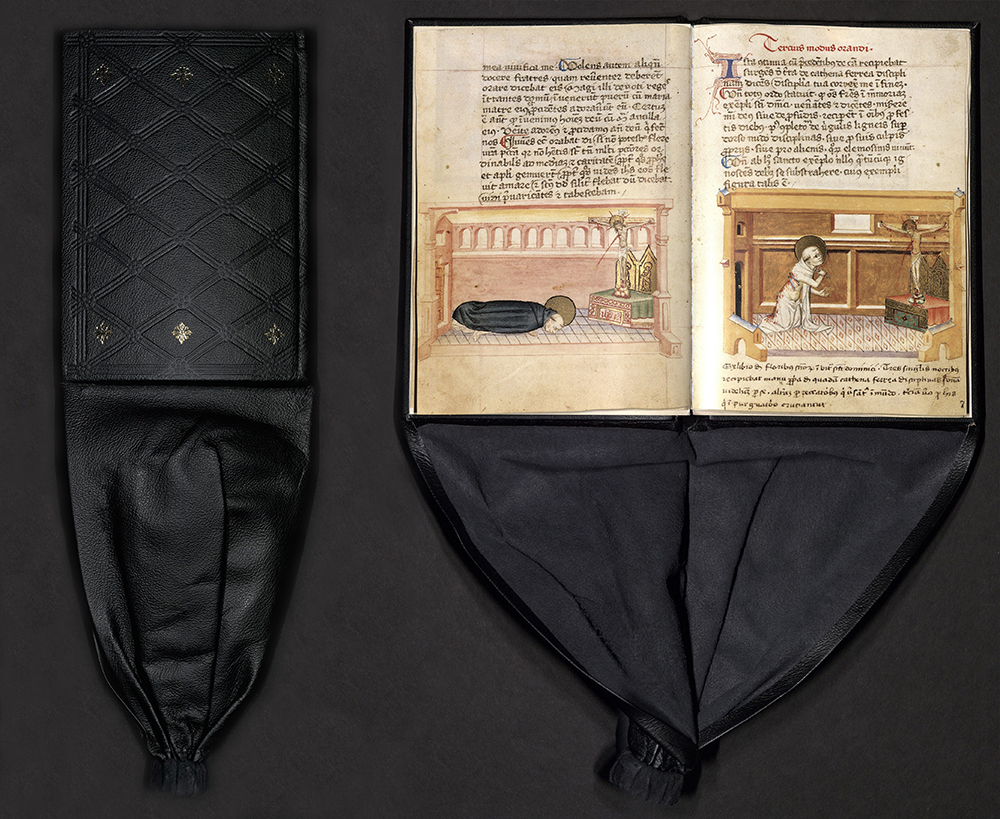
MODES OF PRAYER OF ST. DOMINIC (MODI ORANDI SANCTI DOMINICI)
Fourteenth century
Vatican City, Biblioteca Apostolica Vaticana, Codex Rossianus 3
Zurich: Belser Verlag, 1995
Edition of 900 copies. Rare Books copy is no. 876
BX2050 D7 M63 1995
This Dominican prayer book was composed between 1260 and 1288, by a Bolognese Dominican preacher. Saint Dominic had spent time in bologna in both 1219 and again in 1221. The book describes the various attitudes of prayer – nine in all – that Saint Dominic had been observed to exercise by an eyewitness who related his experience to the author of the text. The attitudes were exercised as a way to enhance prayer, by expressing the emotions experienced, while in the act of praying. These attitudes of prayer gave rise to a rich visual tradition to aid Dominican friars in their devotions, in imitation of the founder of their order.
In this manuscript, which was created in the south of France around 1330, nine miniatures illustrate the different modes in which Saint Dominic was known to pray. Two of these are shown above. In one of them, Dominic is shown prostrate on the floor, while in the other he is shown flagellating himself.
The book is made with an extra portion of leather attached to the binding in the form of a girdle book, so that it could be worn hanging from the belt of a monk’s habit. This would enable its owner to keep the book with him at all times, and to pick the book up and refer to it throughout the day without detaching it from his clothing.
The facsimile version is exceptional for bringing out the glowing beauty of the original miniatures, as well as for its duplication of the format and binding of the original manuscript.
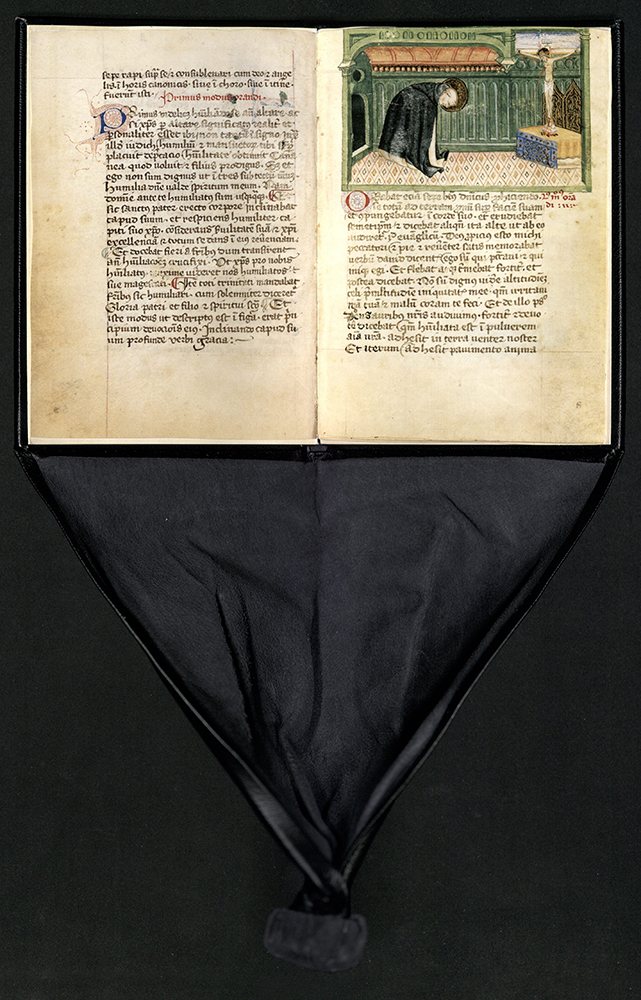
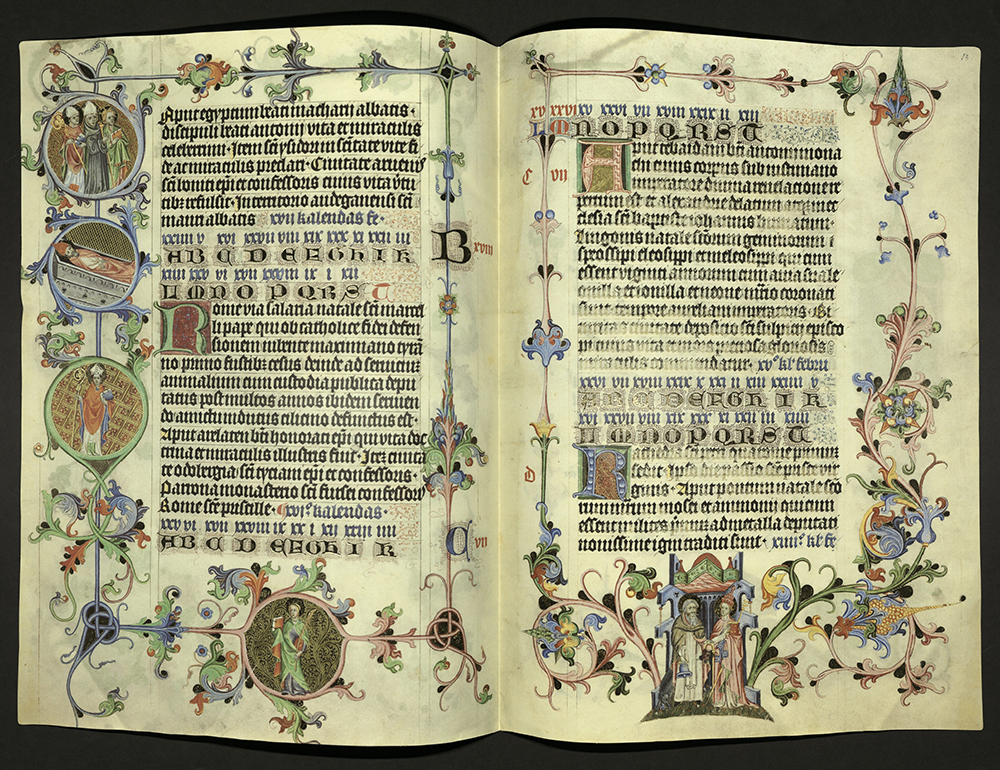
COMPENDIUM OF ALL THE MARTYRS OF THE CATHOLIC CHURCH (MARTIROLOGIUM USUARDI)
c. 1400
Gerona, Museo Diocesà de Girona
Barcelona: M. Moleiro Edititor, 1990
ND3385 M37 1990z
This magnificent leaf is a facsimile excerpt from the Martirologium Usuardi, produced in Prague at the beginning of the fifteenth century for King Wenceslas IV, the emperor and King of Bohemia. The entire text is presented in the form of a calendar. The names of each of the catholic maryrs are listed on their appropriate dates, together with descriptions of the way in which they were martyred. More than half of the two hundred and fifty-two leaves of the original manuscript are decorated with over seven hundred illuminations, executed in the sumptuous International Gothic style. Each miniature illustrates the martyrdom of one of the saints described in the text, and is executed with great care and delicacy, in exquisite colors and with a liberal use of gold. The capital letters, written in Carolingian script, are highlighted in gold, and add to the luxurious feel of the whole.
The paper for the facsimile is handmade to duplicate the thickness, feel and scent of the original, to give the viewer a better sense of the gorgeous manuscript it reproduces.
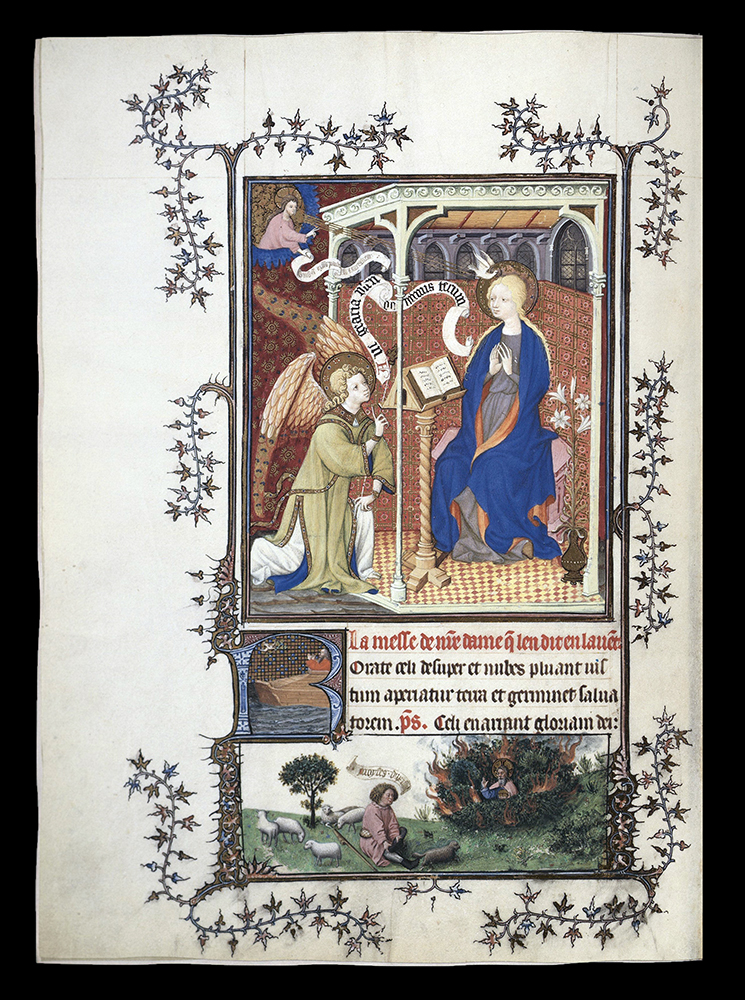
THE TURIN-MILAN HOURS
Fifteenth century
Turin, Museo civico d’arte antica, Inv. no. 47
Lucerne: Faksimile-Verlag, 1994
Edition of 980. Rare Books copy is no. 677.
ND3363 T87 T87 1994
The Turin-Milan Hours has had a long and complex history, which is reflected in part by the title assigned to it. The manuscript, as it was originally conceived, was commissioned in France by John, the Duke of Berry (1340-1416), one of the truly outstanding patrons of illuminated manuscripts. The book was probably begun around 1382, and subsequently abandoned for more than twenty years. In 1405, work on it was begun again by new artists, including, in part, the famous Limbourg brothers. The manuscript was still incomplete in 1413, when the Duke decided to present it to a certain Robinet d’Estampes in exchange for another book of hours. From there the manuscript went through at least two other patrons and ultimately as many as seven sets of artists. Among the artists attributed with working on the manuscript is the famous Flemish painter, Jan van Eyck.
The manuscript was ultimately dismembered. A portion of it ended up in Milan, another in Turin and still another in Paris, with other parts scattered elsewhere. Thanks to the work of scholars who managed to associate the Milan manuscript with that of Turin, the Milanese portion was relinquished to the Civic Museum of Turin so the two could be united. And it is this portion of one of the most magnificent book productions ever conceived that has been duplicated here in facsimile form.
The image above is one of its most beautiful pages illustrating the Annunciation. The miniature is painted with bright colors that give the whole image a warm elegance. The angel Gabriel is shown on the left with a scroll on which are printed the words of the “Hail Mary. In Latin, “Ave Maria gratia plena dominus tecum.” Above him, God the Father appears sending the dove of the Holy Spirit on rays of light toward Mary, who demurely accepts her new role as the Mother of God.
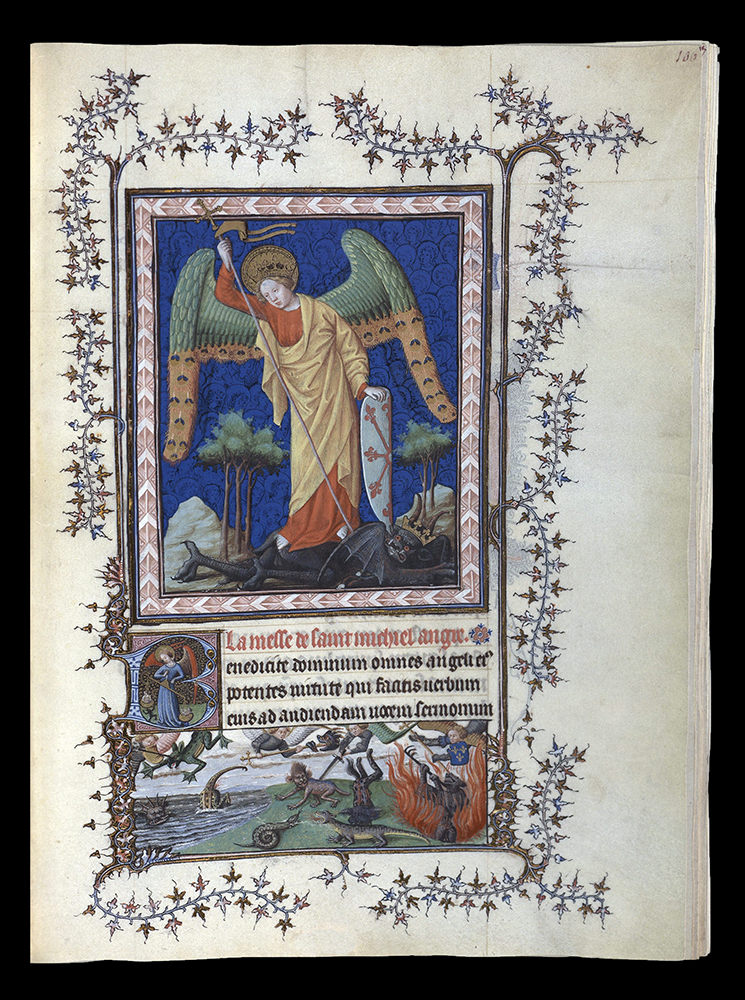
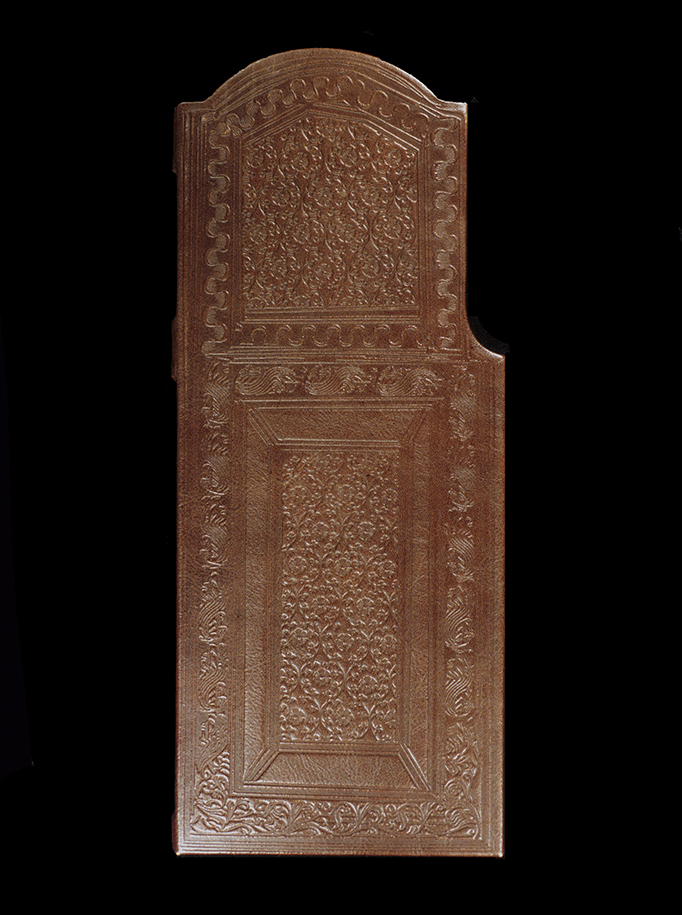
THE "BOOK ALTAR" OF PHILIP THE GOOD OF BURGUNDY (BUCHALTÄRCHEN = LIVRE-AUTEL)
c. 1430-1450Vienna, Österreichische NationalBibliotheck, Cod. 1800
Lucerne: Faksimile-Verlag, c. 1991
Edition of 980 copies. Rare Books copy is no. 130
ND3380 B82 1450a
This portable altar, produced in Burgundy, is one of the most unique creations ever produced. It combines both an illuminated manuscript and a retable to form a portable altar. The piece was executed for Philip the Good, Duke of Burgundy (1419-1467), one of the great patrons of high-quality illuminated manuscripts, to take on his many travels. The cover is made of two thick panels of wood bound together by hinges to form a diptych. The panels open to reveal two paintings. The one on the left depicts the Trinity, with God the Father, the Holy Spirit (portrayed by a winged angel), and the crucified Christ. On the opposite side is a representation of the Coronation of the Virgin. Below, a little book is attached. It consists chiefly of prayers to the Trinity and the Virgin, to correspond with the paintings above, and the particular devotions of the Duke.
The pictures in the book, numbering three in all, were executed in 1450, twenty years after the paintings of the diptych, and by a different artist. Philip the Good is shown in prayer in each of the miniatures. In the first, he appears kneeling, together with his son Charles, before a diptych on which are painted images of the Crucifixion and the Madonna and Child. The other two miniatures depict the Mass of Saint Gregory, and the Virgin Mary.
The latter, shown above, portrays the Virgin in a blue dress ornamented with wheat stalks, that alluded to Philip’s special devotion to the Madonna del Coazzone, a marble statue of the Virgin in the Cathedral of Milan. The Madonna del Coazzone was considered to have been responsible for a number of miracles and had developed a cult following from 1410.
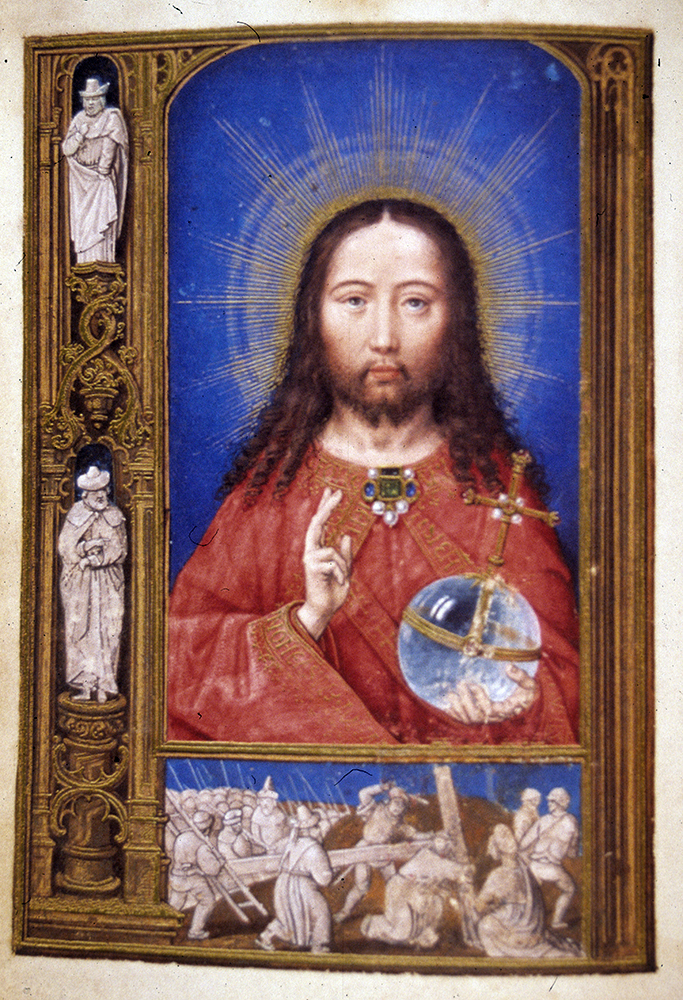
THE FLOWERS BOOK OF HOURS (LE LIVRE D'HEURES AUX FLEURS)
1500?
Munich, Bayerische Staatsbibliothek, Ms. Clm 23637
Lucerne: Faksimile-Verlag, c. 1991
Edition of 980 copies
ND3363 B3 B29 1991
Books of hours were typically portable objects created for the layperson to use for private devotion. They usually included a set of prayers called the Hours of the Virgin, together with psalms for each of the eight separate hours of prayer, and a calendar placed at the front with reminders of the various saints to be honored each day. According to the tastes of the patron, the sections could be supplemented with such things as gospel lessons, readings from the Masses of important feast days, the Hours of the Cross, the Hours of the Holy Spirit, the seven penitential psalms, the Office of the Dead, and two special prayers to the Virgin. With the advent of printing, illuminated books of hours gradually became more and more elaborate, until in the sixteenth century they developed into objects of display rather than of use.
The Flowers Book of Hours is one of the most beautiful illuminated manuscripts produced during this period. It was painted by Simon Bening, who was one of the great Flemish illuminators of the sixteenth century. Bening worked primarily in Ghent and Bruges and was known for the quality of his unusual work. He created a number of lavish Books of Hours for aristocratic patrons who valued the beauty of his illuminations. Bening knew how to cater to the needs of his public that now demanded exaggeratedly luxurious manuscripts. The Flowers Book of Hours is a case in point. With its rich use of golden borders containing beautifully rendered flowers, birds and insects around the text on each page, it is clearly one of the most sumptuous manuscripts ever made. In addition, no less than seventy full-page miniatures are placed throughout the book. They depict both religious and everyday scenes in brilliant colors, and with the detail and liveliness that only Bening, the supreme master illuminator, was capable of.
The page above shows the Nativity and Adoration of the Child on the left, with the accompanying text surrounded by a luminous gold border, on the right. The brilliance of Bening’s abilities is evident from the dragonfly at the bottom of the right page, painted with delicate wings that overlap the border and spill onto the portion of the page where the text is written.
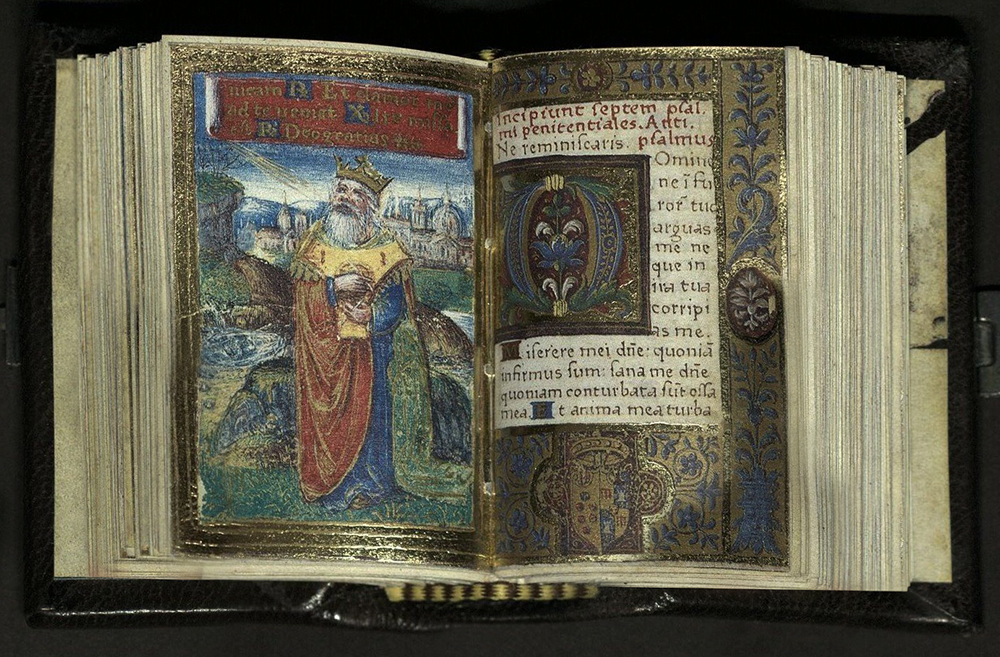
BOOK OF HOURS OF LORENZO II DE MEDICI (LIBRO DE HORAS DE LOS MEDICIS DE LORENZO II, EL JOVAN)
1518
Madrid, Fundación Lázaro Funacion Galdiano, ms. 15512
Madrid: Testimonio Compañia Editorial, 1994
Edition of 980. Rare Books copy is no. 595
BX2080 C372 1994
This magnificent little Book of Hours was created for the Medici Pope, Leo X, in celebration of the marriage of his nephew, Lorenzo II de’ Medici, “the younger,” and Madeleine de la Tour. Pope Leo X was one of the great patrons of illuminated manuscripts of the early sixteenth century, and this manuscript reflects the style of illumination that the Pope typically favored. The book is written in Latin in rounded classical letters. Eleven pages are decorated with full-page miniatures, and sixteen pages with ornamental borders containing birds, flowers, and insects. Many of the initial letters are ornamented. The type of illumination included in this book became a signature style for books of hours produced for other important Medici weddings (like that for the wedding of Alessandro de’ Medici and Margherita d’Austria in 1536, now in the Biblioteca Corsiniana in Rome; and that for the wedding of Cosimo I de’ Medici and Eleonora di Toledo in 1539, now in the Victoria and Albert Museum in London.)
This particular manuscript is small and would have been admired with the help of a looking glass, like that reproduced here and included together with the facsimile. The book is open to one of the most luxuriously decorated sections of the book illustrating King David on the left and the text of the Psalms on the right, surrounded by a sumptuous border containing the Medici coat of arms in the lower margin.
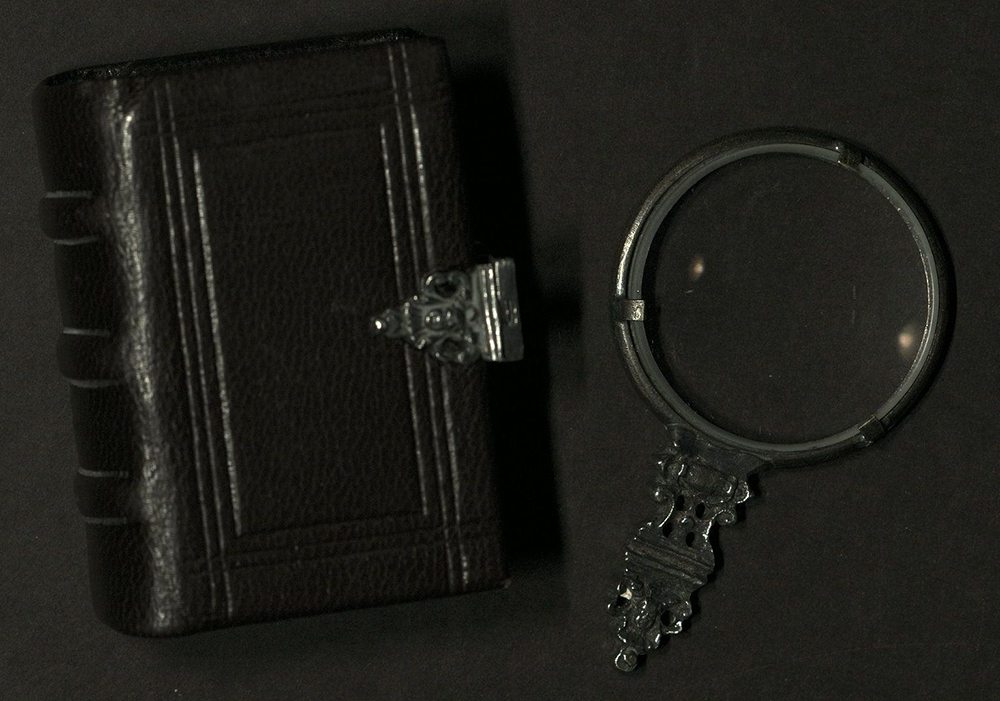
TRAVEL
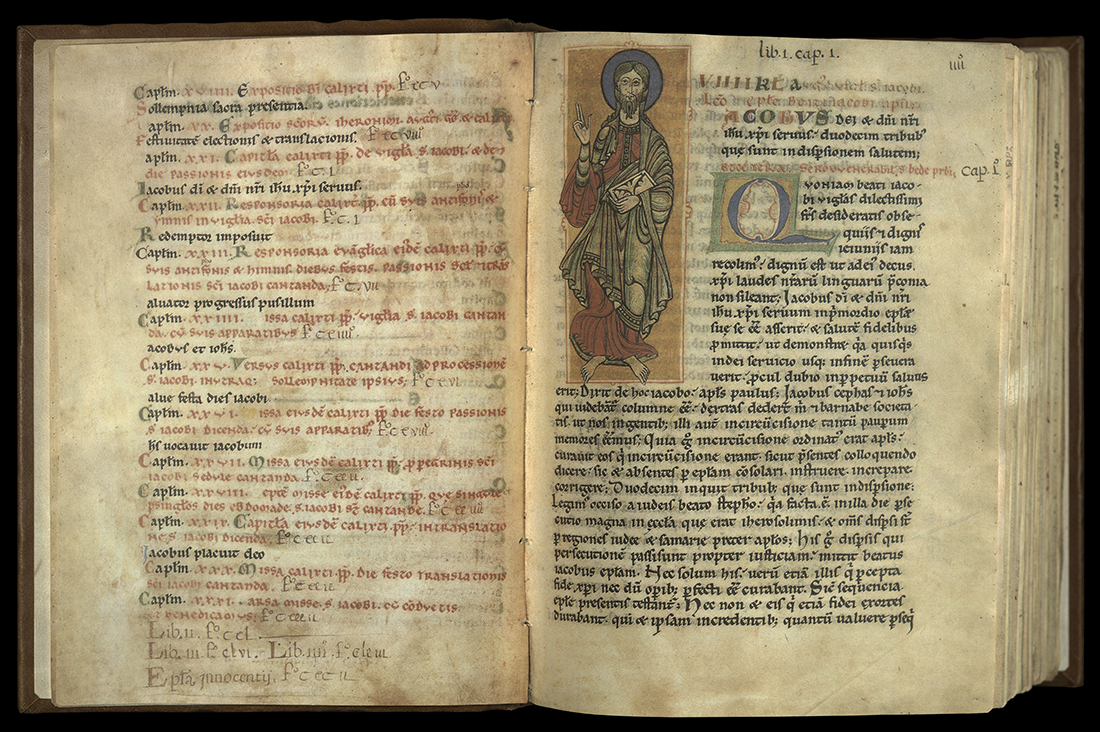
THE BOOK OF SAINT JAMES, THE GREATER (LIBER SANCTI JACOBI, CODEX CALIXTINUS)
Twelfth century
Santiago de Campostela, Archivo de la Catedral de Santiago de Campostela
Madrid: Kaydeda, [1993]
Edition of 995 copies. Rare Books copy is no. 299
BT685.5 C632 1993
This book tells the story of Saint James the Greater, or Santiago. Tradition has it that Saint James preached Christianity in Spain before being put to death by Herod, and that his remains were then miraculously transported back to Spain, finishing in the town of Campostela. During the Middle Ages, Santiago de Campostela became one of the most important pilgrimage sites in the world, and it continues to attract pilgrims today. Saint James, called the Greater to distinguish him from Saint James the Apostle, had endeared himself in the minds of the Medieval Spaniards for the part they believed he played in freeing them from the infidel. According to the text of the Book of Saint James, the Emperoro Charlemagne had been inspired to deliver Spain from Moorish occupation as the result of a vision he had. In it, Saint James revealed to him the location of his tomb in the portion of Spain where the infidels resided, and beseeched the Emperor to liberate it. The text continues with accounts of the numerous miracles attributed to the saint, including those he performed during Charlemagne’s military campaigns against the Moors. Besides recounting these stories, the manuscript provides valuable concrete information about the pilgrimage route to Santiago de Campostela, and as such it is an important source of knowledge about travel during the Middle Ages.
In addition, the manuscript also includes a large section of some of the earliest polyphonic liturgical music that we have. The Codex Campostela, as it is called, was most likely produced between 1130 and 1140 in the south of France. It is written in Carolingian script and decorated with some colored illuminations, such as the one above illustrating Saint James himself, at the beginning of the book.
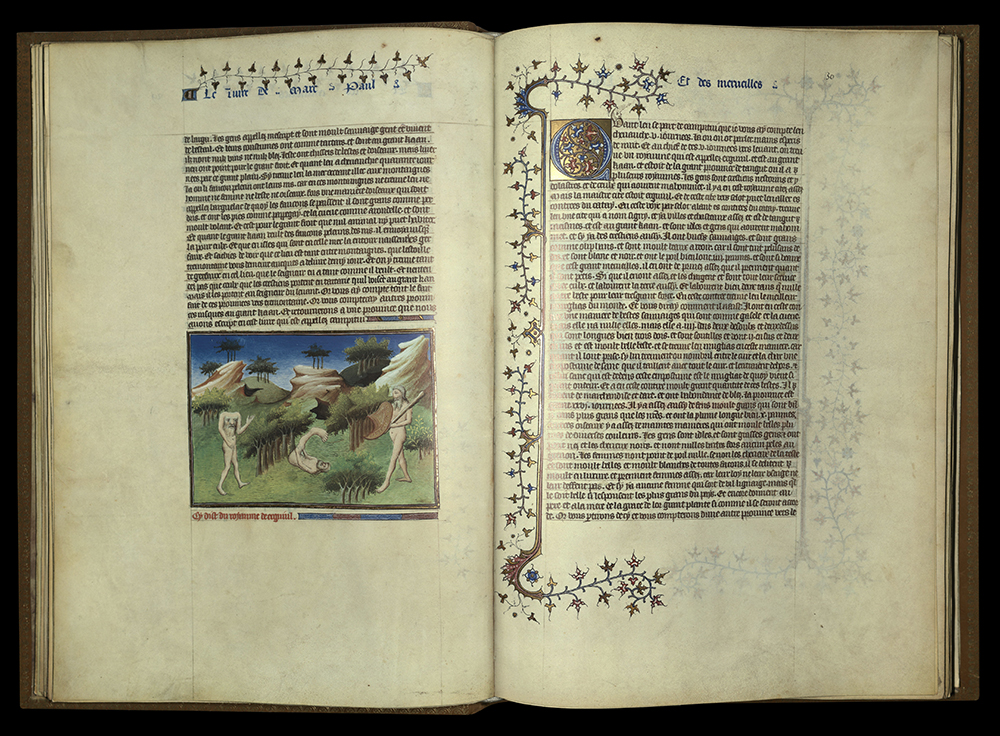
THE BOOK OF WONDERS (LE LIVRE DES MERVEILLES)
Marco Polo, fifteenth century
Paris, Bibliothèque Nationale de France, Ms. Fr. 2810
Lucerne: Faksimile-Verlog, c. 1995
Edition of 1060 copies. Rare Books copy is no. 367
G370 P914 1995
The Book of Wonders by Marco Polo (c. 1254-1324) was presented in 1413 by John the Fearless, Duke of Burgundy, to his uncle, John, the Duke of Berry. It is justifiably one of the most famous illuminated manuscripts of the Middle Ages.
Marco Polo’s accounts of his travels constitute the first comprehensive work to document the countries and peoples of the legendary Orient. In the year 1271, Polo began his journey of three and a half years across Eastern Asia, from Palenstine to Persia, through Pakistan, and finally on to Northern China, eventually reaching the court of Kublai Khan. On this return to Europe in 1292, Polo traveled along the coasts of the Indian Ocean, through Baghdad and on to Venice. In 1298, Polo, who by that time was the commander of a galley, was taken prisoner during one of the numerous wars between Genoa and Venice. While in prison in Genoa, he shared a room with a certain Rustichello of Pisa, who recorded Polo’s tales in French, and it is in that form that they are presented here.
Although secular subjects generally required creativity and imagination of the artist, the illustrators of this manuscript had a special challenge trying to depict accurately animals, peoples, and costumes which they had never seen themselves.
In many cases, as in the spread shown above, they had no choice but to invent. Several artists worked on illustrating the book. The famous Boucicaut Master, one of the early artists to explore naturalism, was responsible for a portion of the book’s decoration. Of the eighty-four miniatures, thirty-seven are attributed to him, together with the Mazarine Master. It is not known who painted the remaining miniatures and borders.
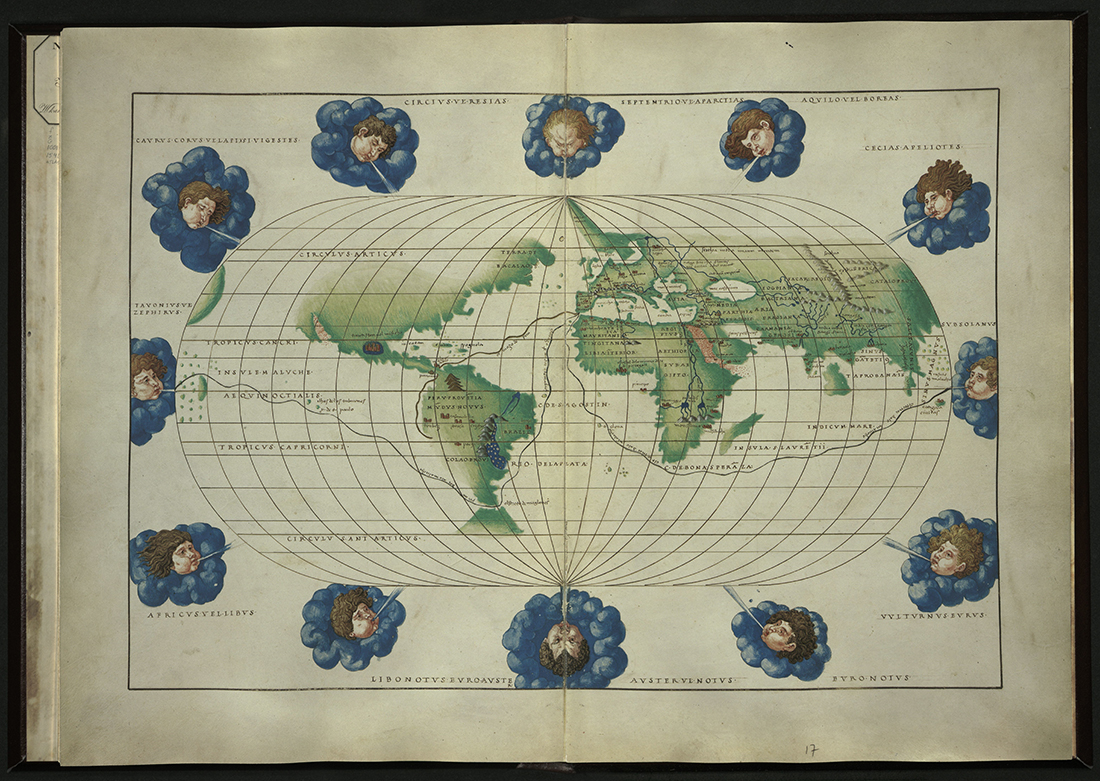
PORTOLAN ATLAS (ATLANTE PORTOLANO)
Battista Agnese, 1546
St. Petersburg, Russian National Library
Graz: Akademische Druck-u. Verlagsanstalt, 1993
Edition of 700 copies. Rare Books copy is no. 45
G1001 A45 1546z
Battista Agnese (active c. 1535-1564) came from Genoa, but worked in Venice, producing maps so high in quality that they were valued more for their artistry than for the information they contained. Agnese, rather than producing original maps of his own, was more of a copyist who produced accurate up-to-date maps of the whole known world. Aganese’s maps were drawn in the style of the traditional portolano atlases, providing sailing directions. They show complete coastlines and waterways, and bear the characteristic lines of direction from the thirty-two points of the compass. Most of Agnese’s maps, of which there are seventy-one in all, were not used for navigation but were collected by an international clientele that included merchant princes and officials of high rank. They were typically produced by more than one assistant, as was this one, to speed the process.
Agnese liked to keep abreast of the latest information, and he was the first to include the northwest coastline of America after its discovery by Francisco de Ulloa in 1539 and 1540.
Agnese’s maps all tend to use a uniform color scheme: blue for coastlines, red or black for place names, green and gold for islands, and red for the Red Sea and also the California peninsula, which he included in his maps from 1542 on. Each atlas contains an oval projection of the world, tracing Magellan’s route around the globe, as shown above.
In addition, this volume also contains twelve other detailed maps, one table of the sun’s declinations, an armillary sphere, a compass, and three large miniatures that depict Jason and the Argonauts, an episode from the Aeneid of Virgil, and an allegory showing Atlas and a beautiful globe painted in blue and gold.
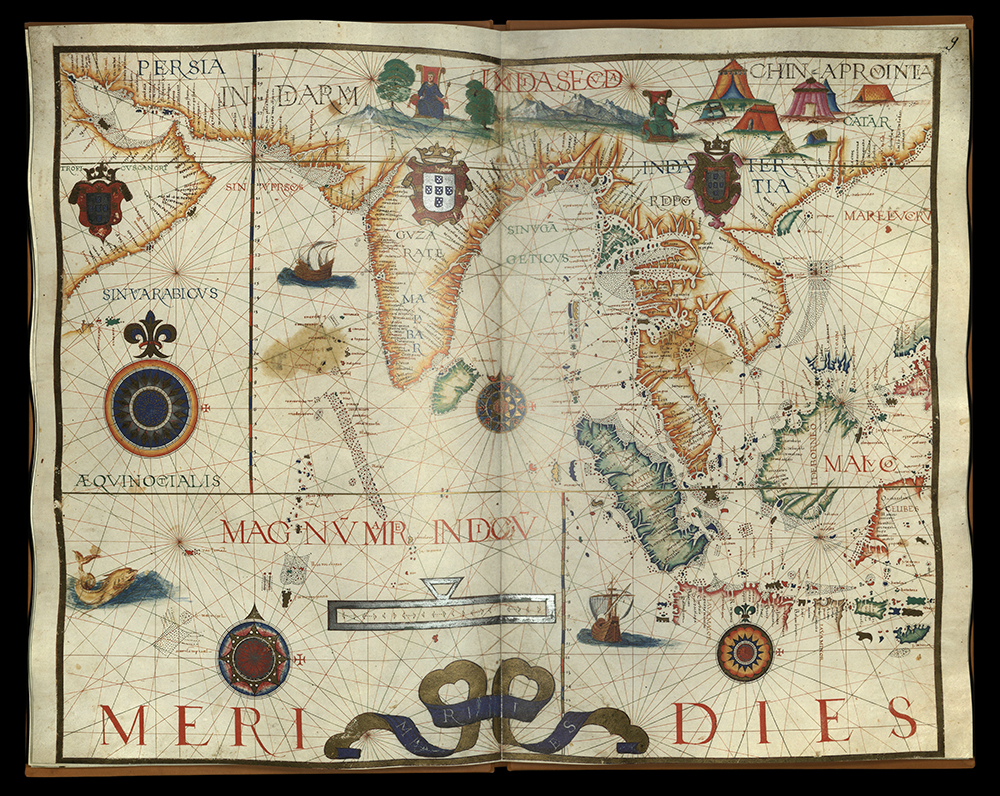
WORLD ATLAS (ATLAS UNIVERSAL)
Diogo Homem, 1565
St. Petersburg, Russian National Library
Barcelona: M. Moleiro Editor, 2000
Edition of 987 copies. Rare Books copy is no. 686
G1059 H6 2000
Diogo Homem was one of the most famous of the sixteenth-century Portuguese mapmakers. To produce this atlas, Homem catered to the needs of his day, by drawing on the most up-to-date information known. One of the most interesting aspects of the atlas is the inclusion of territorial boundaries, together with miniatures illustrating a variety of things common to each place depicted. The latter include heraldic symbols, flags, animals and indigenous peoples. These elements make the map particularly valuable as a historical document today.
The image above is a map delineating China and Persia. It illustrates how much knowledge about the world had been gained since 1565, over the little that was known in the days when Marco Polo’s Book of Wonders was written.
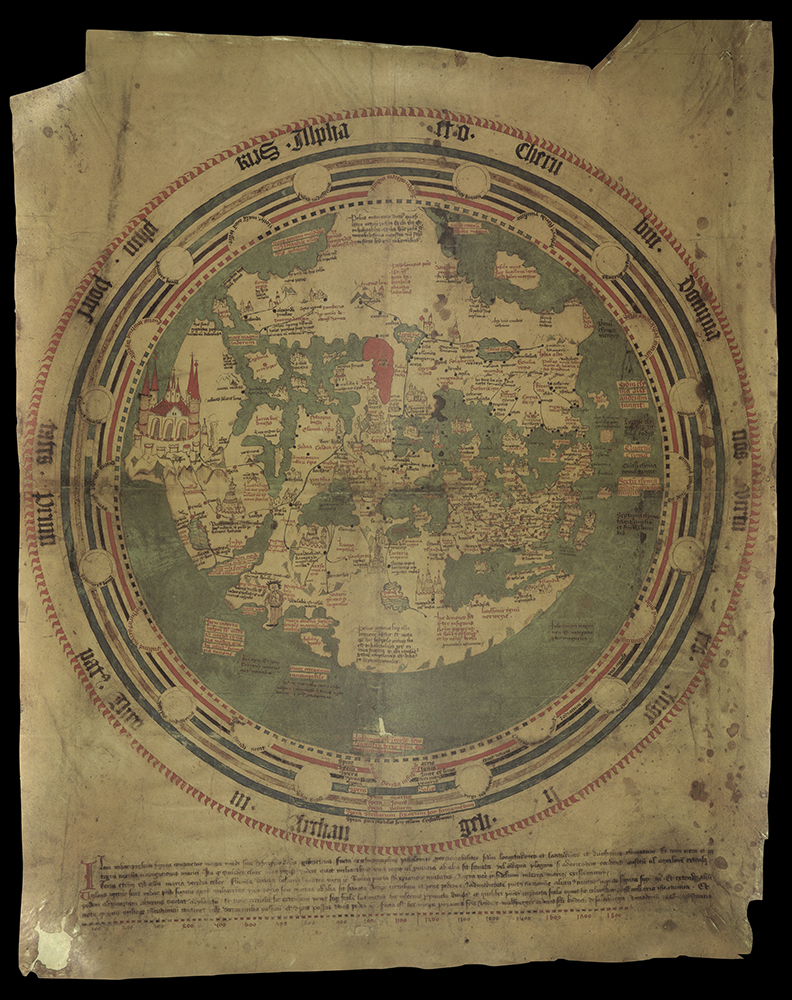
WORLD MAP (WELTKARTE DES ANDREAS WALSPERGER)
Andreas Walsperger, 1448
Stuttgart, Bibliothek, Pal. Lat. 1362 B.
Stuttgart: Belser Verlag, c. 1981
G3200 1448 W3 1981
This map of the world is the work of the Austrian, Andreas Walsperger. As a Benedictine monk, Walsperger created a map of the western hemisphere that reflects the medieval understanding of the world in symbolic terms. Jerusalem appears at the center and everything else radiates out from it. The earth is shown circumscribed by the ocean, with a series of concentric circles symbolizing the hierarchy of heavenly angels. Between the circles are inscribed the names of the various winds together with the twelve signs of the zodiac. Inscriptions at the top and bottom of the map declare the two poles, both north and south, to be uninhabitable. Africa contains Amazons, Pygmies, and one-footed creatures. This traditional medieval map is one of the last of its type of monastic cartography. A demand for more precise maps would arise as the result of the various voyages of discovery, the most important of which would be Columbus’ discovery of America only forty-four years later.
MODEL BOOKS
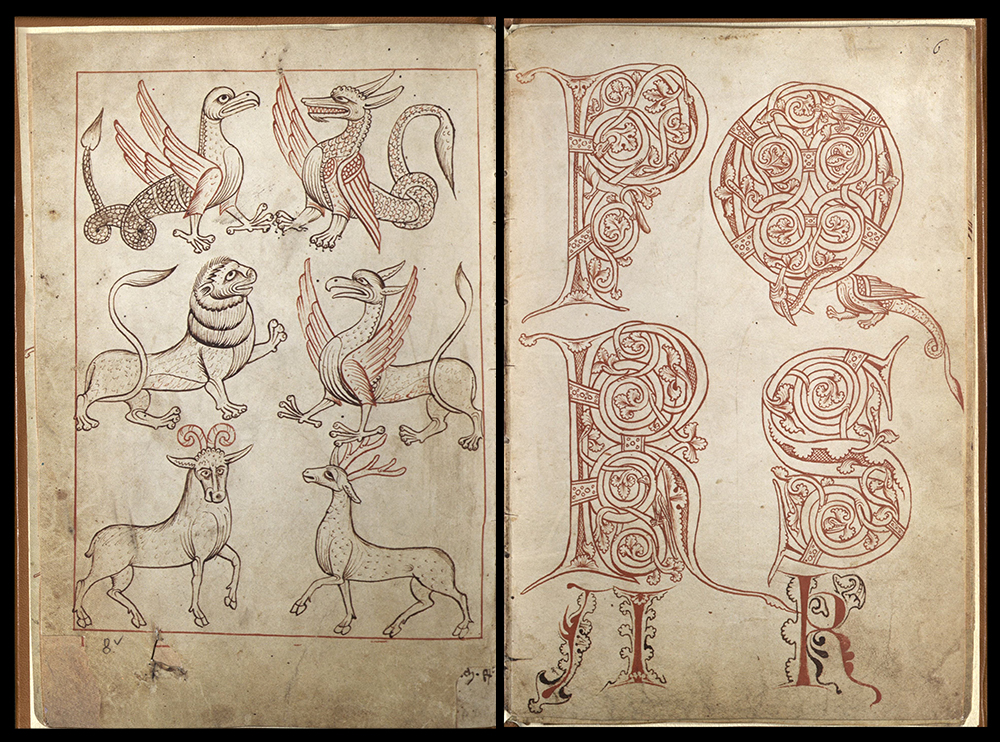
MODEL BOOK OF REIN (REINER MUSTERBUCH)
Thirteenth century
Vienna, Österreichische NationalBibliotech, Cod. Vindob. 507
Graz: Akademische Druck-u. Verlagsanstalrt, 1979
NC75 R34 R43 1979
Model books are collections of patterns created by artists to use in their workshops. They are made up of a series of motifs, letters and drawings that could be copied for a variety of artistic productions including paintings, illuminated manuscripts, stained glass, and embroideries. These collections of drawings were typically formed over a period of time, and were sometimes handed down to other artists. Because they were never intended for public consumption, many of these books have been lost or exist only in a very fragmentary state.
The Model Book of Rein was produced at Rein Abbey, a Cistercian house in Austria. It is one of the earlier of the western model books to survive. The Rein Abbey model book must have been a more extensive collection originally but is now reduced to just thirteen leaves of pen drawings, depicting both ornamental initials and animals. Since this book is a Cistercian production, it has been suggested that it was created to meet the demand for uniformity that was characteristic of Cistercian art.
The spread above on the left shows the end of an alphabet written out on this and the preceding pages in uncials. These ornate letters could have been copied and adapted for manuscripts. Opposite are a series of animals clearly drown in outline form, making them easy to copy and utilize as a repertory of images.
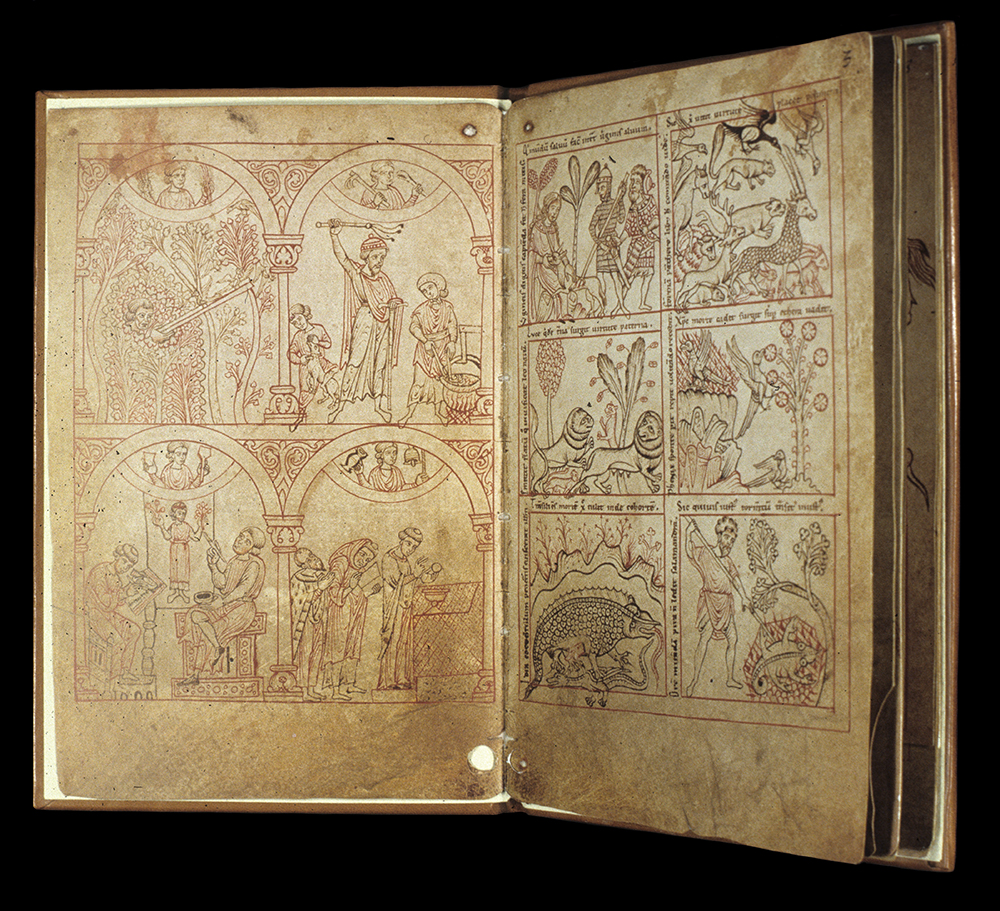
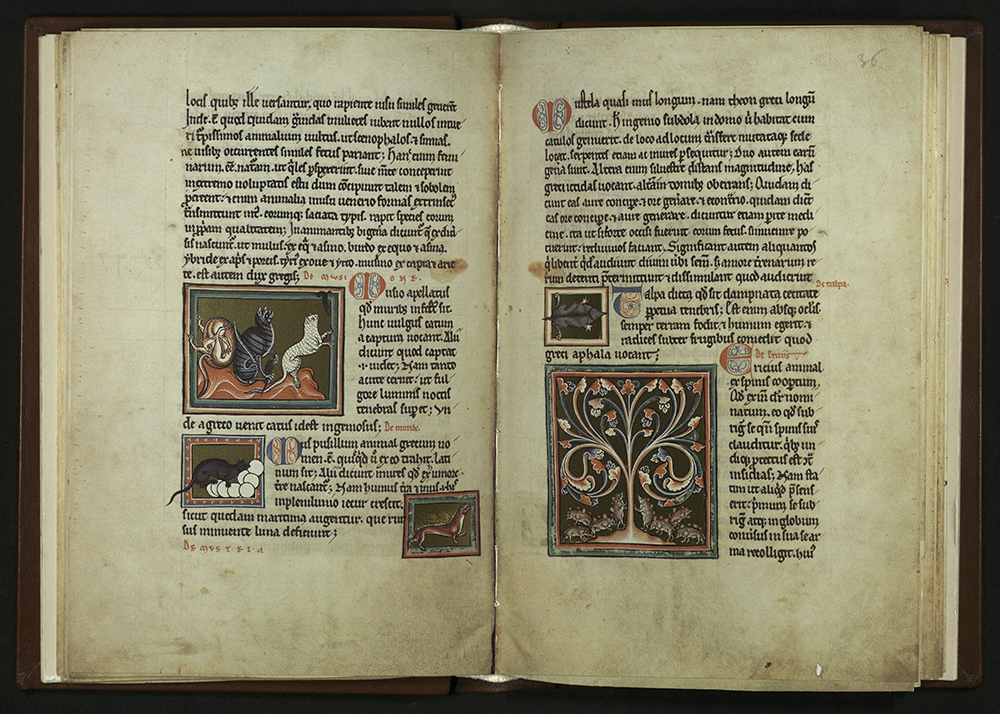
A MEDIEVAL BESTIARY (BESTIARIUM)
Thirteenth century
Oxford, Bodleian Library, University of Oxford, Ms. Ashmole 1511
Graz: Akademische Druck-u. Verlagsanstalt, 1986
PA8275 B4 G4 1986
Medieval bestiaries, or illustrated books of beasts, were a form of literature containing descriptions of animals, both real and imaginary, for which Christian moral and allegorical interpretations were given. Bestiaries were very popular during the Middle Ages, especially in the twelfth century.
This particular manuscript, with its liberal use of gold and luminous opaque colors, is considered to be one of the finest examples of its kind. It contains one hundred and thirty miniatures, placed irregularly throughout the text, that depict all kinds of birds, snakes, worms, fish, and trees, as well as strange creatures such as a crocodile with a serpent’s head and bird’s feet. With its refined ornament and clear depiction of plants and animals, it is obvious why artists would sometimes rely on bestiaries like this one to provide models of plants and animals for creating their various productions.
One of the most extraordinary miniatures of the book is that illustrating the three cats, found on the middle of the left-hand page. In this image the artist has successfully captured both the movements and habits of real cats. The cat on the left is shown giving himself a bath, while the other two try to catch a pair of lively little mice. This can be contrasted with the mole, (or, “talpa” as he is called in the book), flattened lifelessly onto his little illuminated square. Here, the artist probably only had an opportunity to observe a dead mole, which would account for the difference between this image and that of the vivacious three cats opposite.
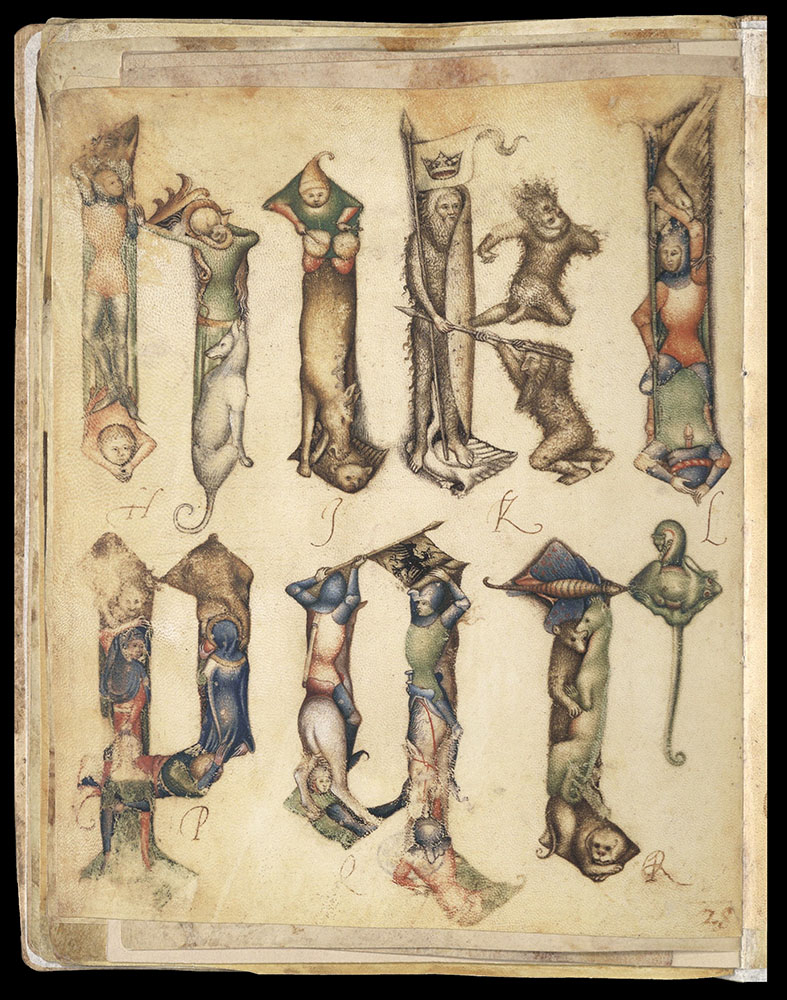
THE SKETCHBOOK OF GIOVANNINO DE GRASSI (TACCUINO DI DISEGNI DA GIOVANNINO DE GRASSI)
Fourteenth century
Bergamo, Biblioteca Civica “Angelo Mai”, ms. VII. 14
Lucerne: Faksimile Verlag, c. 1998
NC257 G7315 1998
This sketchbook consists of a collection of parchment leaves bound together with drawings and paintings of animals, birds, heraldic designs, letters, and human figures. The drawings vary in quality. The best are attributed to Giovannino de Grassi, a Lombard artist who worked for the Visconti Court of Milan at the end of the fourteenth century. De Grassi, who was active as an architect, sculptor, painter and manuscript illuminator, would have used this sketchbook as patterns of motifs for his various workshop productions, as well as for exemplars to show clients, or potential clients. A number of the plant and animal drawings appear to have been executed as studies from life, some of them probably drawn directly after animals in the Milanese court menagerie.
The animal drawings, some of them colored using the technique of manuscript illumination and watercolor, are extraordinary for their time in the way they capture the true nature and likeness of the animals they depict, as in the case of the spread above.
These drawings are of great importance to the history of the emerging naturalism of the Renaissance and can be considered forerunners to Albrecht Dürer’s famous colored animal studies executed during the High Renaissance. The advances made in attaining a more realistic portrayal of the animals in this book over those in the Model Book of Rein and the Medieval Bestiary should be immediately apparent. The left page in the image above shows the end of a very imaginative alphabet drawn out using human and animal forms to create the letters. Compare the letter “X” of this book with that of the Roman Alphabet below, and with that of the Model Book of Rein.
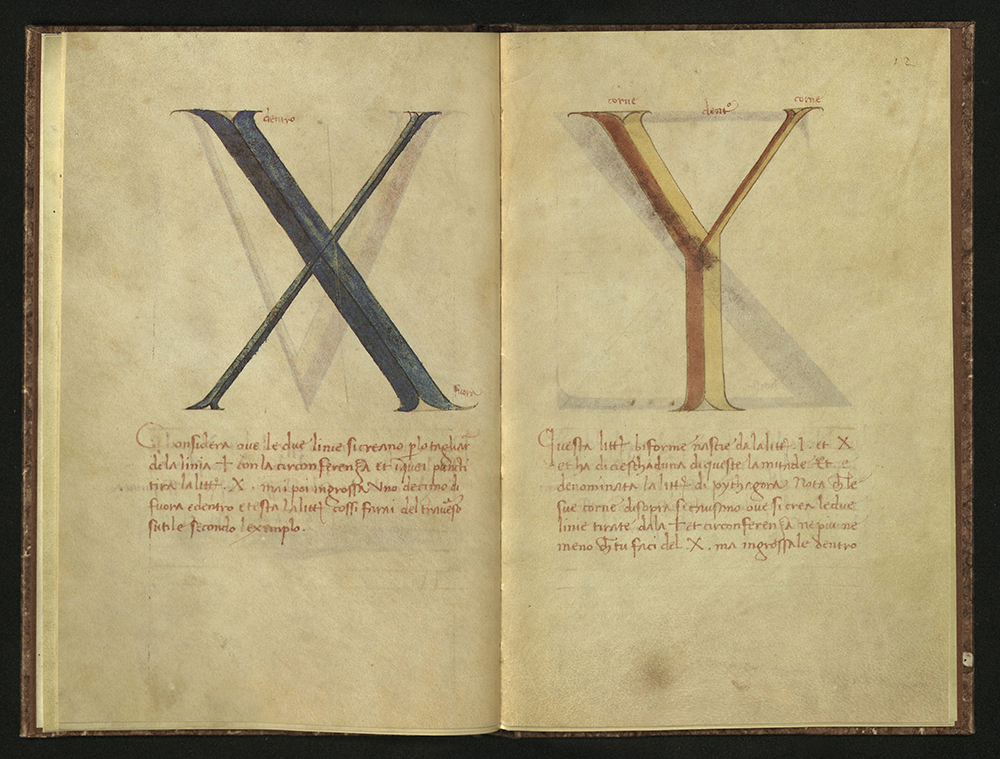
ROMAN ALPHABET (ALPHABETUM ROMANUM)
Felice Feliciano, 1460
Vatican City, Biblioteca Apostolica Vaticano, Vat. lat. 6852
Zurich: Belser Verlag, c. 1985
Z240 F428 1985
Felice Feliciano (1433-1479) was an important Veronese calligrapher. One of his interests was epigraphy, and he consequently studied intensively ancient Roman letter forms from surviving inscriptions. Based on his studies, Feliciano came to the conclusion that the letters produced during the Augustan era were superior to those of the period following it, when “The geometrical foundation and the serifs disappeared, the aesthetic canon was forgotten, and block-letters became, apart from few exceptions, the expression of an age deprived of spiritual and civic leadership.”
Feliciano’s colored letter forms, reproduced here, are noteworthy for being the first to revive the precise geometrical proportions that Feliciano had observed in ancient Roman lettering (that is, before the period of decline as he defined it in the quotation above). Feliciano writes, “It is only the habit of the antique [people] to carve letters [based on] the circle and the square… And this is what I, Felice Feliciano, through careful measuring, have found in the antique letters.”
To fully appreciate Feliciano’s achievement, it is worth comparing his clean, refined letters to the ornamental letters found in the Model Book of Rein, and to the imaginative letters drawn in the Sketchbook of Giovannino de Grassi. The book that Feliciano produced would have been useful to calligraphers like himself, as well as to writers, book painters and artists.
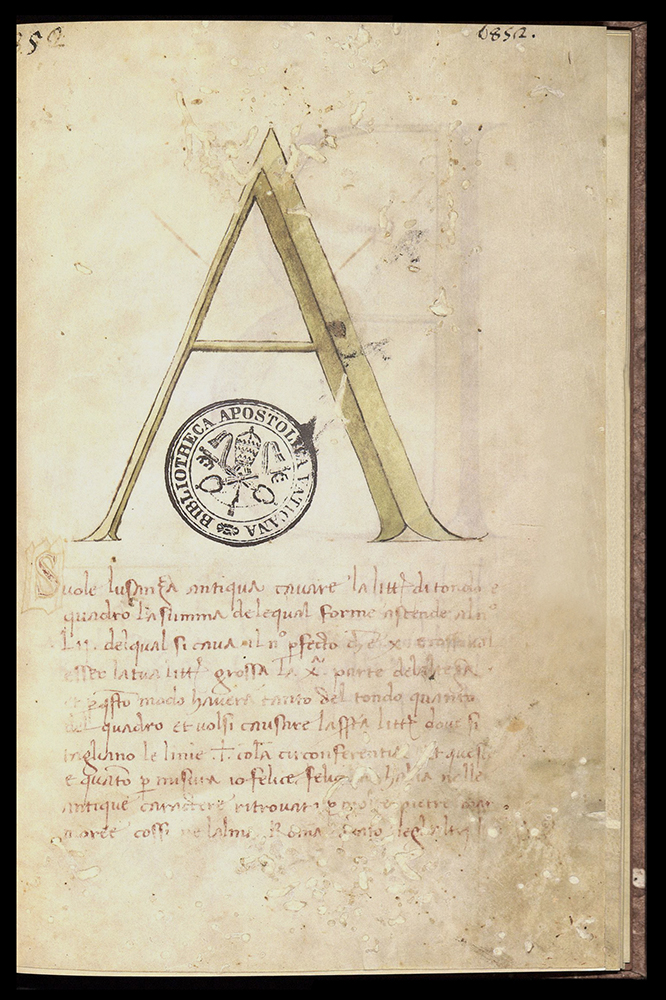
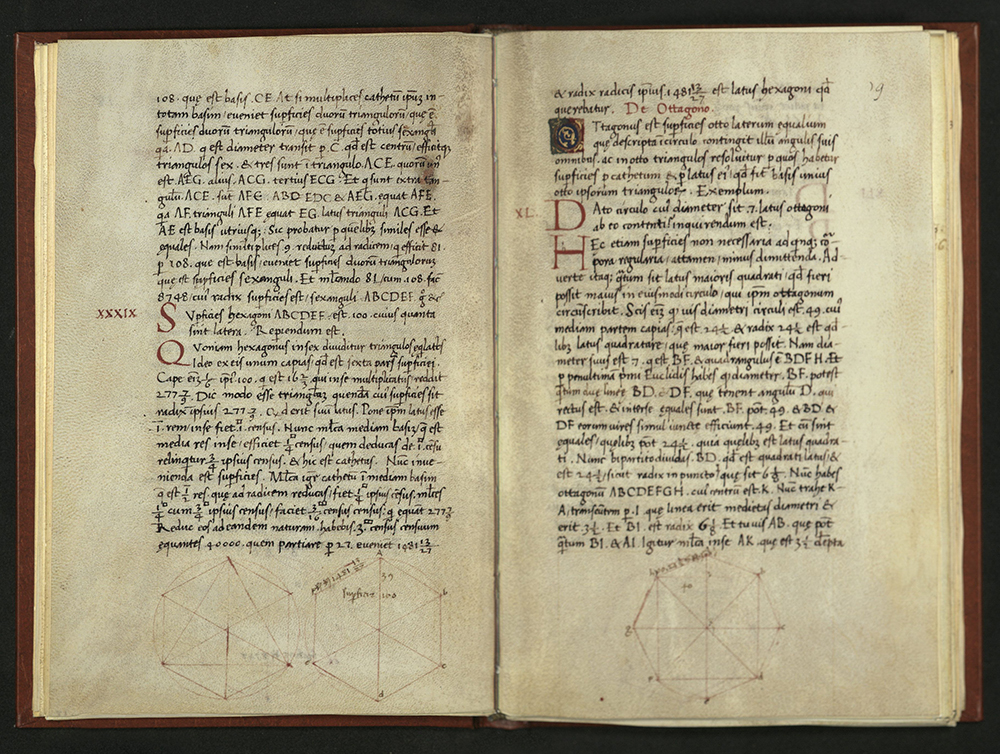
ON THE FIVE REGULAR BODIES (LIBELLUS DE QUINQUE CORPORIS REGULARIBUS)
Piero della Francesca, 1480’s?
Vatican City, Biblioteca Apostolica Vaticano, Vat. urb. Lat. 632
Florence: Giunti, 1995
Edition of 998 copies. Rare Books copy is no. 867.
QA444 P547 1995
Piero della Francesca (c. 1420-1492) is one of the most important painters of the early Italian Renaissance. Few artists of his day understood space, light, color, and form as well as he did. As part of Piero’s intense engagement with the formal concerns of the Renaissance, he wrote a series of treatises on perspective, arithmetic and geometry. All of them remained unpublished in his lifetime.
His treatise on geometry, entitled Libellus de quinque corporibus regularibus, was most likely written after the other treatises sometime during the 1480’s. It is preserv3ed in a single manuscript, reproduced here in facsimile. The Libellus treats the five regular bodies of Platonic geometry, all of which are polyhedral. The treatise addresses arithmetical calculations and methods for solving problems associated with these forms when inscribed in a sphere. To accompany his text, Piero included a series of diagrams to illustrate the concepts discussed. These, together with the schematic figures delineated in his other two treatises, his Trattato d’Abaco and De prospective pingendi, are all that survives of Piero’s work as a draftsman. The Libellus is dedicated to Guid’Ubaldo da Montefeltro of Urbino (b. 1472), which helps date the work to a time that must presumably have been after Guid’Ubaldo’s accession to power as the Duke of Urbino in 1482.
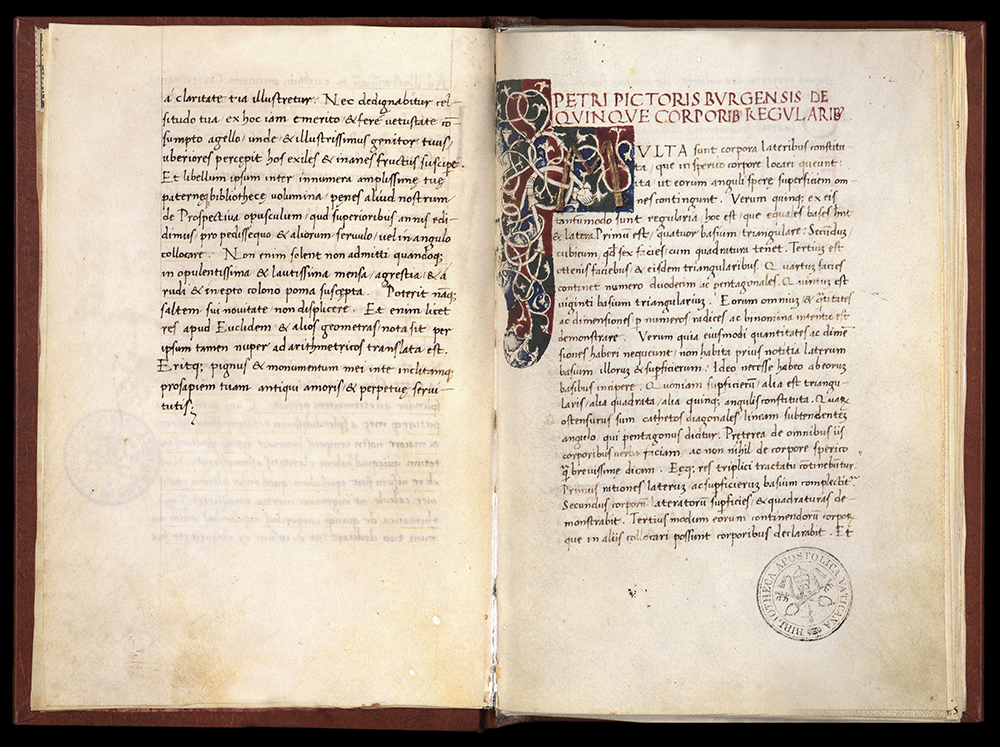
MEDIEVAL LITERATURE
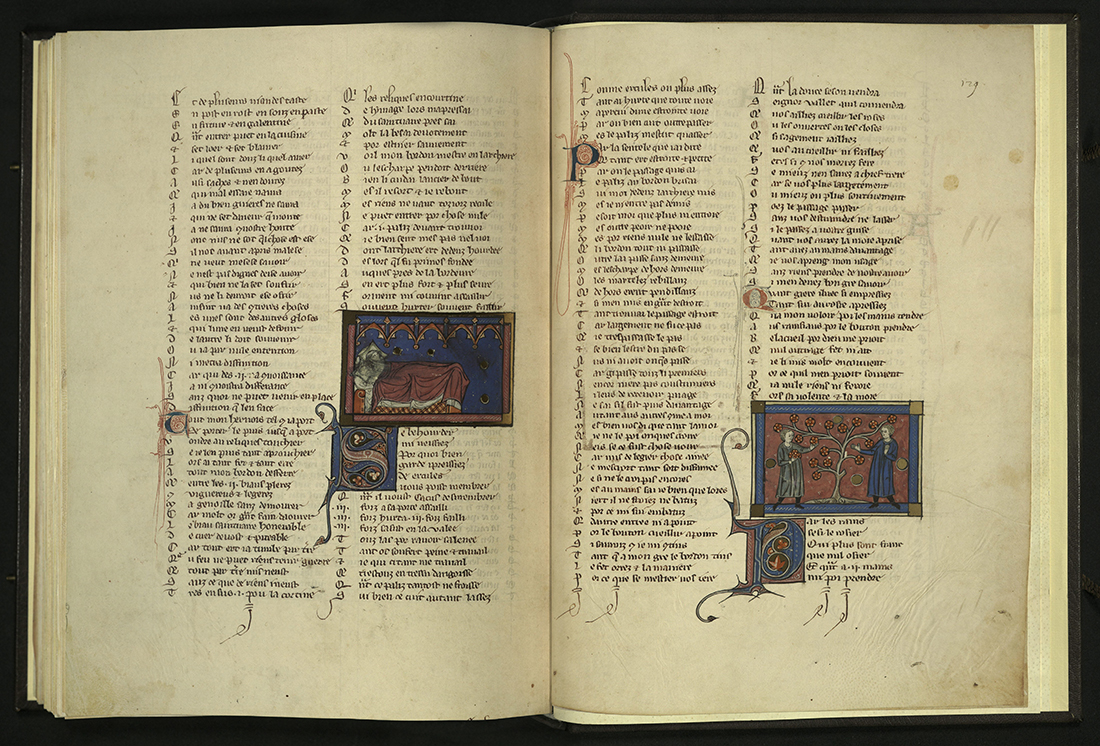
THE ROMANCE OF THE ROSE (LA ROMAN DE LA ROSE)
Guillaume de Lorris and Jean de Meun, executed by the scribe Berthaud d’Achy, c. 1275
Vatican City, Biblioteca Apostolica Vaticano, Urb. Lat. 376
Zurich: Belser-Verlag, c. 1987
PQ1527 A1 1300a
The Roman de la Rose was begun by Guillaume de Lorris and completed forty years later by Jean de Meun. It is an allegorical poem based on the literary conceit of the dream vision. It tells of a young lover’s dream that took place one night in May, at the tender age of twenty. The poem is narrated by the lover himself, who explains in great detail his elaborate dream about his quest to obtain a rose found in the Enchanted Garden. Notwithstanding obstacles set by Jealousy and Resistance, he eventually finds the rose, plucks it and awakes.
The Roman de la Rose provided rich material for illustration. With its vivid descriptions, the poem almost demands to be illustrated. The spread above from the elegant French manuscript reproduced here, shows the lover at the end of the poem plucking his rose from a lush rose bush. The lyrical little scene captures nicely the lover’s feelings of longing, mixed with the thrill of attainment, which is expressed in the final lines of the poem: “Before I stirred from that place where I should wish to remain forever, I plucked, with great delight, the flower from the leaves of the rosebush, and thus I have my red rose.”
The book is illuminated with miniatures of the same type and quality throughout, all of them are executed primarily in red, blue, gold and gray, giving the book a feeling of uniformity and luxury.
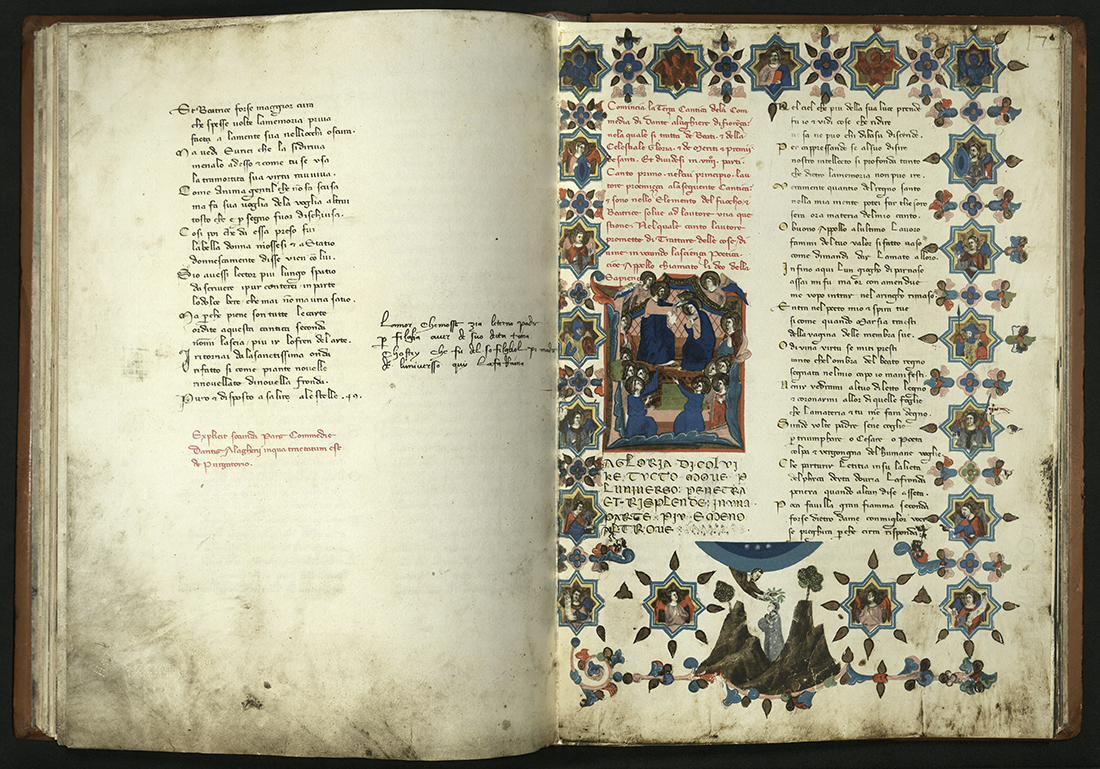
THE DIVINE COMEDY (LA DIVINA COMMEDIA)
Dante Alighieri, 1337
Milan, Biblioteca Trivulziana del Castello Sforzesco, Codex Trivulziano 10180
Milan: U. Hoepli, 1921
Edition of three hundred and fifty copies. Rare Books copy is no. 60.
PQ4301 A1 1921
Presented to the University of Utah by the Italians of the United States of America, in commemoration of the 600th anniversary of the death of Dante.
Dante, the greatest of all Italian poets, was born in Florence in 1265. Throughout his life he was active in politics. His support for the Guelph faction led to his exile from his native city in 1309. The Divine Comedy was composed during the later years of the poet’s life while he was in exile. It is the greatest of his many writings. In it, the poet describes his visionary journey through Hell and Purgatory to Paradise.
Extensive illustrated cycles of Dante’s poems were created already within a short time of author’s death in 1321.
The manuscript presented here in facsimile form was written, signed and dated by the scribe Francesco di Ser Nardo da Barberino in 1337. It is illustrated with one miniature painted at the opening of each of the three parts of the poem. The miniatures are remarkable for the beauty of their colors and their ability to communicate, through elegant form and gesture, something of the nature of Dante’s poetry. The miniature shown here belongs to the opening of the “Paradiso.” The painter used a great deal of blue, an expensive pigment that was made from crushed lapis lazuli, to enhance the scene and make it appear more heavenly and precious. Near the top of the page on the left, the Virgin is shown being crowned Queen of Heaven, just as at the bottom of the page, the poet is shown being crowned with a laurel wreath.
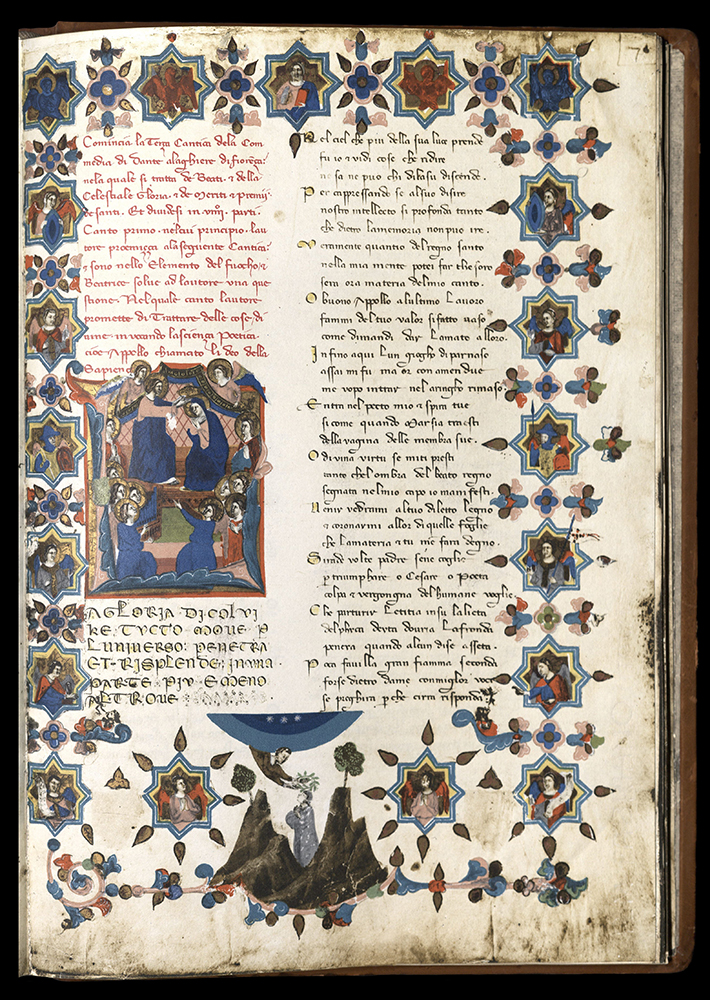
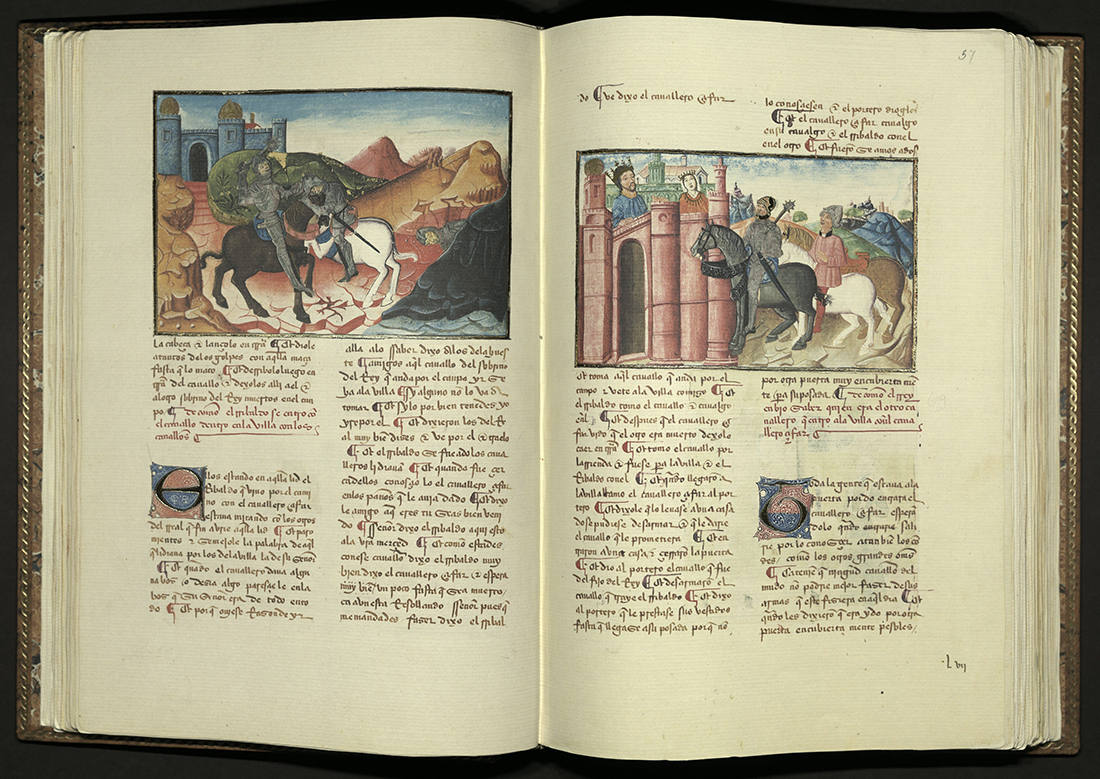
THE BOOK OF THE KNIGHT ZIFAR (LEYENDA DE CAVALLERO CIFAR)
Ferrand Martines, fourteenth century
Paris, Bibliothèque Nationale de France, Ms. Español 36
Barcelona: M. Moleiro Editor, c.1996
Edition of 987 copies. Rare Books copy is no. 723
PQ6388 C2 1996
This book is devoted to the behavior and conduct of the knight-errant. It was written by Ferrand Martines, the Archdeacon of Madrid and Canon of Toledo around 1304. With this book, Martines, who also served as notary to Kings Alfonso X and Sancho IV, ushered in the first personal literary style of Castilian prose writing. His text is now considered a predecessor to Cervantes' Don Quixote.
The original manuscript reproduced here contains two hundred and forty-two miniatures, illustrating with the bold colors of the Spanish style of illumination, aspects of fourteenth-century military and civilian life. This luxury manuscript was produced for King Enrique IV of Castile, most likely in Segovia where the King had a hunting lodge. It was painted by a group of five illuminators, working in the style of and probably including the famous Castilian illuminator, Juan de Carrion.
On the spread above are episodes from the adventures of the knight Zifar (or Cifar as he is described in the text.) The miniatures are painted in a quaint and inviting way that echoes the engaging vernacular style of Martines writing.
The facsimile is noteworthy for the paper on which it is printed. The paper was specifically hand made to reproduce not only the thickness and weight, but also the feel and scent of the original manuscript.
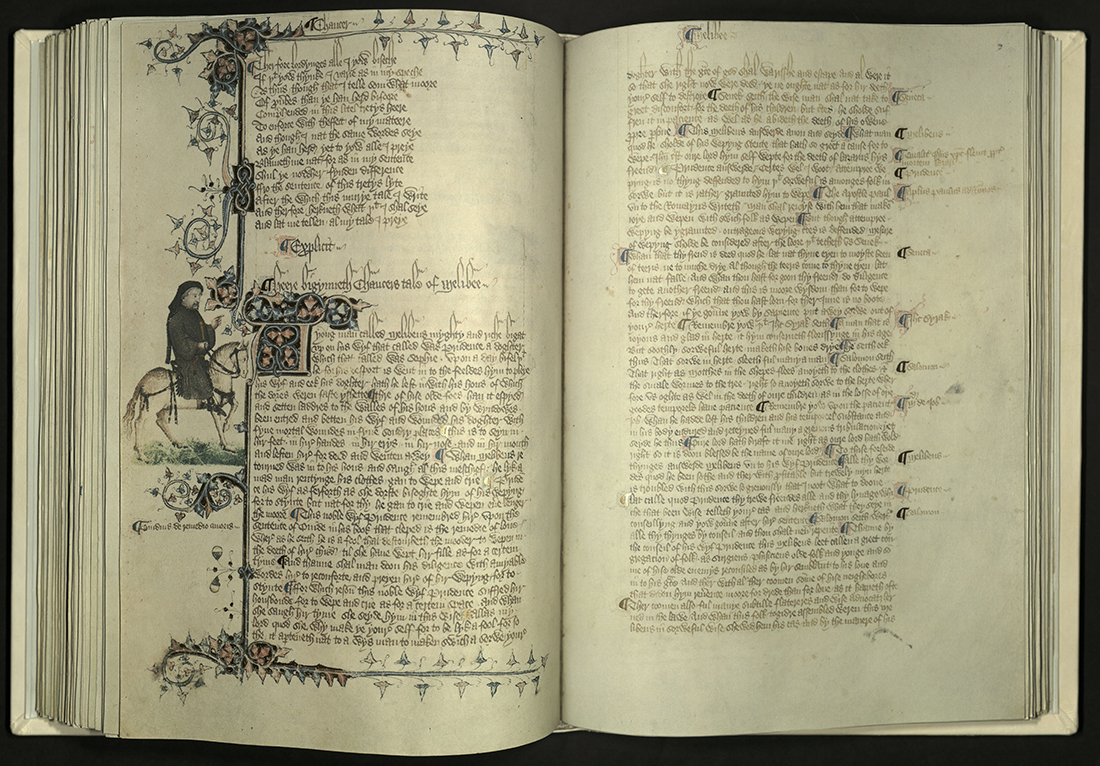
THE ELLESMERE CHAUCER (THE CANTERBURY TALES)
Geoffrey Chaucer, 1410?
San Marino, California, The Huntington Library, MS EL 26 C9
San Marino, California: The Huntington Library; Tokyo: Yushido, 1994
Edition of 250 copies
PR1866 W66 1995
Gift of William J. Gould in memory of Erlyn J. Gould
The facsimile of this manuscript is an extraordinary achievement in book reproduction. Few reproductions give a sense of the original manuscript as vividly or as lovingly as this one does, from its soft tawed calf-leather binding, sewn and bound over heavy oak boards, to its precise duplication of the look and feel of the pages.
The original manuscript, which this book replicates, was produced for an unknown patron of means in London, and is justifiably famous, as it is the most complete version of Geoffrey Chaucer’s Canterbury Tales to survive. It is thought that it was copied from a manuscript close to Chaucer’s original. The Canterbury Tales, Chaucer’s most celebrated work, is comprised of a collection of stories, told by a group of pilgrims to pass the time while travelling on horseback from London to the shrine of the martyred St. Thomas à Becket in Canterbury. These appealing stories, told by the motley assortment of pilgrims, quickly achieved a wide popularity, and as the Ellesmere manuscript demonstrates, they were also well suited to illustration.
Twenty-three portraits of the story-tellers are depicted in the manuscript. Among these is one of Chaucer, who had included himself as a pilgrim in the narrative. The buoyant illustrations of the pilgrims correspond closely to Chaucer’s text – written in Gothica bastarda – while they also add a certain charm of their own to the whole. The portrait of Chaucer, depicted above, is the earliest likeness of the poet that we have. Chaucer died without completing the Canterbury Tales, and so the Cook’s and the Squire’s tales are left with blank spaces where the remaining text would have gone had it ever been written.
HUMANIST LITERATURE
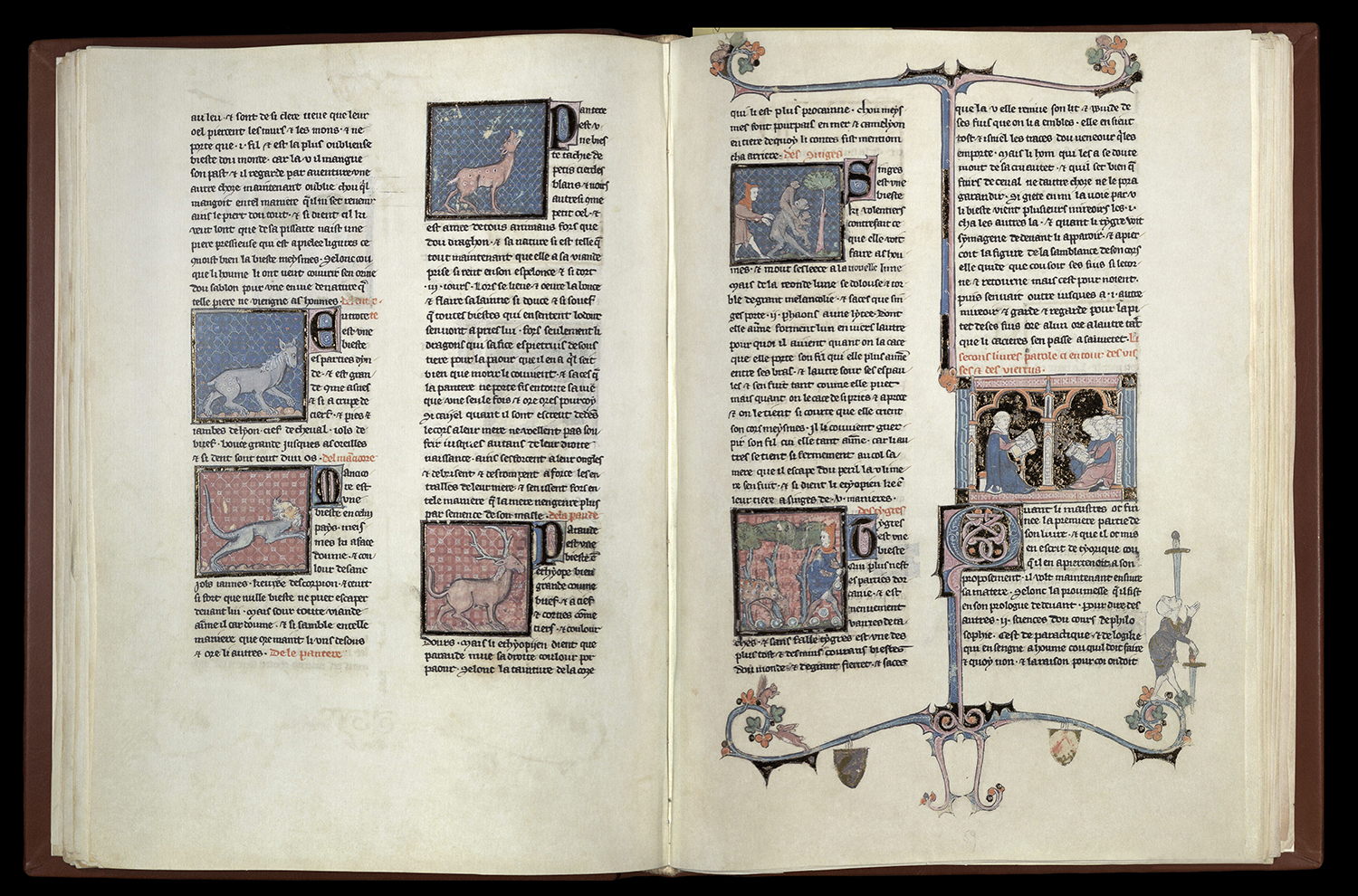
BOOK OF TREASURES (LI LIVRE DOU TRESOR)
Brunetto Latini, fourteenth century
St. Petersburg, National Library of Russia
Barcelona: M. Moleiro Editor, c. 2000
Edition of 987 copies
PQ1429 L24 L5 2000
Brunetto Latini (b. c. 1225- d. c. 1295), a notary by profession, is best known as a great Florentine philosopher and statesman. He was the teacher of the young poet Dante, who included Latini in his Divine Comedy as the one who taught him “how man makes himself eternal” (“inferno,” canto XV). Latini was a member of the Guelph party. Because of that, he was exiled from Florence after the Guelph defeat at Montaperti until 1266, when the Guelphs triumphed anew. Latini became the first permanent chancellor of the new Florentine republic that was subsequently established. Latini was noted in his day as a man of distinction and great eloquence. The Florentine historian, Giovanni Villani (c. 1275-1348), called him “a great philosopher, [and] the greatest rhetorician in the art of speaking as well as of teaching.”
Latini wrote his Book of Treasures in French prose during his period of exile, which he spent in France between 1260 and 1267. The book purports to be a kind of encyclopedia which “treats of all things that pertain to mortals.” It consists of three books that are primarily compilations of various writers, including Isidore of Seville, together with compendiums of Aristotle’s “Ethics” and Cicero’s treatise on rhetoric. The first book treats the subject of history: natural history, Biblical history, and the history of Troy and the Middle Ages. The second book deals with ethics. And the third book discusses the political life of Latini’s own times.
The St. Petersburg manuscript, presented here in facsimile form, is illuminated in the French style of the fourteenth century. It was probably produced in a professional lay artist’s workshop in Paris. The book is richly decorated throughout with no less than one hundred and fifteen illuminations of animals and human figures, and a series of ornaments, that help direct the reader to the various sections of the text.
The page above shows the end of the portion of the book devoted to natural history – with its many illustrations of animals both real and fantastic – and the beginning of the section on the virtues and vices. The paper of this beautiful facsimile was handmade to reproduce the thickness, feel and scent of the original, to enhance the viewer’s sense of the work.
ASTROLOGICAL TEXTS
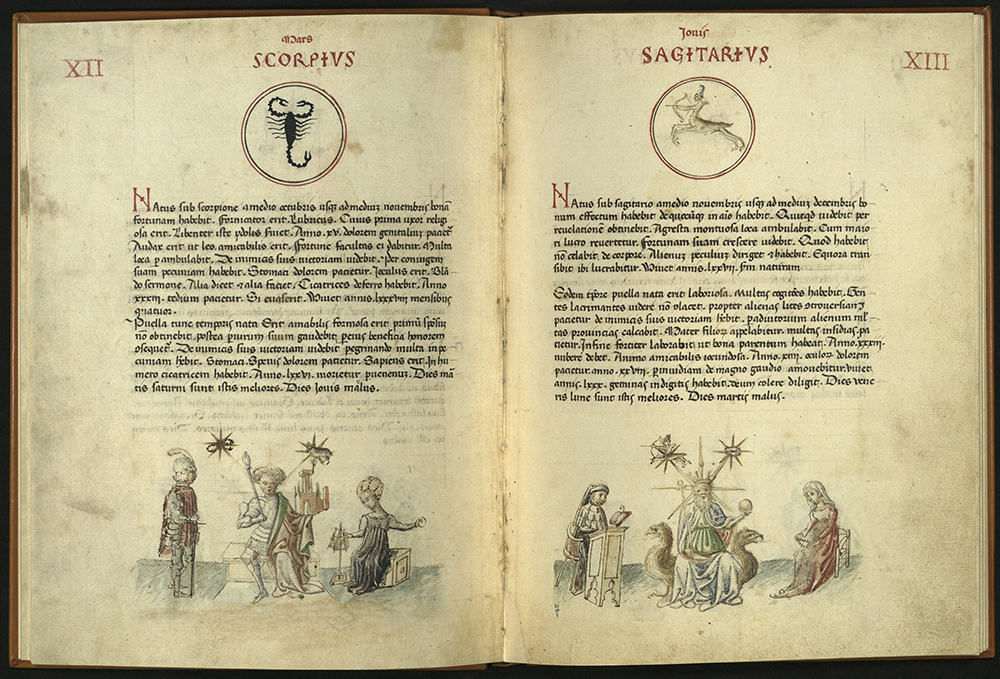
MISCELLANY OF MEDIEVAL ASTROLOGICAL TREATISES (LIBER PHYSIOGNOMIAE)
1440-1450
Modena, Biblioteca Estense universitaria, Lat. 697=a.W.8.20
Modena: Il Bulino, 2000
Edition of 999 copies. Rare Books copy is no. 583
BF1410 L53 2000
This manuscript is a miscellany of medieval astrological treatises, compiled by an unknown author. It begins with the characteristics of individuals born under the twelve zodiacal signs. A treatise on astrology and astronomy follows. Two astrolabes, complete with functioning dials and pointers, are also included to help map out horoscopes. The delicate painted decoration is executed in watercolor and illustrates each of the different signs of the zodiac with a personification of the associated planet below, flanked by the “children” of the sign, one male and one female. The artist who painted these was clearly influenced by the great North Italian artist Pisanello, and was therefore most likely active in one of the cultural centers of the Po Valley, like Ferrara, Verona, and Mantua, and possibly Padua.
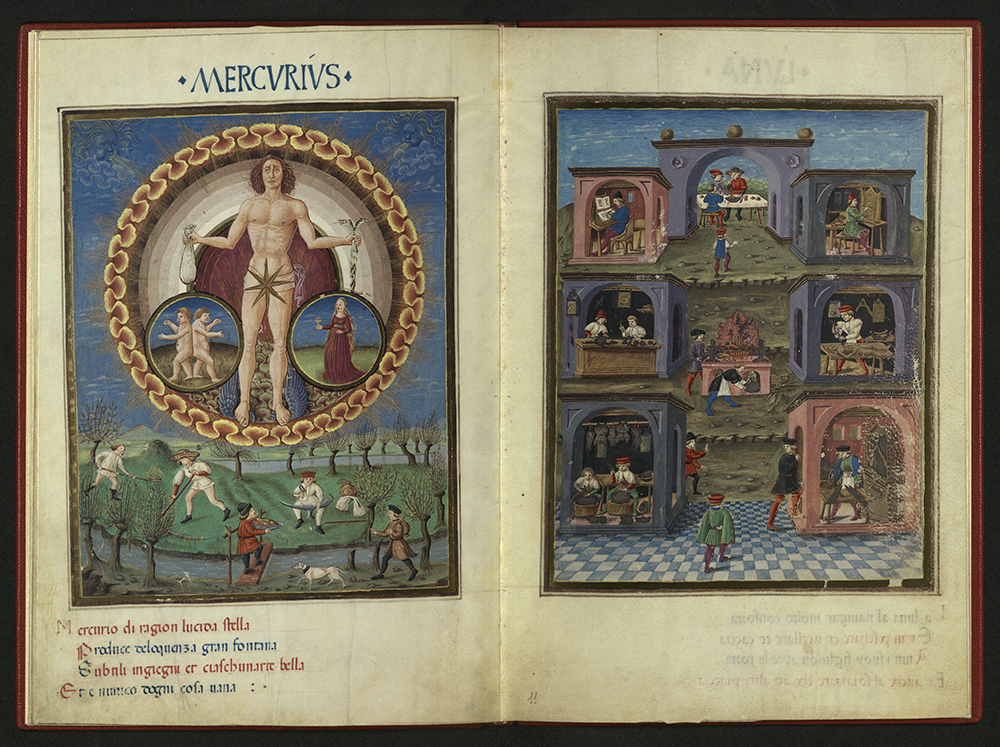
TREATISE ON ASTROLOGY (SPHAERAE COELESTIS ET PLANETARUM DESCRIPTO / SPHAERA ESTENSE)
Fifteenth century
Modena, Biblioteca Estense di Modena, a.X.2.14=Lat.209
Modena: Il Bulino, c. 1995
Edition of 999 copies. Rare Books copy is no. 832
QB26 D47 1995
This treatise on astrology contains astrological and astronomical diagrams, together with fourteen full-page miniatures of the seven planets and depictions of those born under the influence of those planets. Included on folio four of the manuscript are the arms and emblems of Francesco Sforza, Duke of Milan from 1450, and those of his wife, Bianca Visonti, whom he married in 1441. It is believed that the treatise was brought to the Este collection in 1491 as part of the dowry of Ann Sforza, the daughter of Francesco Sforza, upon her marriage to Alfonso I D’Este of Ferrara. The manuscript may have been produced much earlier than that, however, possibly already in the 1450’s.
The exquisite illuminations of this manuscript are beautiful examples of the detailed, colorful renderings of an artist of the Lombard school. The text is minimal, reduced only to a few lines, to accompany each miniature.
Folio 11 (the page on the right of the image above) is of particular interest because of the view it gives of contemporary artists and craftsmen busy at their work. They are the “children” of Mercury. Shown on the left is a scribe writing, clockmakers appear below that, and then armorers. On the right is an organ maker, a sculptor is shown above that, and then on top, a painter working on an altarpiece. In the center are some cooks busy preparing the meal being served to the workers. Painted on the page opposite is a personification of the planet Mercury, shown together with the zodiacal signs Gemini and Virgo. The text at the bottom of the page reads, “Mercury of reason, lucid star,/produces great fountains of eloquence,/subtle genius and everyone [under this planet] is beautiful./And he is the enemy of everything vain.”
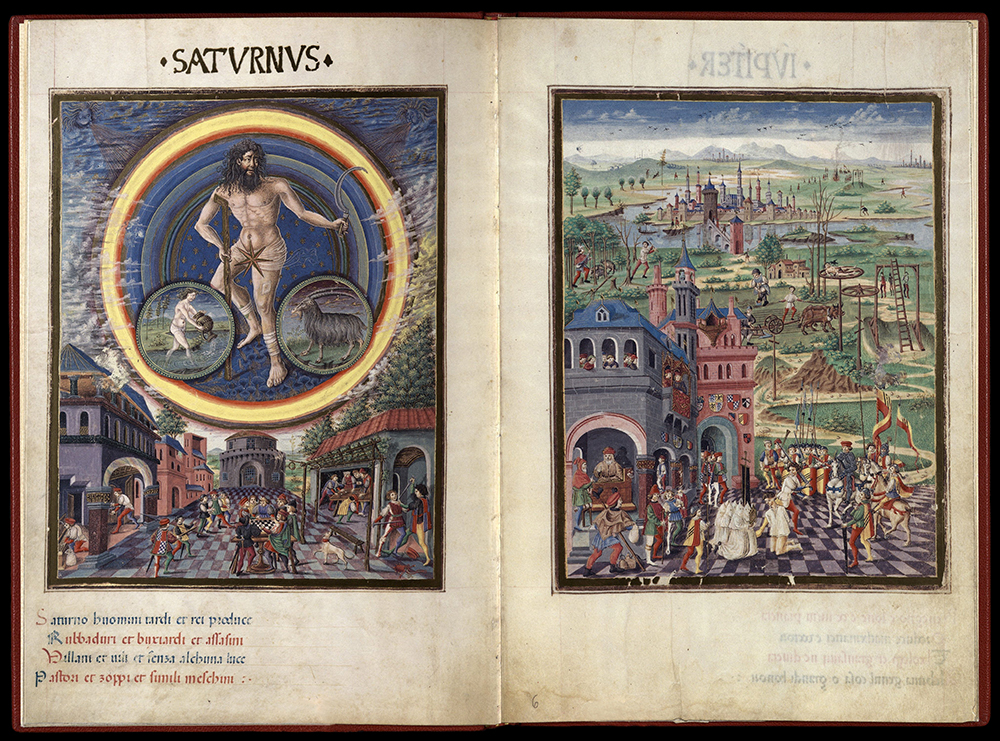
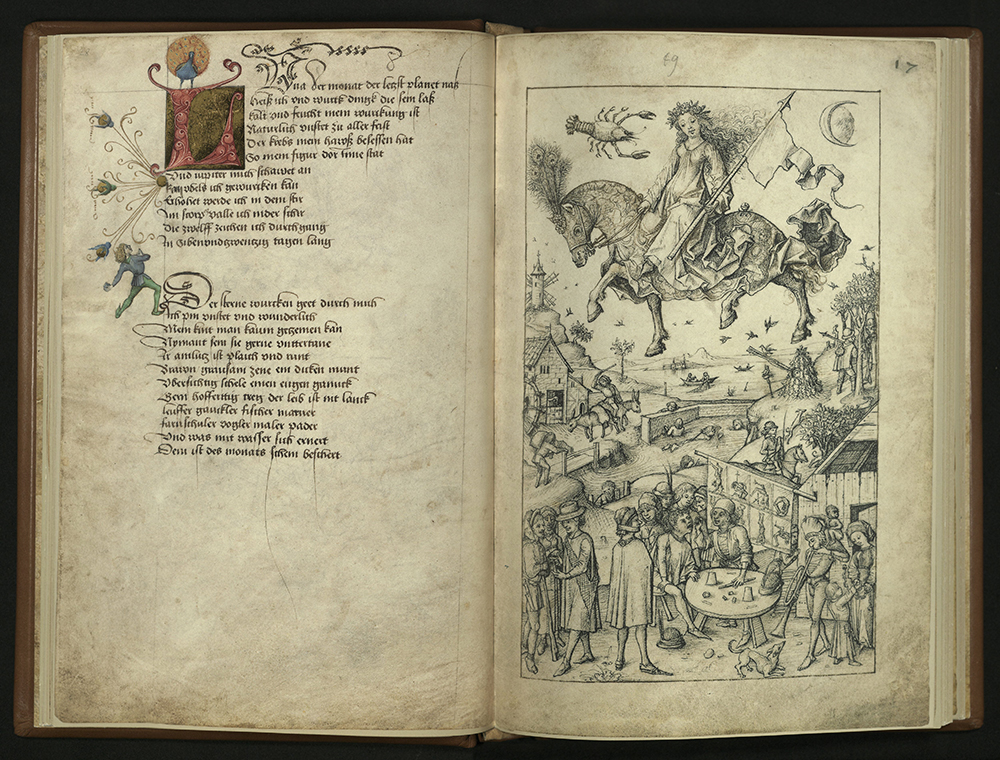
THE MEDIEVAL HOUSEBOOK (DAS MITTELALTERLICHE HAUSBUCH)
Fifteenth century
From the Royal Collection of Waldburg Wolfegg, Muchich
New Yori: Prestel, c. 1997
NE468 A5 M57 1997
The Medieval Housebook is one of the most engaging books ever produced. It is illustrated throughout with vivacious drawings executed in pen and ink, some of them colored with delicate pastel washes, to accompany the various texts included. Those texts concern everything imaginable from health and hygiene to warfare and death. Astronlogy, the art of memory, household management, and animal husbandry are included alongside mining, metallurgy and pyrotechnics. The manuscript has the character of a kind of loosely organized handbook, comparable to the medieval artist’s recipe books, which could be added to and changed as the need arose. The texts are written predominantly in Latin, but some also appear in the vernacular languages, notably German and Italian, as well as Hebrew. The identity of the artist involved in this production has never been uncovered. Whoever it was exercised a far-reaching influence on some of the great artists of the German Renaissance, notably the great Albrecht Dürer.
The drawings are all of high artistic merit. They are each so different from one another in the subjects they treat, and at the same time so full of charm, liveliness and vigor, that it is difficult for any one page of this book to adequately characterize the versatile nature of this artist.
The image above illustrates the “planet” Luna (i.e. the moon), personified as a maid, drawn in pen and ink, together with her “children.” The accompanying text explains that “Luna’s nature is cold and wet.” Her house is Cancer and her children, as illustrated below her figure, tend to be millers and fishermen. They are restless and uncontrollable and can be bird catchers or artists.
